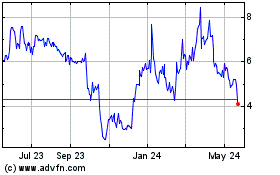0001826457false00018264572024-01-082024-01-08
UNITED STATES
SECURITIES AND EXCHANGE COMMISSION
Washington, D.C. 20549
FORM 8-K
CURRENT REPORT
Pursuant to Section 13 or 15(d)
of the Securities Exchange Act of 1934
Date of Report (Date of earliest event reported): January 8, 2024
MONTE ROSA THERAPEUTICS, INC.
(Exact name of registrant as specified in its charter)
|
|
|
|
|
Delaware |
|
001-40522 |
|
84-3766197 |
(State or other jurisdiction
of incorporation) |
|
(Commission
File Number) |
|
(I.R.S. Employer
Identification No.) |
321 Harrison Avenue, Suite 900
Boston, MA 02118
(Address of principal executive offices, including zip code)
(617) 949-2643
(Registrant’s telephone number, including area code)
Not Applicable
(Former Name or Former Address, if Changed Since Last Report)
Check the appropriate box below if the Form 8-K filing is intended to simultaneously satisfy the filing obligation of the registrant under any of the following provisions:
|
|
☐ |
Written communications pursuant to Rule 425 under the Securities Act (17 CFR 230.425) |
|
|
☐ |
Soliciting material pursuant to Rule 14a-12 under the Exchange Act (17 CFR 240.14a-12) |
|
|
☐ |
Pre-commencement communications pursuant to Rule 14d-2(b) under the Exchange Act (17 CFR 240.14d-2(b)) |
|
|
☐ |
Pre-commencement communications pursuant to Rule 13e-4(c) under the Exchange Act (17 CFR 240.13e-4(c)) |
Securities registered pursuant to Section 12(b) of the Act:
|
|
|
|
|
Title of each class |
|
Trading
Symbol(s) |
|
Name of each exchange
on which registered |
Common Stock, $0.0001 par value per share |
|
GLUE |
|
The Nasdaq Global Select Market |
Indicate by check mark whether the registrant is an emerging growth company as defined in Rule 405 of the Securities Act of 1933 (§ 230.405 of this chapter) or Rule 12b-2 of the Securities Exchange Act of 1934 (§ 240.12b-2 of this chapter).
Emerging growth company ☒
If an emerging growth company, indicate by check mark if the registrant has elected not to use the extended transition period for complying with any new or revised financial accounting standards provided pursuant to Section 13(a) of the Exchange Act. ☐
Item 7.01. Regulation FD Disclosure
On January 8, 2024 Monte Rosa Therapeutics, Inc. issued a press release titled “Monte Rosa Therapeutics Provides Corporate Update and Key Anticipated Milestones for 2024” and provided a corporate update in conjunction with its participation at the 42nd Annual J.P. Morgan Healthcare Conference in San Francisco, CA. The press release and presentation are furnished as Exhibits 99.1 and 99.2, respectively, to this Current Report on Form 8-K.
The information in this Form 8-K (including Exhibits 99.1 and 99.2) shall not be deemed “filed” for purposes of Section 18 of the Securities Exchange Act of 1934, as amended (the “Exchange Act”), or otherwise subject to the liabilities of that section, nor shall it be deemed incorporated by reference in any filing under the Securities Act of 1933, as amended, or the Exchange Act, except as expressly set forth by specific reference in such a filing.
Item 9.01. Financial Statements and Exhibits
(d) Exhibits
SIGNATURE
Pursuant to the requirements of the Securities Exchange Act of 1934, the registrant has duly caused this report to be signed on its behalf by the undersigned hereunto duly authorized.
|
|
|
|
|
|
|
|
|
|
|
|
|
|
|
|
|
|
Monte Rosa Therapeutics, Inc. |
|
|
|
|
Date: January 8, 2024 |
|
|
|
By: |
|
/s/ Markus Warmuth |
|
|
|
|
|
|
Markus Warmuth |
|
|
|
|
|
|
President and Chief Executive Officer |

Monte Rosa Therapeutics Provides Corporate Update and Key Anticipated Milestones for 2024
Phase 1/2 clinical trial of MRT-2359 in MYC-driven solid tumors on track; recommended Phase 2 dose (RP2D) expected in Q2 2024
Received US FDA Fast Track Designation for MRT-2359 for previously treated, metastatic small cell lung cancer with L- or N-MYC expression
MRT-6160, a VAV1-directed MGD, anticipated to initiate Phase 1 study in mid-2024, supporting potential future Phase 2 proof-of-concept studies in multiple autoimmune diseases
Strong cash position expected to fund operations into H1 2026 and enable advancement of pipeline programs through significant early clinical milestones
Company to present at J.P. Morgan Healthcare Conference on Wednesday, January 10, 2024, at 3:00 p.m. PT
BOSTON, Mass., January 8, 2024 - Monte Rosa Therapeutics (Nasdaq: GLUE), a clinical-stage biotechnology company developing novel molecular glue degrader (MGD)-based medicines, today outlined anticipated 2024 milestones ahead of its participation in the 42nd Annual J.P. Morgan Healthcare Conference. The company’s presentation, taking place on Wednesday, January 10, 2024, at 3:00 p.m. PT, will focus on strategic priorities for 2024, including anticipated progress with the ongoing Phase 1/2 clinical trial of MRT-2359 in MYC-driven solid tumors as well as future development plans for MRT-2359 and MRT-6160, its VAV1-directed MGD for autoimmune diseases.
“2023 was an exciting and highlight-filled year for Monte Rosa Therapeutics, including encouraging interim Phase 1/2 MRT-2359 clinical results, advancement of our VAV1-targeted MGD into IND enabling studies, and initiation of a strategic collaboration with Roche,” said Markus Warmuth, M.D., Chief Executive Officer of Monte Rosa Therapeutics. “Building on last year’s successes, this year we look forward to announcing the RP2D for our MRT-2359 program and initiating multiple Phase 2 expansion cohorts in tumors characterized by high L- and N-MYC expression, with the potential to consider indication expansion into c-MYC-driven tumor types such as ER+ breast cancer and castration-resistant prostate cancer. Our highly selective VAV1-directed MGD MRT-6160 is anticipated to enter a Phase 1 healthy volunteer study this year with the aim to move efficiently into early proof-of-concept studies in patients across multiple autoimmune indications. Lastly, we also expect to nominate additional development candidates in 2024 for programs in both oncology and inflammation/immunology. Our strong balance sheet and cash runway into 1H 2026 positions us to advance our programs through important clinical milestones.”

Recap of 2023 Achievements
•Presented interim data from the Phase 1/2 clinical trial of MRT-2359 demonstrating tumor reductions in patients with biomarker-positive cancers and favorable pharmacokinetic (PK), pharmacodynamic (PD), and tolerability profiles.
•Announced development candidate MRT-6160, a VAV1-directed MGD, for the treatment of autoimmune diseases, and presented preclinical data demonstrating that MRT-6160 attenuates autoimmune disease progression.
•Entered into a strategic collaboration and licensing agreement with Roche to discover and develop novel molecular glue degraders targeting cancer and neurological diseases, with a $50 million upfront payment and eligibility to receive future preclinical, clinical, commercial and sales milestone payments exceeding $2 billion, as well as tiered royalties.
Corporate Updates and Key Anticipated Milestones
•Monte Rosa announced today that it has received U.S. Food & Drug Administration Fast Track Designation for MRT-2359 for the treatment of patients with previously treated, metastatic small cell lung cancer (SCLC) with L-MYC or N-MYC expression.
•Monte Rosa expects to announce the RP2D for the MRT-2359 Phase 1/2 clinical trial in MYC-driven solid tumors in Q2 2024. Enrollment is ongoing in backfill cohorts at clinically active doses using a 5 days on drug, 9 days off drug schedule. The Company has simultaneously started dose escalation of higher dose density cohorts using a 21 days on, 7 days off schedule.
•The Company expects to submit an IND for MRT-6160, a VAV1-targeted MGD, in the first half of 2024 and to initiate a Phase 1 single ascending dose / multiple ascending dose study in healthy volunteers in mid-2024.
•The Company expects to nominate a development candidate for the NEK7 preclinical program in Q1 2024.
•The Company expects to nominate a development candidate for the CDK2 preclinical program in 2024.
J.P. Morgan Healthcare Conference Presentation
Dr. Warmuth will present Monte Rosa’s pipeline and business updates during a presentation at the 42nd Annual J.P. Morgan Healthcare Conference on Wednesday, January 10, 2024, at 3:00 p.m. PT. A webcast of the presentation will be accessible via the “Events & Presentations” section of Monte Rosa’s website at ir.monterosatx.com, and an archived version will be made available following the presentation.

About MRT-2359
MRT-2359 is a potent, highly selective and orally bioavailable investigational molecular glue degrader (MGD) that induces the interaction between the E3 ubiquitin ligase component cereblon and the translation termination factor GSPT1, leading to the targeted degradation of GSPT1 protein. The MYC transcription factors (c‑MYC, L-MYC and N-MYC) are well-established drivers of human cancers that maintain high levels of protein translation, which is critical for uncontrolled cell proliferation and tumor growth. Preclinical studies have shown this addiction to MYC-induced protein translation creates a dependency on GSPT1. By inducing degradation of GSPT1, MRT-2359 is designed to exploit this vulnerability, disrupting the protein synthesis machinery, leading to anti-tumor activity in MYC-driven tumors.
About MRT-6160
MRT-6160 is a potent, highly selective, and orally bioavailable investigational molecular glue degrader of VAV1, which in our in vitro studies has shown deep degradation of its target with no detectable effects on other proteins. VAV1, a Rho-family guanine nucleotide exchange factor, is a key signaling protein downstream of both the T-and B-cell receptors. VAV1 expression is restricted to blood and immune cells, including T and B cells. Preclinical studies have shown that targeted degradation of VAV1 protein via an MGD modulates both T- and B-cell receptor-mediated activity. This modulation is evident both in vitro and in vivo, demonstrated by a significant decrease in cytokine secretion, proteins vital for maintaining autoimmune diseases. Moreover, VAV1-directed MGDs have shown promising activity in preclinical models of autoimmune diseases and thus have the potential to provide therapeutic benefits in multiple autoimmune indications, such as multiple sclerosis, rheumatoid arthritis, and dermatological disorders. Preclinical studies demonstrate MRT-6160 inhibits disease progression in in vivo autoimmunity models.
About Monte Rosa
Monte Rosa Therapeutics is a clinical-stage biotechnology company developing highly selective molecular glue degrader (MGD) medicines for patients living with serious diseases in the areas of oncology, autoimmune and inflammatory diseases, and more. MGDs are small molecule protein degraders that have the potential to treat many diseases that other modalities, including other degraders, cannot. Monta Rosa’s QuEEN™ (Quantitative and Engineered Elimination of Neosubstrates) discovery engine combines AI-guided chemistry, diverse chemical libraries, structural biology and proteomics to identify degradable protein targets and rationally design MGDs with unprecedented selectivity. The QuEEN discovery engine enables access to a wide-ranging and differentiated target space of well-validated biology across multiple therapeutic areas. Monte Rosa has developed the industry’s leading pipeline of MGDs, which spans oncology, autoimmune and inflammatory disease and beyond, and has a strategic collaboration with Roche to discover and develop MGDs against targets in cancer and neurological diseases previously considered impossible to drug. For more information, visit www.monterosatx.com.

Forward-Looking Statements
This communication includes express and implied “forward-looking statements,” including forward-looking statements within the meaning of the Private Securities Litigation Reform Act of 1995. Forward-looking statements include all statements that are not historical facts and in some cases, can be identified by terms such as “may,” “might,” “will,” “could,” “would,” “should,” “expect,” “intend,” “plan,” “objective,” “anticipate,” “believe,” “estimate,” “predict,” “potential,” “continue,” “ongoing,” or the negative of these terms, or other comparable terminology intended to identify statements about the future. Forward-looking statements contained herein include, but are not limited to, statements about our product development activities, our ongoing clinical development of our GSPT1 degrader referred to as MRT-2359, including our expectations for the nature, significance, and timing for our disclosure of any data from our Phase 1/2 clinical trial of MRT-2359 in MYC-driven solid tumors, timing for our identification and any disclosure of a recommended phase 2 dose for MRT-2359, statements about the advancement of our preclinical programs, pipeline and the various products therein, including the ongoing development of our VAV1-directed degrader, referred to as MRT-6160, and the planned submission of an IND to the FDA for MRT-6160 in the first half of 2024, and the timing of our planned phase 1 healthy volunteer study and early proof-of-concept studies in patients across multiple autoimmune indications, our expectations regarding the potential clinical benefit for this program and our expectations of timings for the program, statements around the advancement and application of our pipeline, including identification and the timing thereof of a development candidate for NEK7 and a development candidate for CDK2, statements around the advancement and application of our platform, and statements concerning our expectations regarding our ability to nominate and the timing of our nominations of additional targets, product candidates, and development candidates, as well as our expectations of success for our programs and the strength of our financial position, among others. By their nature, these statements are subject to numerous risks and uncertainties, including those risks and uncertainties set forth in our most recent Annual Report on Form 10-K for the year ended December 31, 2023, filed with the U.S. Securities and Exchange Commission on March 16, 2023, and any subsequent filings, that could cause actual results, performance or achievement to differ materially and adversely from those anticipated or implied in the statements. You should not rely upon forward-looking statements as predictions of future events. Although our management believes that the expectations reflected in our statements are reasonable, we cannot guarantee that the future results, performance, or events and circumstances described in the forward-looking statements will be achieved or occur. Recipients are cautioned not to place undue reliance on these forward-looking statements, which speak only as of the date such statements are made and should not be construed as statements of fact. We undertake no obligation to publicly update any forward-looking statements, whether as a result of new information, any future presentations, or otherwise, except as required by applicable law. Certain information contained in these materials and any statements made orally during any presentation of these materials that relate to the materials or are based on studies, publications, surveys and other data obtained from third-party sources and our own internal estimates and research. While we believe these third-party studies,

publications, surveys and other data to be reliable as of the date of these materials, we have not independently verified, and make no representations as to the adequacy, fairness, accuracy or completeness of, any information obtained from third-party sources. In addition, no independent source has evaluated the reasonableness or accuracy of our internal estimates or research and no reliance should be made on any information or statements made in these materials relating to or based on such internal estimates and research.
Investors
Andrew Funderburk, Kendall IR
ir@monterosatx.com
Media
Cory Tromblee, Scient PR
media@monterosatx.com

From Serendipity to Rational Design Taking Molecular Glue Degraders to New Heights | January 2024
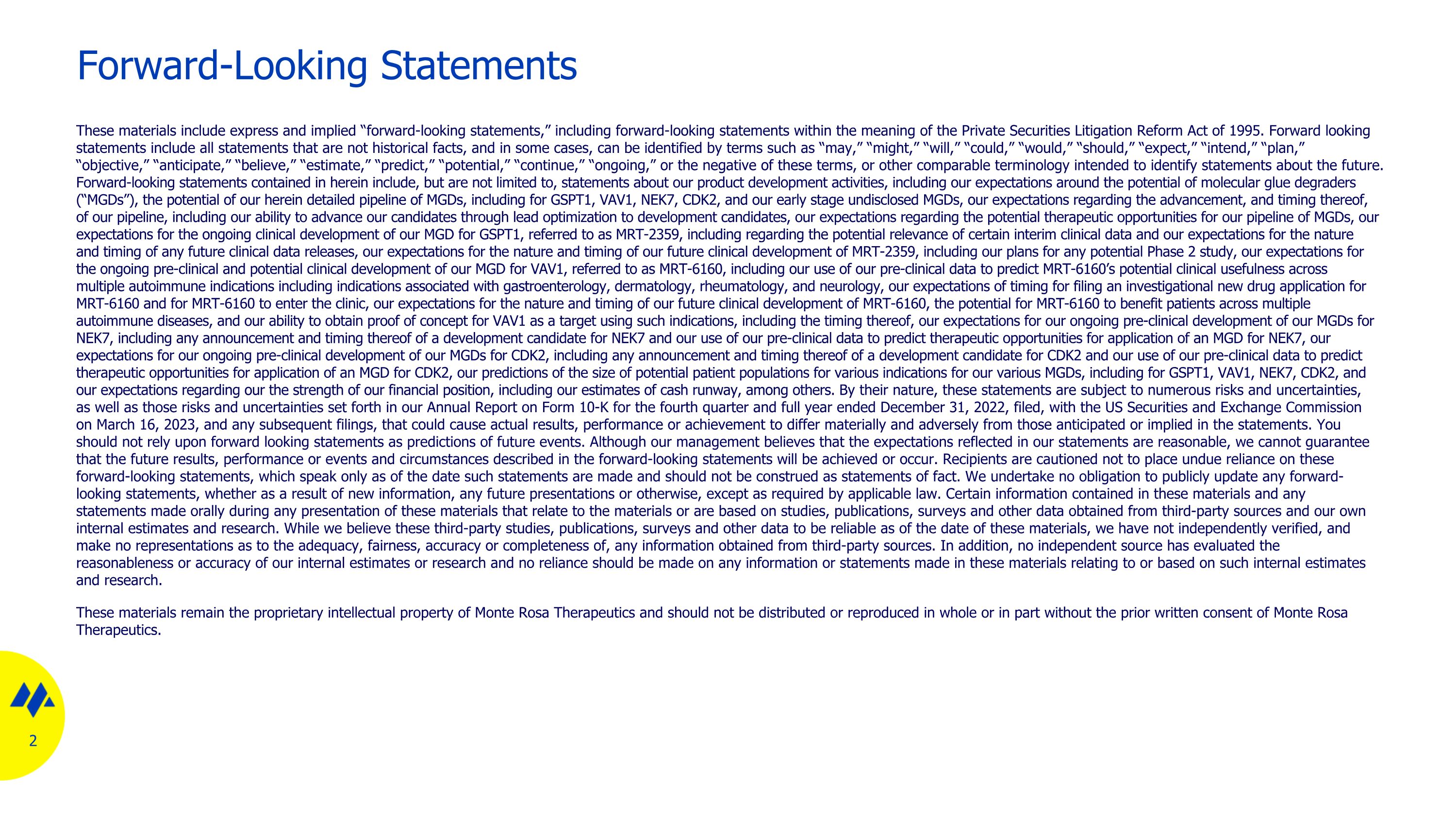
Forward-Looking Statements These materials include express and implied “forward-looking statements,” including forward-looking statements within the meaning of the Private Securities Litigation Reform Act of 1995. Forward looking statements include all statements that are not historical facts, and in some cases, can be identified by terms such as “may,” “might,” “will,” “could,” “would,” “should,” “expect,” “intend,” “plan,” “objective,” “anticipate,” “believe,” “estimate,” “predict,” “potential,” “continue,” “ongoing,” or the negative of these terms, or other comparable terminology intended to identify statements about the future. Forward-looking statements contained in herein include, but are not limited to, statements about our product development activities, including our expectations around the potential of molecular glue degraders (“MGDs”), the potential of our herein detailed pipeline of MGDs, including for GSPT1, VAV1, NEK7, CDK2, and our early stage undisclosed MGDs, our expectations regarding the advancement, and timing thereof, of our pipeline, including our ability to advance our candidates through lead optimization to development candidates, our expectations regarding the potential therapeutic opportunities for our pipeline of MGDs, our expectations for the ongoing clinical development of our MGD for GSPT1, referred to as MRT-2359, including regarding the potential relevance of certain interim clinical data and our expectations for the nature and timing of any future clinical data releases, our expectations for the nature and timing of our future clinical development of MRT-2359, including our plans for any potential Phase 2 study, our expectations for the ongoing pre-clinical and potential clinical development of our MGD for VAV1, referred to as MRT-6160, including our use of our pre-clinical data to predict MRT-6160’s potential clinical usefulness across multiple autoimmune indications including indications associated with gastroenterology, dermatology, rheumatology, and neurology, our expectations of timing for filing an investigational new drug application for MRT-6160 and for MRT-6160 to enter the clinic, our expectations for the nature and timing of our future clinical development of MRT-6160, the potential for MRT-6160 to benefit patients across multiple autoimmune diseases, and our ability to obtain proof of concept for VAV1 as a target using such indications, including the timing thereof, our expectations for our ongoing pre-clinical development of our MGDs for NEK7, including any announcement and timing thereof of a development candidate for NEK7 and our use of our pre-clinical data to predict therapeutic opportunities for application of an MGD for NEK7, our expectations for our ongoing pre-clinical development of our MGDs for CDK2, including any announcement and timing thereof of a development candidate for CDK2 and our use of our pre-clinical data to predict therapeutic opportunities for application of an MGD for CDK2, our predictions of the size of potential patient populations for various indications for our various MGDs, including for GSPT1, VAV1, NEK7, CDK2, and our expectations regarding our the strength of our financial position, including our estimates of cash runway, among others. By their nature, these statements are subject to numerous risks and uncertainties, as well as those risks and uncertainties set forth in our Annual Report on Form 10-K for the fourth quarter and full year ended December 31, 2022, filed, with the US Securities and Exchange Commission on March 16, 2023, and any subsequent filings, that could cause actual results, performance or achievement to differ materially and adversely from those anticipated or implied in the statements. You should not rely upon forward looking statements as predictions of future events. Although our management believes that the expectations reflected in our statements are reasonable, we cannot guarantee that the future results, performance or events and circumstances described in the forward-looking statements will be achieved or occur. Recipients are cautioned not to place undue reliance on these forward-looking statements, which speak only as of the date such statements are made and should not be construed as statements of fact. We undertake no obligation to publicly update any forward-looking statements, whether as a result of new information, any future presentations or otherwise, except as required by applicable law. Certain information contained in these materials and any statements made orally during any presentation of these materials that relate to the materials or are based on studies, publications, surveys and other data obtained from third-party sources and our own internal estimates and research. While we believe these third-party studies, publications, surveys and other data to be reliable as of the date of these materials, we have not independently verified, and make no representations as to the adequacy, fairness, accuracy or completeness of, any information obtained from third-party sources. In addition, no independent source has evaluated the reasonableness or accuracy of our internal estimates or research and no reliance should be made on any information or statements made in these materials relating to or based on such internal estimates and research. These materials remain the proprietary intellectual property of Monte Rosa Therapeutics and should not be distributed or reproduced in whole or in part without the prior written consent of Monte Rosa Therapeutics.
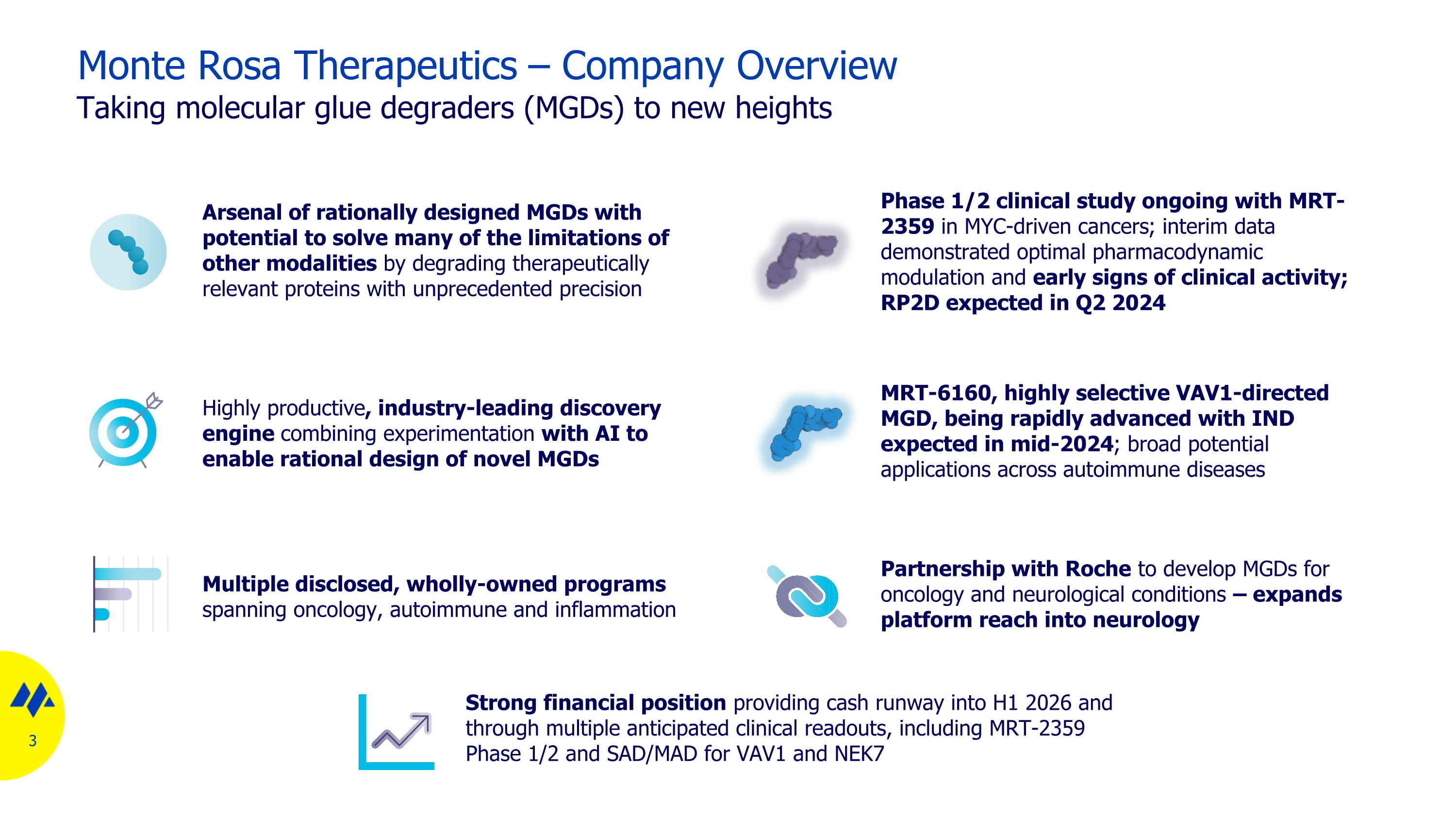
Monte Rosa Therapeutics – Company Overview Taking molecular glue degraders (MGDs) to new heights Arsenal of rationally designed MGDs with potential to solve many of the limitations of other modalities by degrading therapeutically relevant proteins with unprecedented precision Highly productive, industry-leading discovery engine combining experimentation with AI to enable rational design of novel MGDs Multiple disclosed, wholly-owned programs spanning oncology, autoimmune and inflammation Strong financial position providing cash runway into H1 2026 and through multiple anticipated clinical readouts, including MRT-2359 Phase 1/2 and SAD/MAD for VAV1 and NEK7 Phase 1/2 clinical study ongoing with MRT-2359 in MYC-driven cancers; interim data demonstrated optimal pharmacodynamic modulation and early signs of clinical activity; RP2D expected in Q2 2024 Partnership with Roche to develop MGDs for oncology and neurological conditions – expands platform reach into neurology MRT-6160, highly selective VAV1-directed MGD, being rapidly advanced with IND expected in mid-2024; broad potential applications across autoimmune diseases
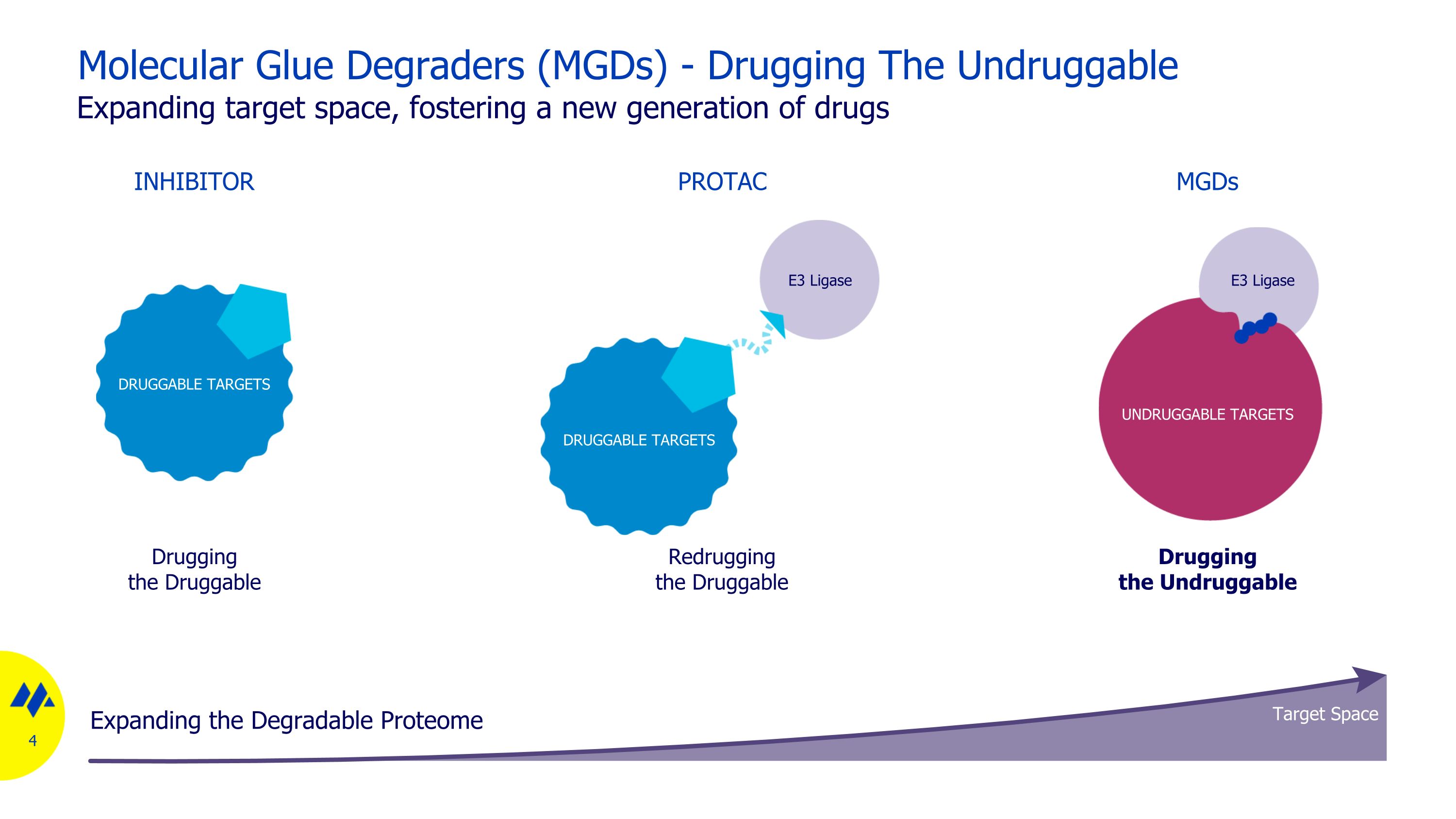
Molecular Glue Degraders (MGDs) - Drugging The Undruggable Expanding target space, fostering a new generation of drugs Drugging the Druggable INHIBITOR Drugging the Undruggable MGDs Redrugging the Druggable PROTAC UNDRUGGABLE TARGETS E3 Ligase DRUGGABLE TARGETS E3 Ligase DRUGGABLE TARGETS Target Space Expanding the Degradable Proteome
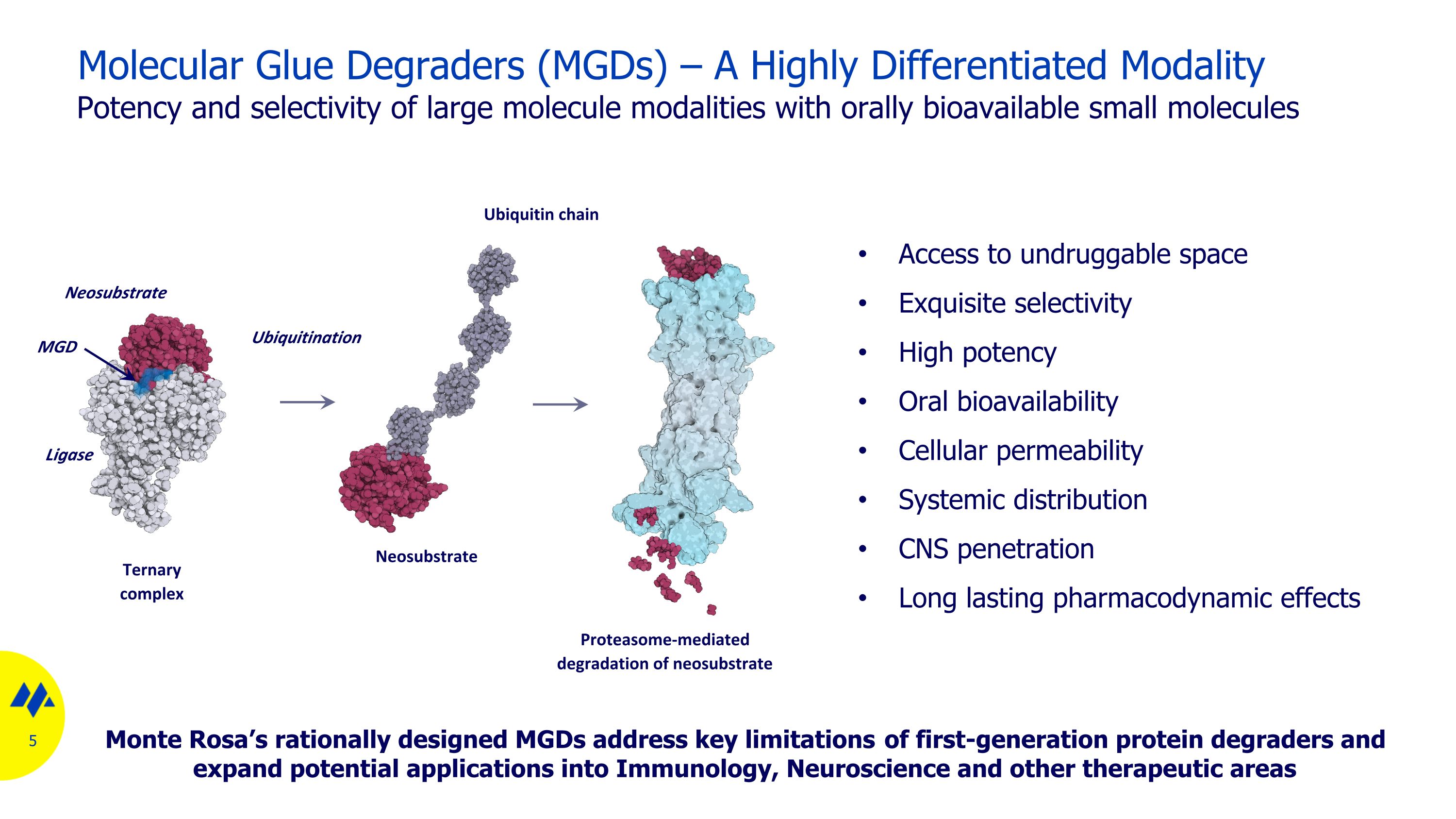
Access to undruggable space Exquisite selectivity High potency Oral bioavailability Cellular permeability Systemic distribution CNS penetration Long lasting pharmacodynamic effects Monte Rosa’s rationally designed MGDs address key limitations of first-generation protein degraders and expand potential applications into Immunology, Neuroscience and other therapeutic areas Molecular Glue Degraders (MGDs) – A Highly Differentiated Modality Potency and selectivity of large molecule modalities with orally bioavailable small molecules Ternary complex Ubiquitination Proteasome-mediated degradation of neosubstrate Ubiquitin chain Neosubstrate Ligase Neosubstrate MGD
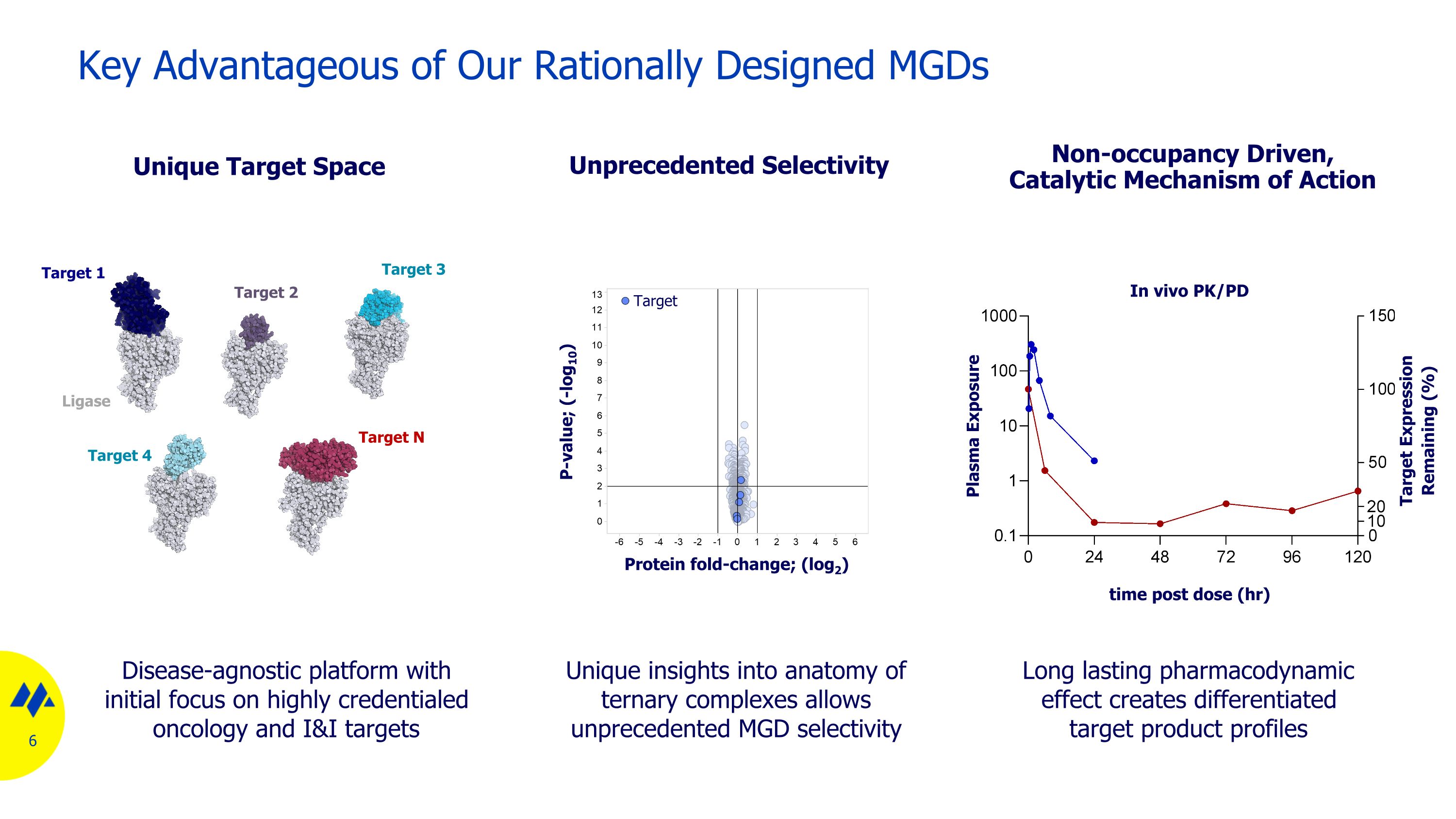
Key Advantageous of Our Rationally Designed MGDs Unique insights into anatomy of ternary complexes allows unprecedented MGD selectivity Unprecedented Selectivity Protein fold-change; (log2) Disease-agnostic platform with initial focus on highly credentialed oncology and I&I targets Unique Target Space Target 1 Target 3 Target 2 Target 4 Target N Ligase Long lasting pharmacodynamic effect creates differentiated target product profiles Non-occupancy Driven, Catalytic Mechanism of Action P-value; (-log10) Plasma Exposure Target Expression Remaining (%) Target In vivo PK/PD time post dose (hr)
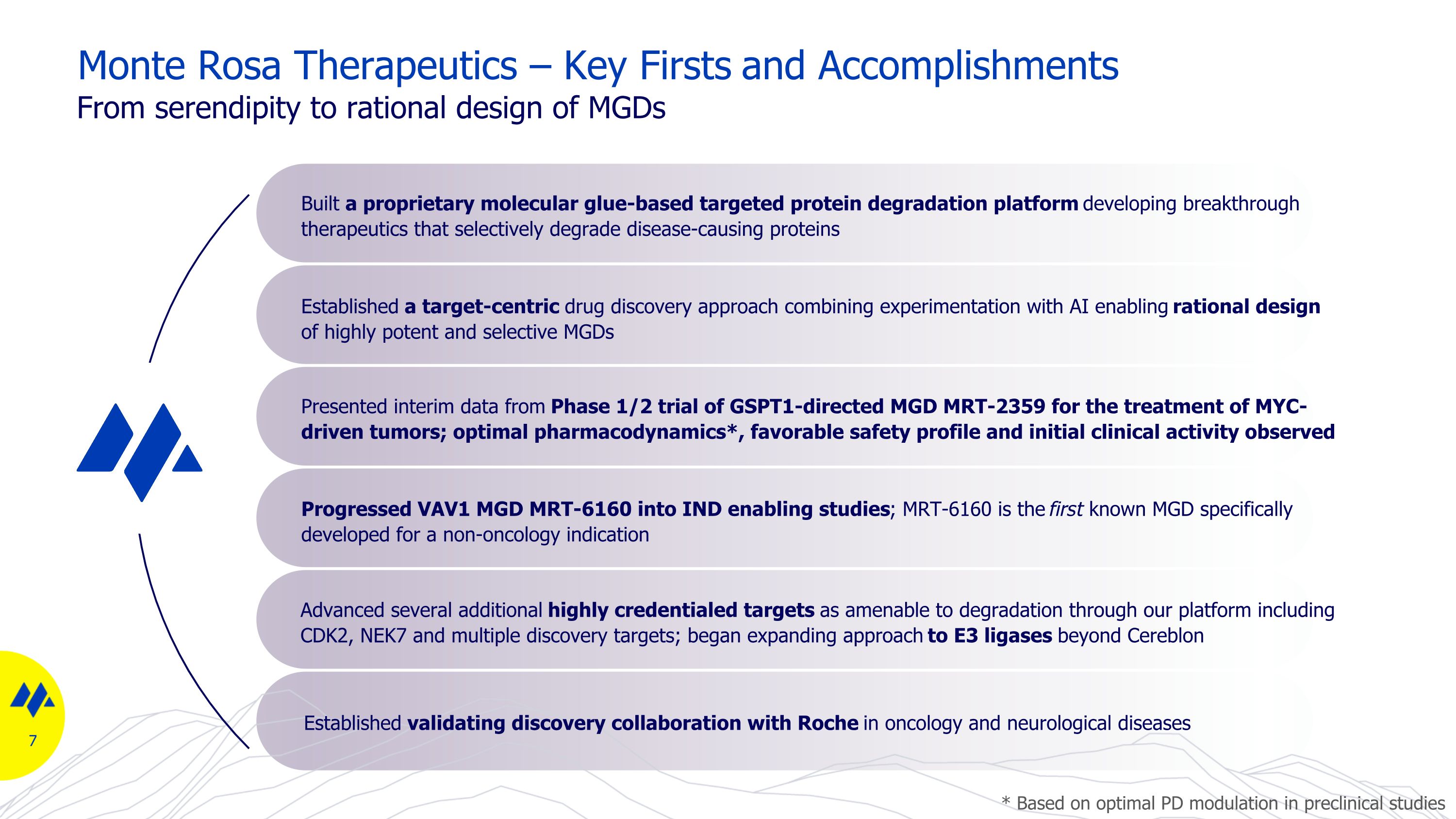
Monte Rosa Therapeutics – Key Firsts and Accomplishments From serendipity to rational design of MGDs Established a target-centric drug discovery approach combining experimentation with AI enabling rational design of highly potent and selective MGDs Progressed VAV1 MGD MRT-6160 into IND enabling studies; MRT-6160 is the first known MGD specifically developed for a non-oncology indication Built a proprietary molecular glue-based targeted protein degradation platform developing breakthrough therapeutics that selectively degrade disease-causing proteins Advanced several additional highly credentialed targets as amenable to degradation through our platform including CDK2, NEK7 and multiple discovery targets; began expanding approach to E3 ligases beyond Cereblon Presented interim data from Phase 1/2 trial of GSPT1-directed MGD MRT-2359 for the treatment of MYC-driven tumors; optimal pharmacodynamics*, favorable safety profile and initial clinical activity observed Established validating discovery collaboration with Roche in oncology and neurological diseases * Based on optimal PD modulation in preclinical studies

Portfolio
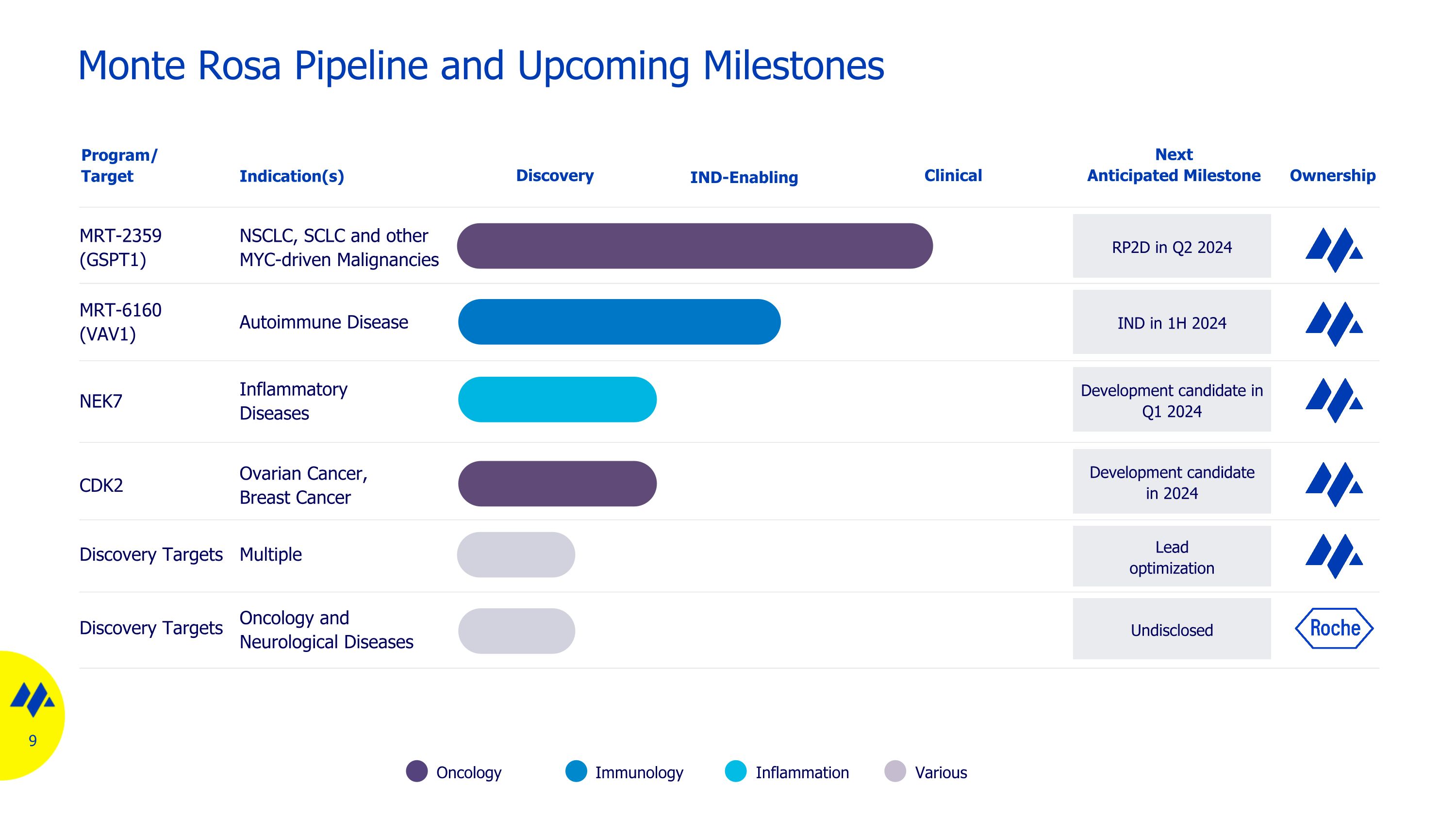
Monte Rosa Pipeline and Upcoming Milestones Oncology Inflammation Immunology Various MRT-2359 (GSPT1) NSCLC, SCLC and other MYC-driven Malignancies NEK7 Inflammatory Diseases MRT-6160 (VAV1) Autoimmune Disease Discovery Program/ Target Indication(s) RP2D in Q2 2024 Next Anticipated Milestone Ownership Discovery Targets Multiple IND-Enabling Clinical Lead optimization Development candidate in Q1 2024 CDK2 Ovarian Cancer, Breast Cancer IND in 1H 2024 Discovery Targets Oncology and Neurological Diseases Undisclosed Development candidate in 2024

GSPT1 program
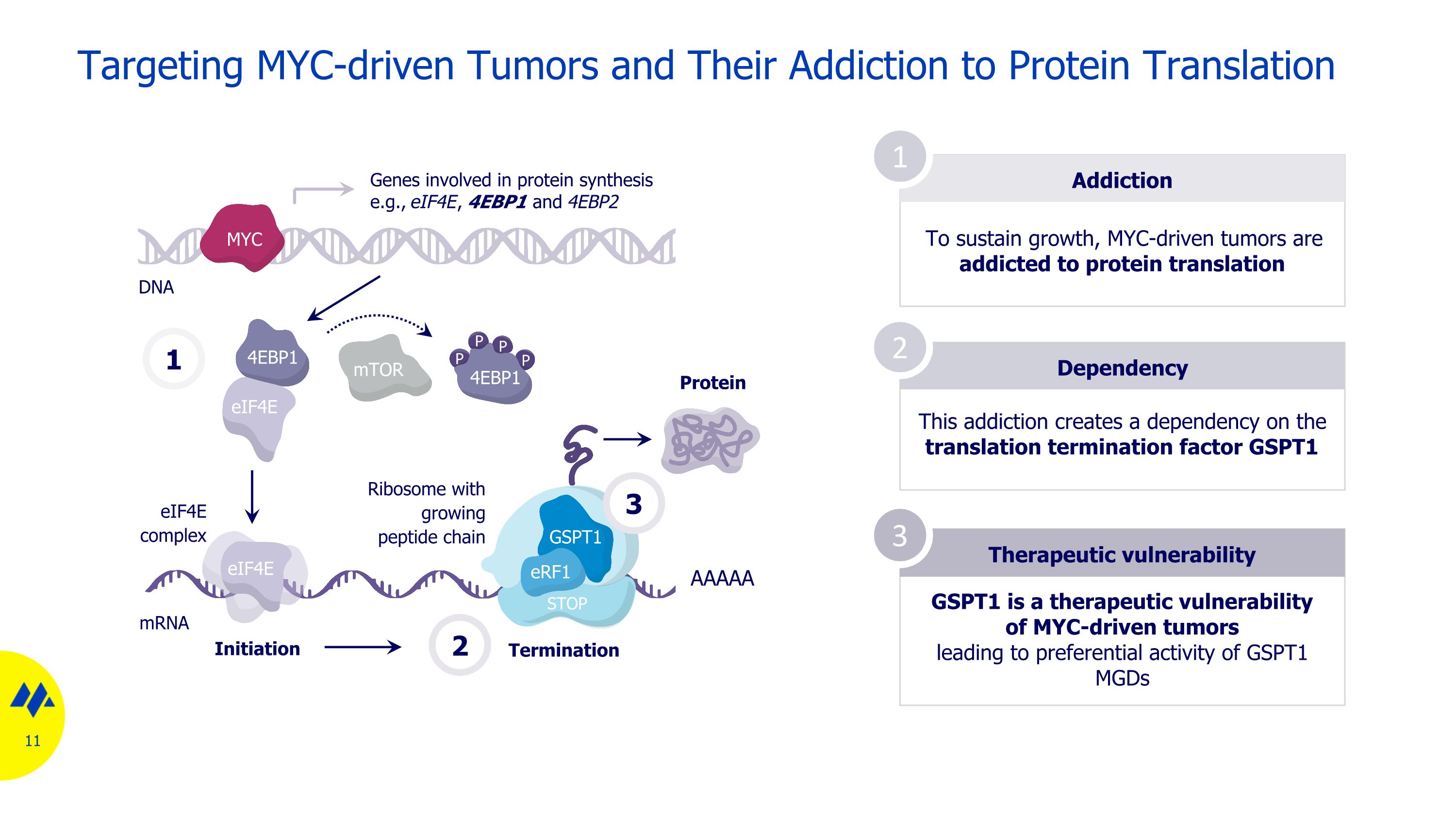
Targeting MYC-driven Tumors and Their Addiction to Protein Translation Addiction To sustain growth, MYC-driven tumors are addicted to protein translation Dependency Therapeutic vulnerability 1 2 3 This addiction creates a dependency on the translation termination factor GSPT1 GSPT1 is a therapeutic vulnerability of MYC-driven tumors leading to preferential activity of GSPT1 MGDs mRNA DNA 1 mTOR eIF4E 4EBP1 P P P P 4EBP1 eIF4E eIF4E complex Genes involved in protein synthesis e.g., eIF4E, 4EBP1 and 4EBP2 Initiation Termination AAAAA Protein 2 MYC STOP GSPT1 eRF1 Ribosome with growing peptide chain 3
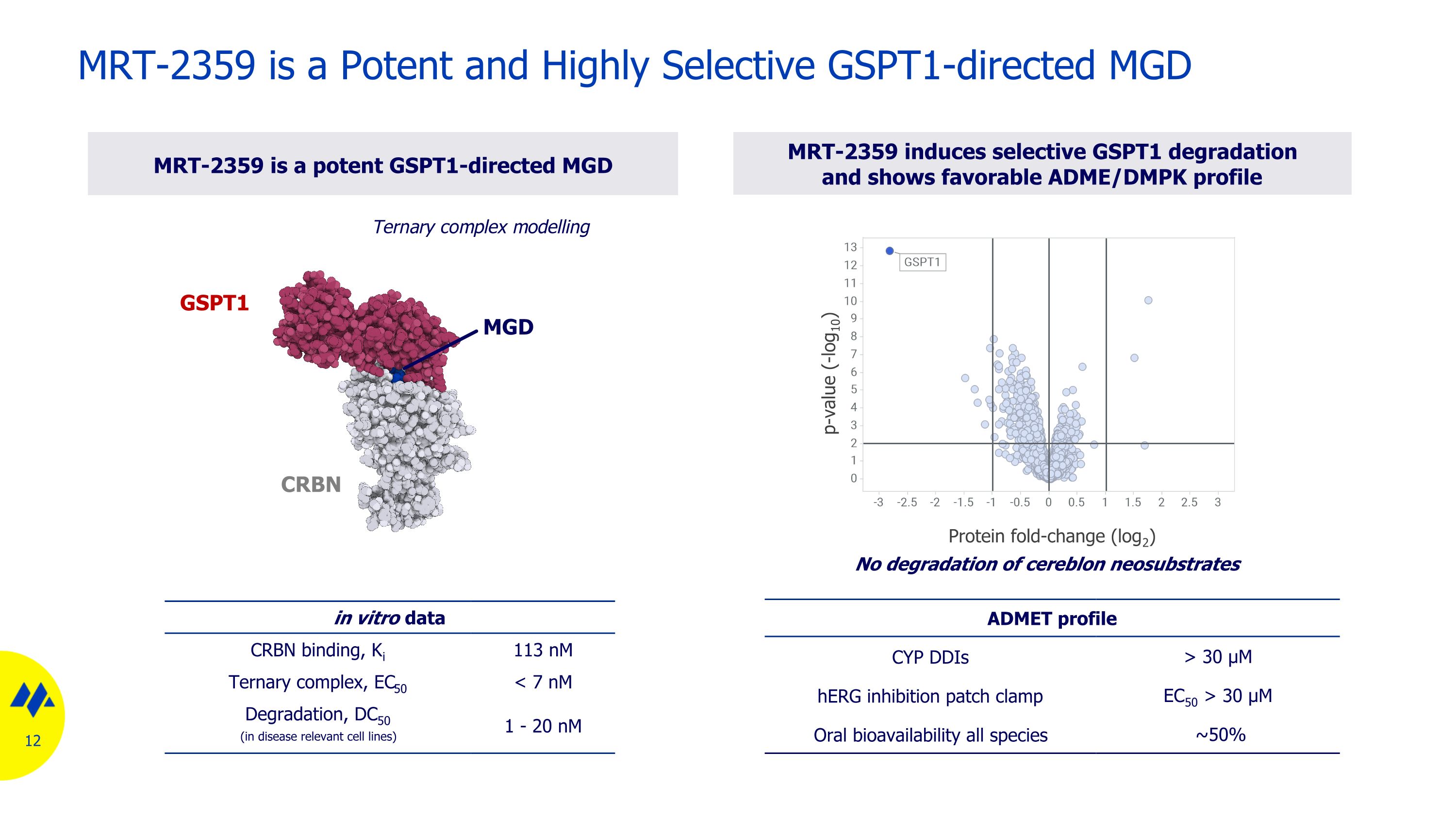
MRT-2359 is a Potent and Highly Selective GSPT1-directed MGD in vitro data CRBN binding, Ki 113 nM Ternary complex, EC50 < 7 nM Degradation, DC50 (in disease relevant cell lines) 1 - 20 nM MRT-2359 induces selective GSPT1 degradation and shows favorable ADME/DMPK profile MRT-2359 is a potent GSPT1-directed MGD ADMET profile CYP DDIs > 30 µM hERG inhibition patch clamp EC50 > 30 µM Oral bioavailability all species ~50% Ternary complex modelling GSPT1 CRBN MGD No degradation of cereblon neosubstrates Protein fold-change (log2) p-value (-log10)
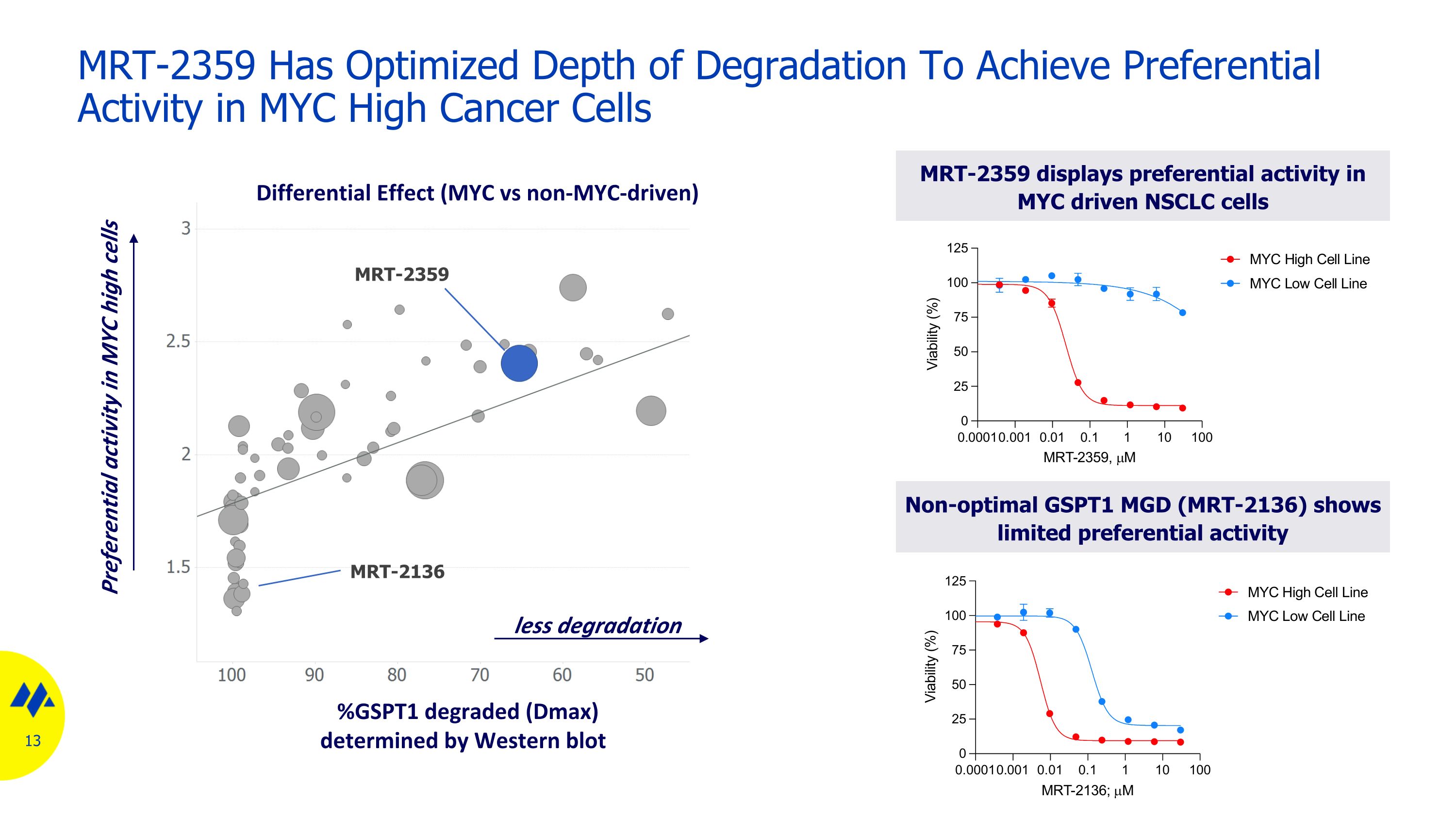
MRT-2359 Has Optimized Depth of Degradation To Achieve Preferential Activity in MYC High Cancer Cells %GSPT1 degraded (Dmax) determined by Western blot Differential Effect (MYC vs non-MYC-driven) less degradation Preferential activity in MYC high cells MRT-2359 MRT-2136 MRT-2359 displays preferential activity in MYC driven NSCLC cells Non-optimal GSPT1 MGD (MRT-2136) shows limited preferential activity
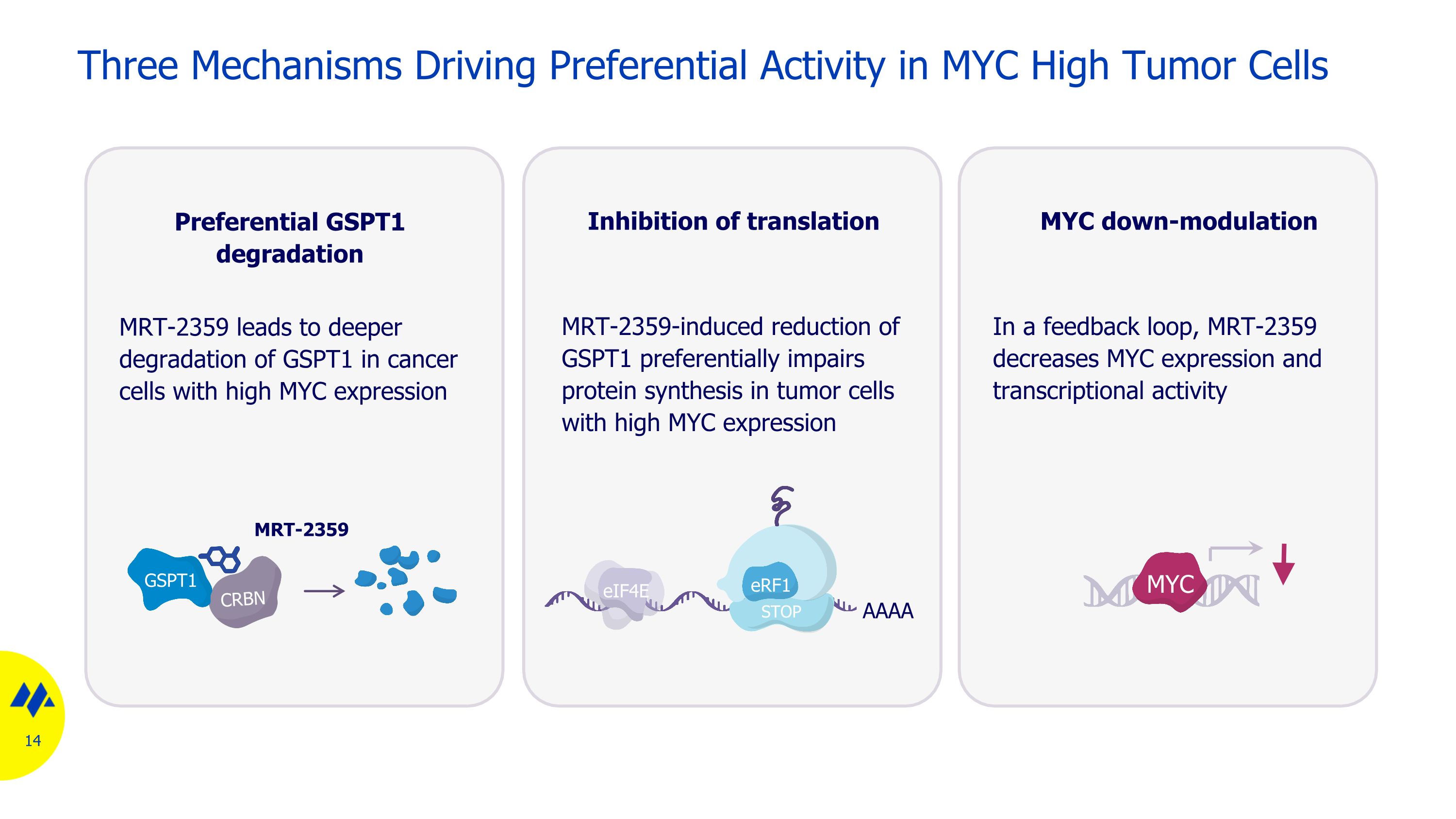
Three Mechanisms Driving Preferential Activity in MYC High Tumor Cells MRT-2359 CRBN GSPT1 Preferential GSPT1 degradation MRT-2359 leads to deeper degradation of GSPT1 in cancer cells with high MYC expression Inhibition of translation MRT-2359-induced reduction of GSPT1 preferentially impairs protein synthesis in tumor cells with high MYC expression eIF4E AAAA STOP eRF1 MYC down-modulation In a feedback loop, MRT-2359 decreases MYC expression and transcriptional activity MYC
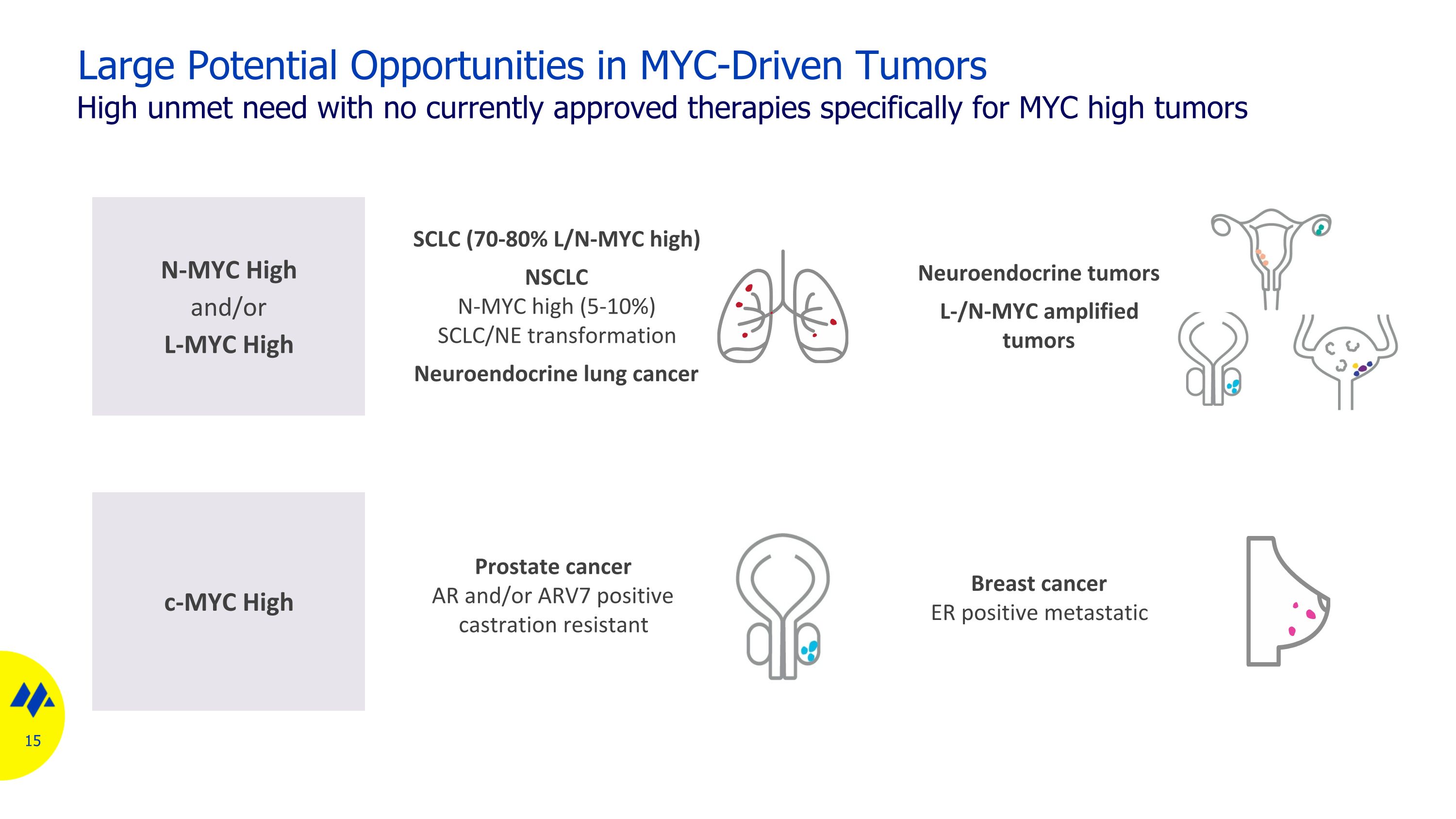
Large Potential Opportunities in MYC-Driven Tumors High unmet need with no currently approved therapies specifically for MYC high tumors N-MYC High and/or L-MYC High Neuroendocrine tumors L-/N-MYC amplified tumors c-MYC High Heme Breast cancer ER positive metastatic SCLC (70-80% L/N-MYC high) NSCLC N-MYC high (5-10%) SCLC/NE transformation Neuroendocrine lung cancer Prostate cancer AR and/or ARV7 positive castration resistant
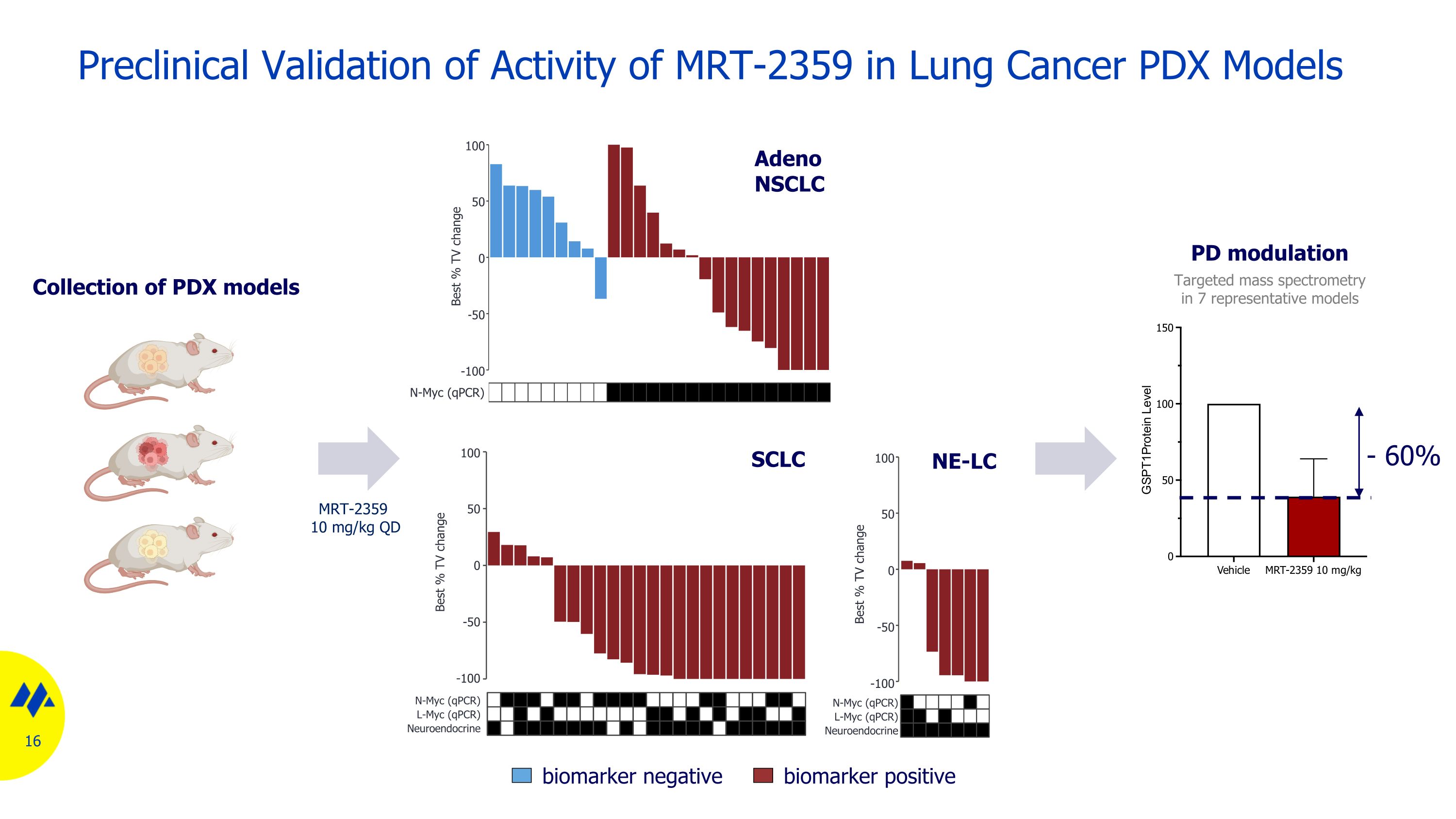
Preclinical Validation of Activity of MRT-2359 in Lung Cancer PDX Models Collection of PDX models 16 SCLC Adeno NSCLC NE-LC biomarker negative biomarker positive Targeted mass spectrometry in 7 representative models PD modulation 100 50 0 -50 -100 N-Myc (qPCR) Best % TV change 100 50 0 -50 -100 N-Myc (qPCR) Best % TV change L-Myc (qPCR) Neuroendocrine 100 50 0 -50 -100 N-Myc (qPCR) Best % TV change L-Myc (qPCR) Neuroendocrine MRT-2359 10 mg/kg QD - 60%
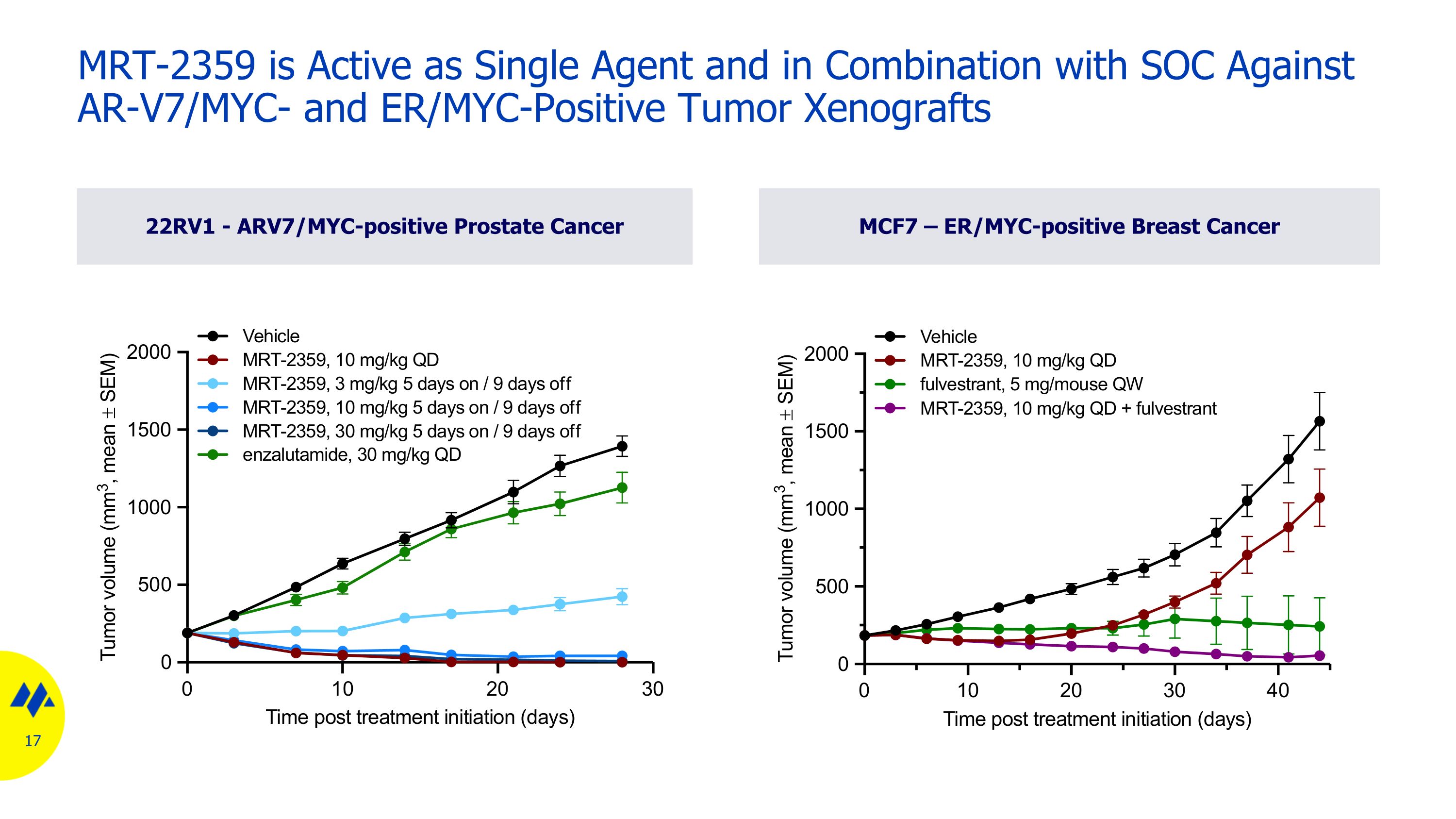
22RV1 - ARV7/MYC-positive Prostate Cancer MCF7 – ER/MYC-positive Breast Cancer MRT-2359 is Active as Single Agent and in Combination with SOC Against AR-V7/MYC- and ER/MYC-Positive Tumor Xenografts
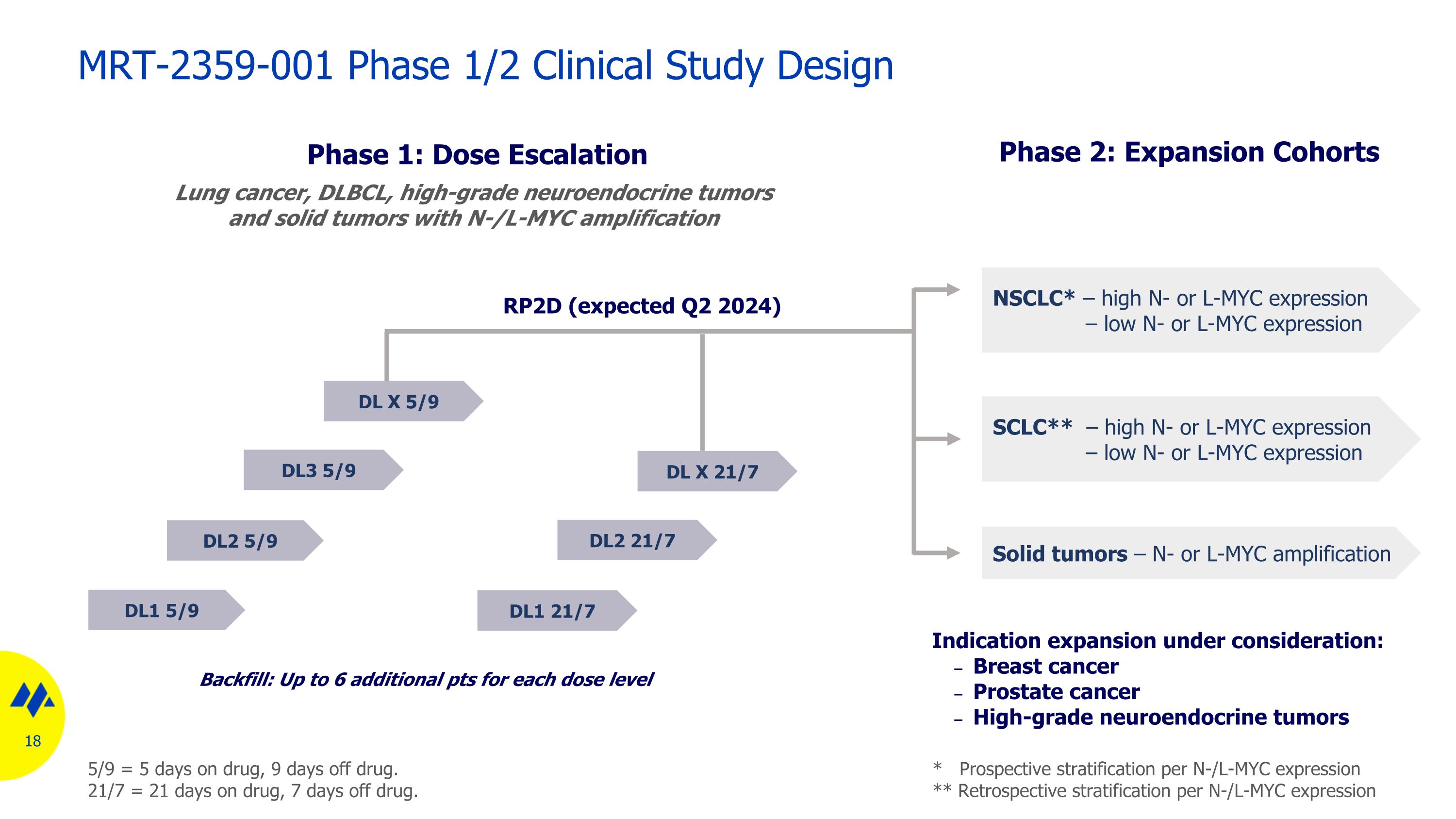
DL1 5/9 Phase 2: Expansion Cohorts Phase 1: Dose Escalation DL3 5/9 DL2 5/9 * Prospective stratification per N-/L-MYC expression ** Retrospective stratification per N-/L-MYC expression MRT-2359-001 Phase 1/2 Clinical Study Design Lung cancer, DLBCL, high-grade neuroendocrine tumors and solid tumors with N-/L-MYC amplification Backfill: Up to 6 additional pts for each dose level DL X 21/7 DL X 5/9 5/9 = 5 days on drug, 9 days off drug. 21/7 = 21 days on drug, 7 days off drug. RP2D (expected Q2 2024) DL1 21/7 NSCLC* – high N- or L-MYC expression – low N- or L-MYC expression Solid tumors – N- or L-MYC amplification SCLC** – high N- or L-MYC expression – low N- or L-MYC expression Indication expansion under consideration: Breast cancer Prostate cancer High-grade neuroendocrine tumors 18 DL2 21/7
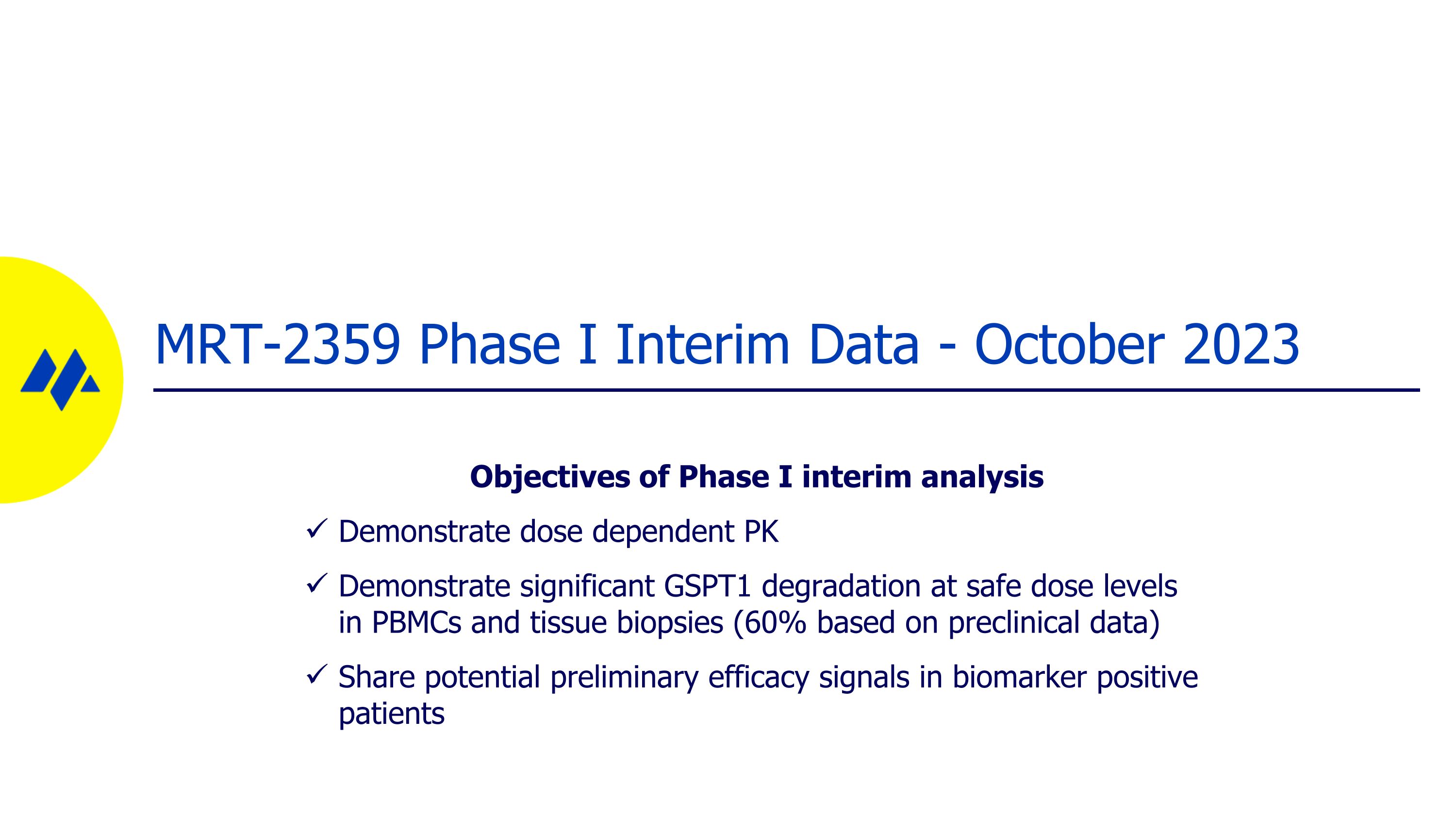
MRT-2359 Phase I Interim Data - October 2023 Objectives of Phase I interim analysis Demonstrate dose dependent PK Demonstrate significant GSPT1 degradation at safe dose levels in PBMCs and tissue biopsies (60% based on preclinical data) Share potential preliminary efficacy signals in biomarker positive patients
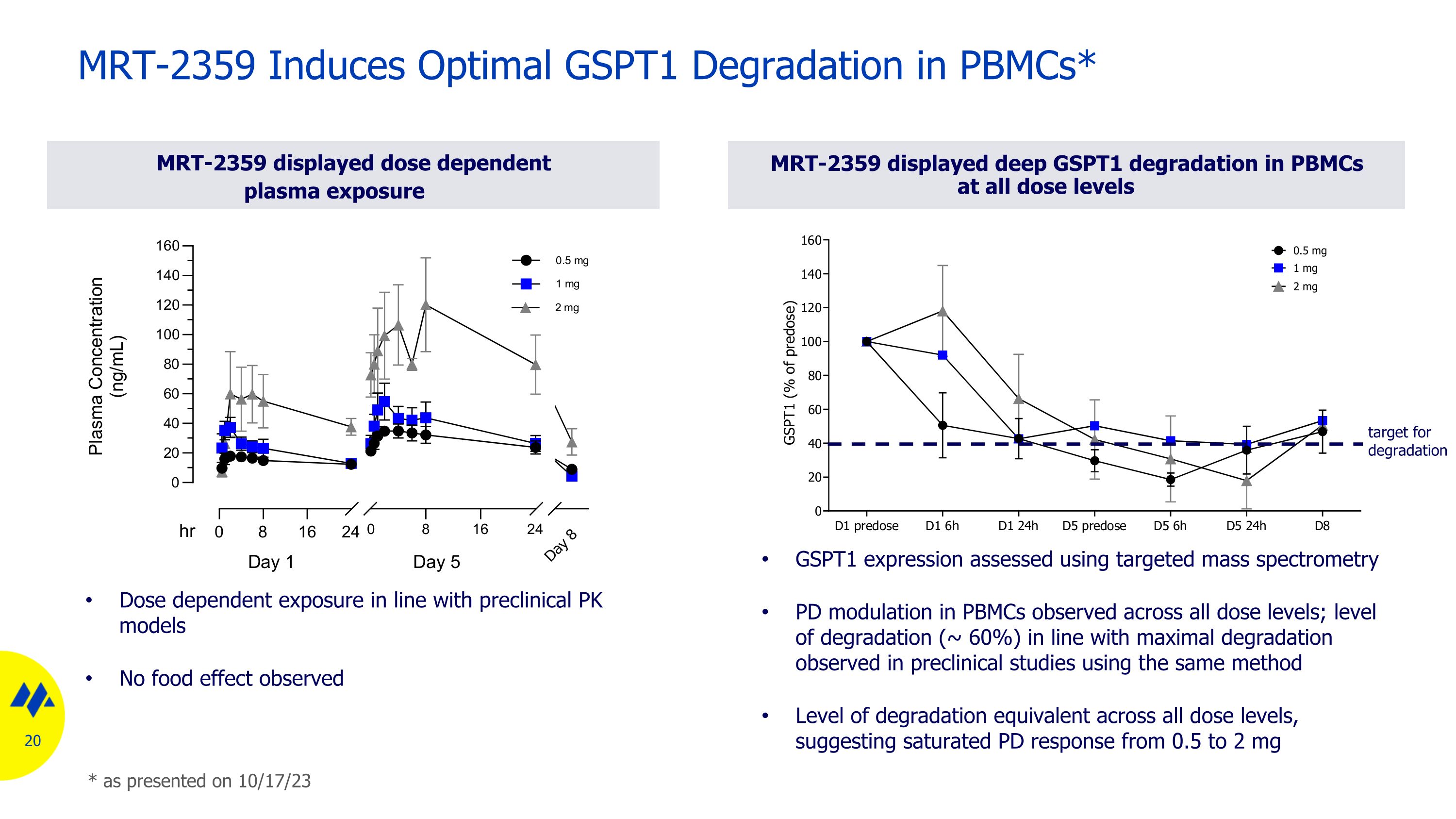
MRT-2359 displayed dose dependent plasma exposure MRT-2359 Induces Optimal GSPT1 Degradation in PBMCs* MRT-2359 displayed deep GSPT1 degradation in PBMCs at all dose levels GSPT1 expression assessed using targeted mass spectrometry PD modulation in PBMCs observed across all dose levels; level of degradation (~ 60%) in line with maximal degradation observed in preclinical studies using the same method Level of degradation equivalent across all dose levels, suggesting saturated PD response from 0.5 to 2 mg Dose dependent exposure in line with preclinical PK models No food effect observed target for degradation * as presented on 10/17/23
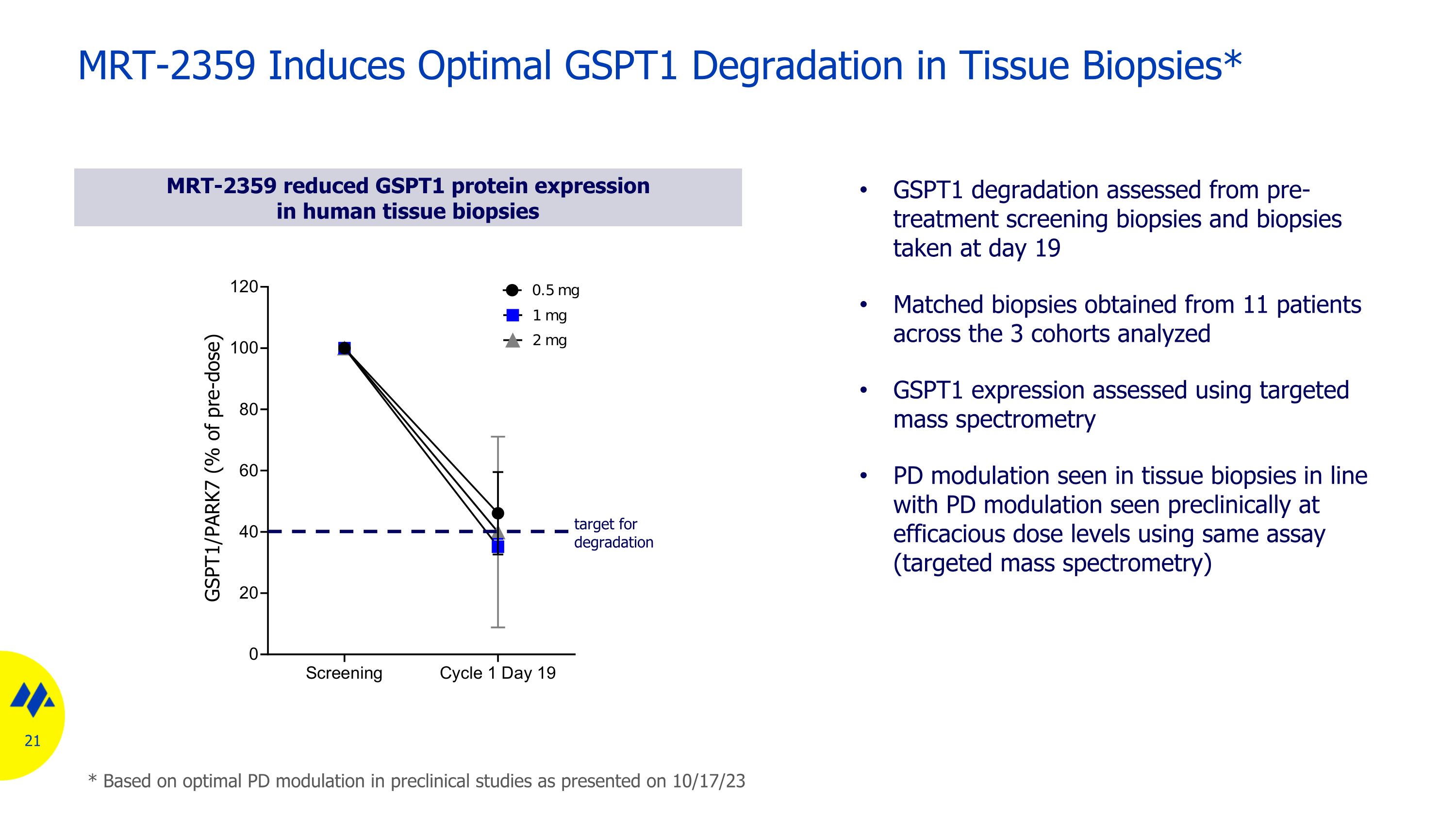
MRT-2359 Induces Optimal GSPT1 Degradation in Tissue Biopsies* MRT-2359 reduced GSPT1 protein expression in human tissue biopsies GSPT1 degradation assessed from pre-treatment screening biopsies and biopsies taken at day 19 Matched biopsies obtained from 11 patients across the 3 cohorts analyzed GSPT1 expression assessed using targeted mass spectrometry PD modulation seen in tissue biopsies in line with PD modulation seen preclinically at efficacious dose levels using same assay (targeted mass spectrometry) target for degradation * Based on optimal PD modulation in preclinical studies as presented on 10/17/23
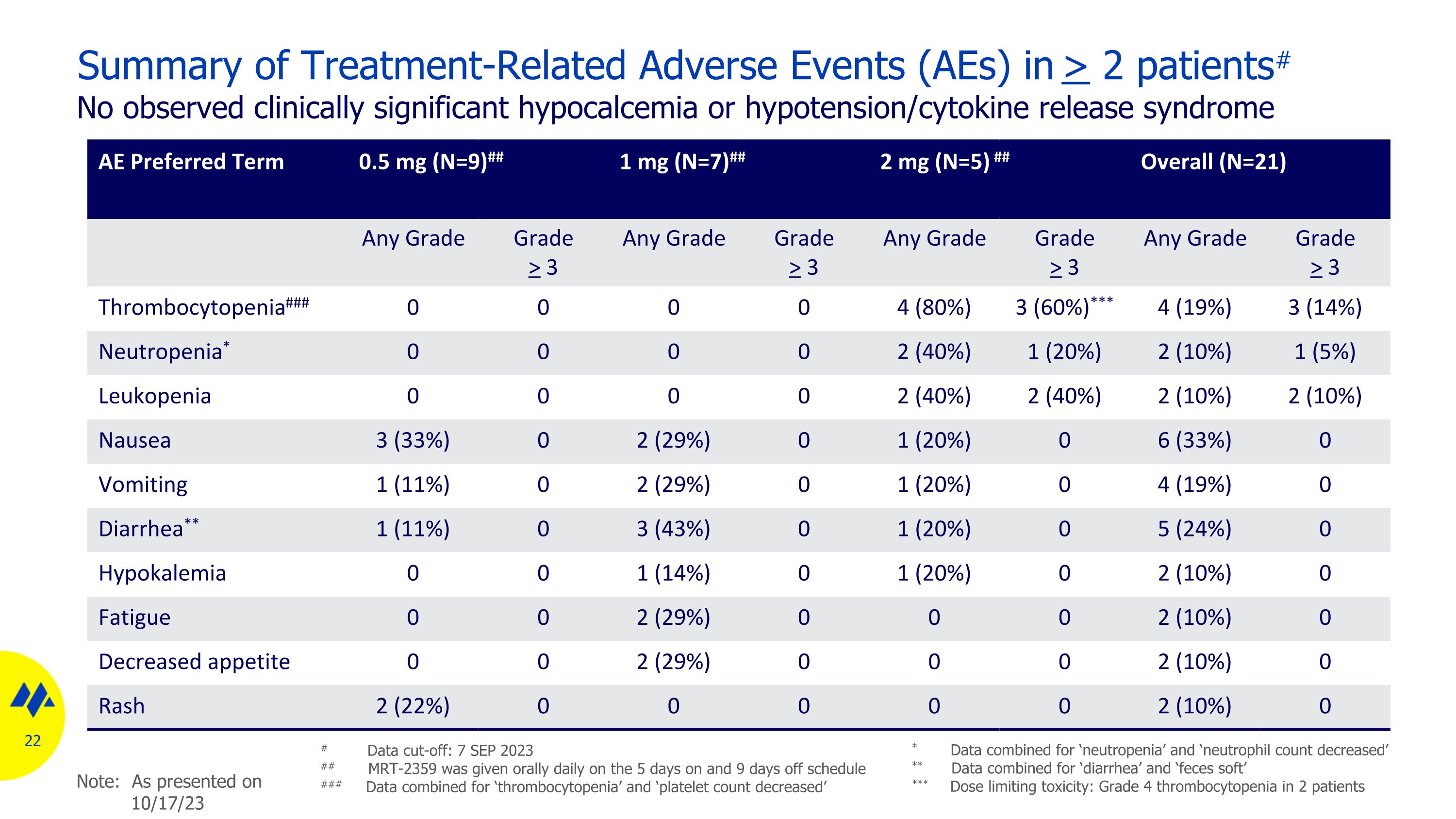
Summary of Treatment-Related Adverse Events (AEs) in > 2 patients# No observed clinically significant hypocalcemia or hypotension/cytokine release syndrome AE Preferred Term 0.5 mg (N=9)## 1 mg (N=7)## 2 mg (N=5) ## Overall (N=21) Any Grade Grade > 3 Any Grade Grade > 3 Any Grade Grade > 3 Any Grade Grade > 3 Thrombocytopenia### 0 0 0 0 4 (80%) 3 (60%)*** 4 (19%) 3 (14%) Neutropenia* 0 0 0 0 2 (40%) 1 (20%) 2 (10%) 1 (5%) Leukopenia 0 0 0 0 2 (40%) 2 (40%) 2 (10%) 2 (10%) Nausea 3 (33%) 0 2 (29%) 0 1 (20%) 0 6 (33%) 0 Vomiting 1 (11%) 0 2 (29%) 0 1 (20%) 0 4 (19%) 0 Diarrhea** 1 (11%) 0 3 (43%) 0 1 (20%) 0 5 (24%) 0 Hypokalemia 0 0 1 (14%) 0 1 (20%) 0 2 (10%) 0 Fatigue 0 0 2 (29%) 0 0 0 2 (10%) 0 Decreased appetite 0 0 2 (29%) 0 0 0 2 (10%) 0 Rash 2 (22%) 0 0 0 0 0 2 (10%) 0 # Data cut-off: 7 SEP 2023 ## MRT-2359 was given orally daily on the 5 days on and 9 days off schedule ### Data combined for ‘thrombocytopenia’ and ‘platelet count decreased’ * Data combined for ‘neutropenia’ and ‘neutrophil count decreased’ ** Data combined for ‘diarrhea’ and ‘feces soft’ *** Dose limiting toxicity: Grade 4 thrombocytopenia in 2 patients Note: As presented on 10/17/23
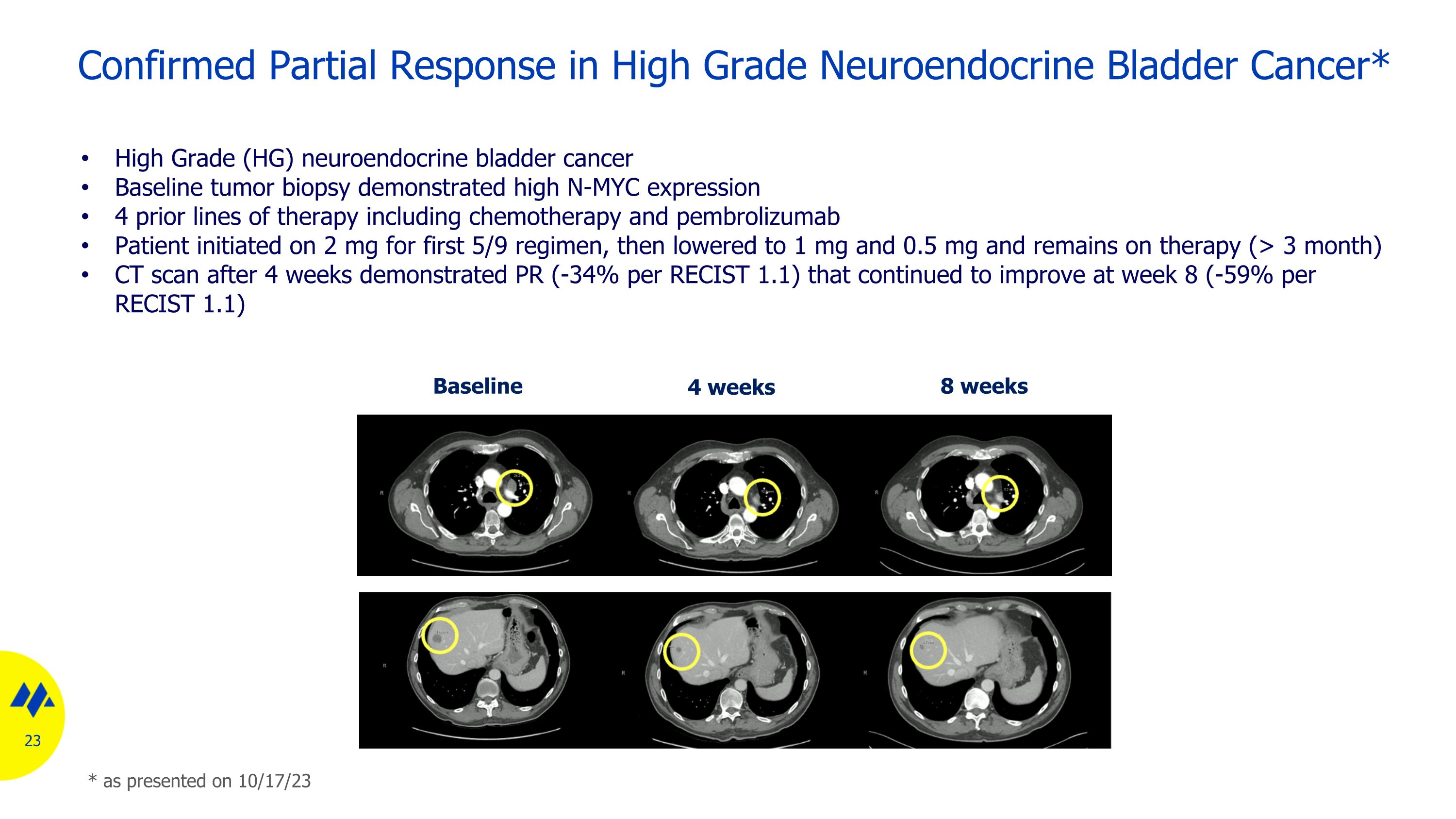
Confirmed Partial Response in High Grade Neuroendocrine Bladder Cancer* Baseline 8 weeks 4 weeks High Grade (HG) neuroendocrine bladder cancer Baseline tumor biopsy demonstrated high N-MYC expression 4 prior lines of therapy including chemotherapy and pembrolizumab Patient initiated on 2 mg for first 5/9 regimen, then lowered to 1 mg and 0.5 mg and remains on therapy (> 3 month) CT scan after 4 weeks demonstrated PR (-34% per RECIST 1.1) that continued to improve at week 8 (-59% per RECIST 1.1) * as presented on 10/17/23
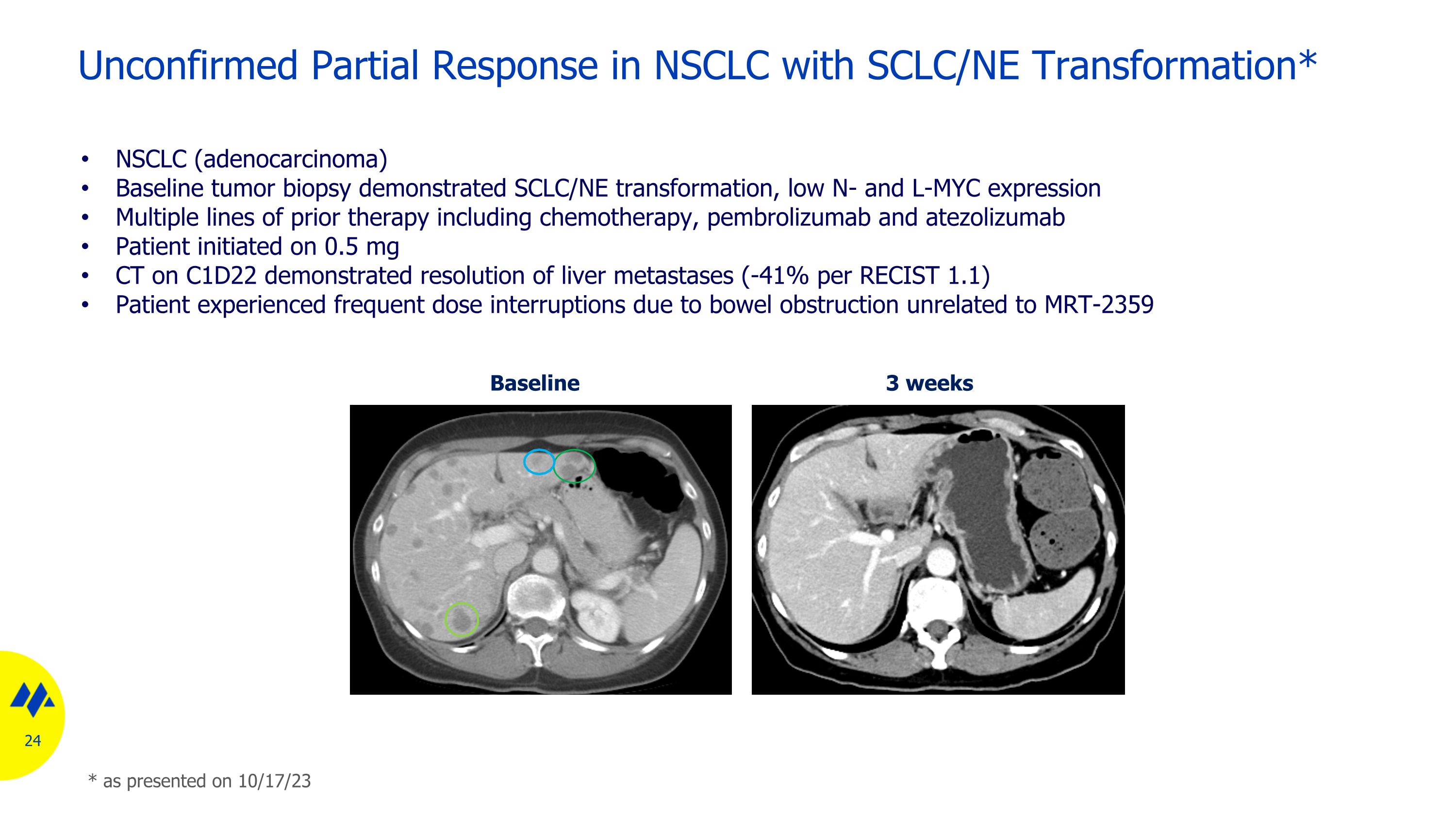
Unconfirmed Partial Response in NSCLC with SCLC/NE Transformation* Baseline 3 weeks NSCLC (adenocarcinoma) Baseline tumor biopsy demonstrated SCLC/NE transformation, low N- and L-MYC expression Multiple lines of prior therapy including chemotherapy, pembrolizumab and atezolizumab Patient initiated on 0.5 mg CT on C1D22 demonstrated resolution of liver metastases (-41% per RECIST 1.1) Patient experienced frequent dose interruptions due to bowel obstruction unrelated to MRT-2359 * as presented on 10/17/23
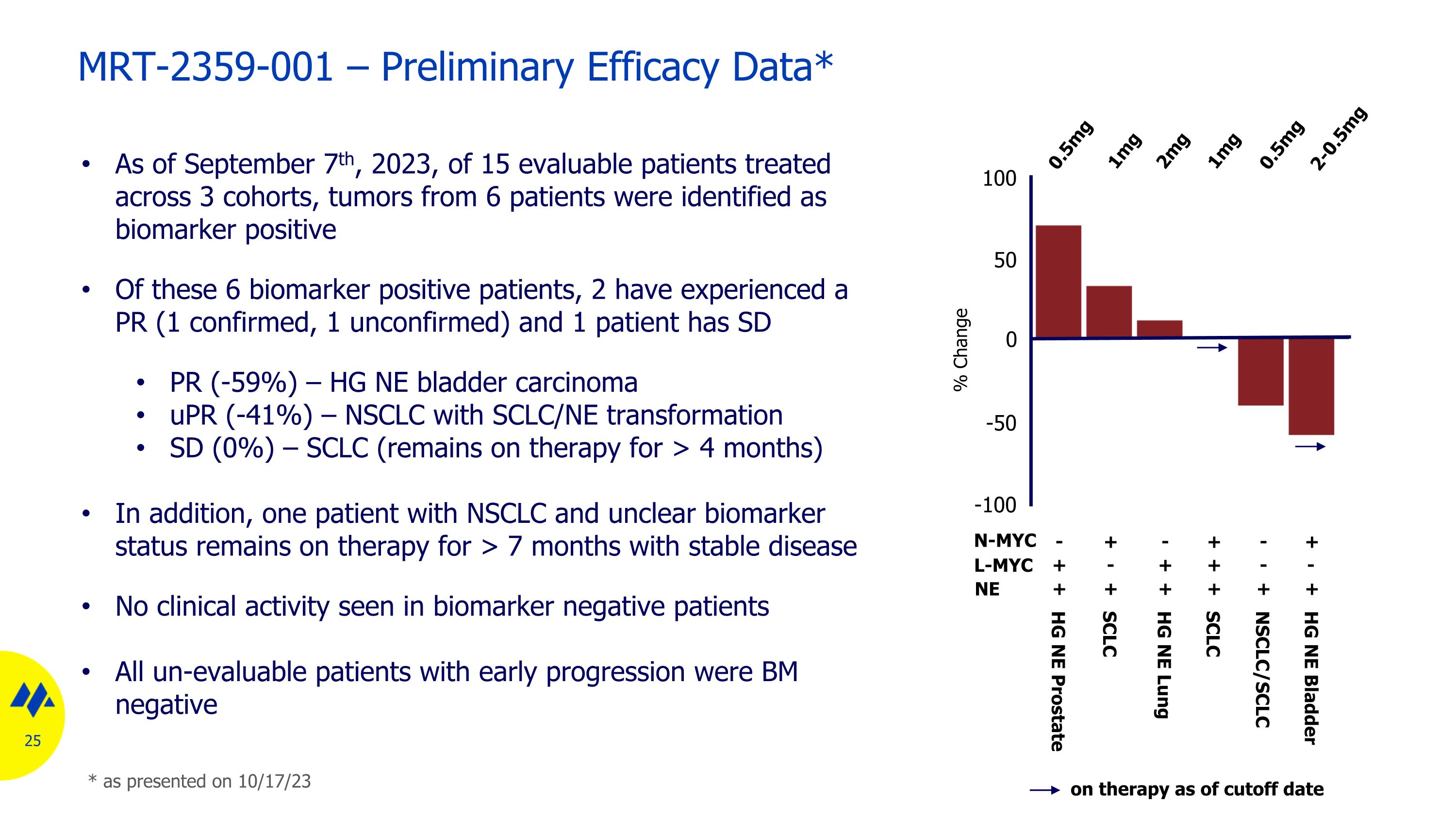
MRT-2359-001 – Preliminary Efficacy Data* As of September 7th, 2023, of 15 evaluable patients treated across 3 cohorts, tumors from 6 patients were identified as biomarker positive Of these 6 biomarker positive patients, 2 have experienced a PR (1 confirmed, 1 unconfirmed) and 1 patient has SD PR (-59%) – HG NE bladder carcinoma uPR (-41%) – NSCLC with SCLC/NE transformation SD (0%) – SCLC (remains on therapy for > 4 months) In addition, one patient with NSCLC and unclear biomarker status remains on therapy for > 7 months with stable disease No clinical activity seen in biomarker negative patients All un-evaluable patients with early progression were BM negative 100 50 0 -50 -100 0.5mg 0.5mg 2mg 1mg 1mg 2-0.5mg HG NE Prostate SCLC SCLC NSCLC/SCLC HG NE Lung HG NE Bladder % Change on therapy as of cutoff date N-MYC + + + - - - + + + + + + NE L-MYC + - - + + - * as presented on 10/17/23
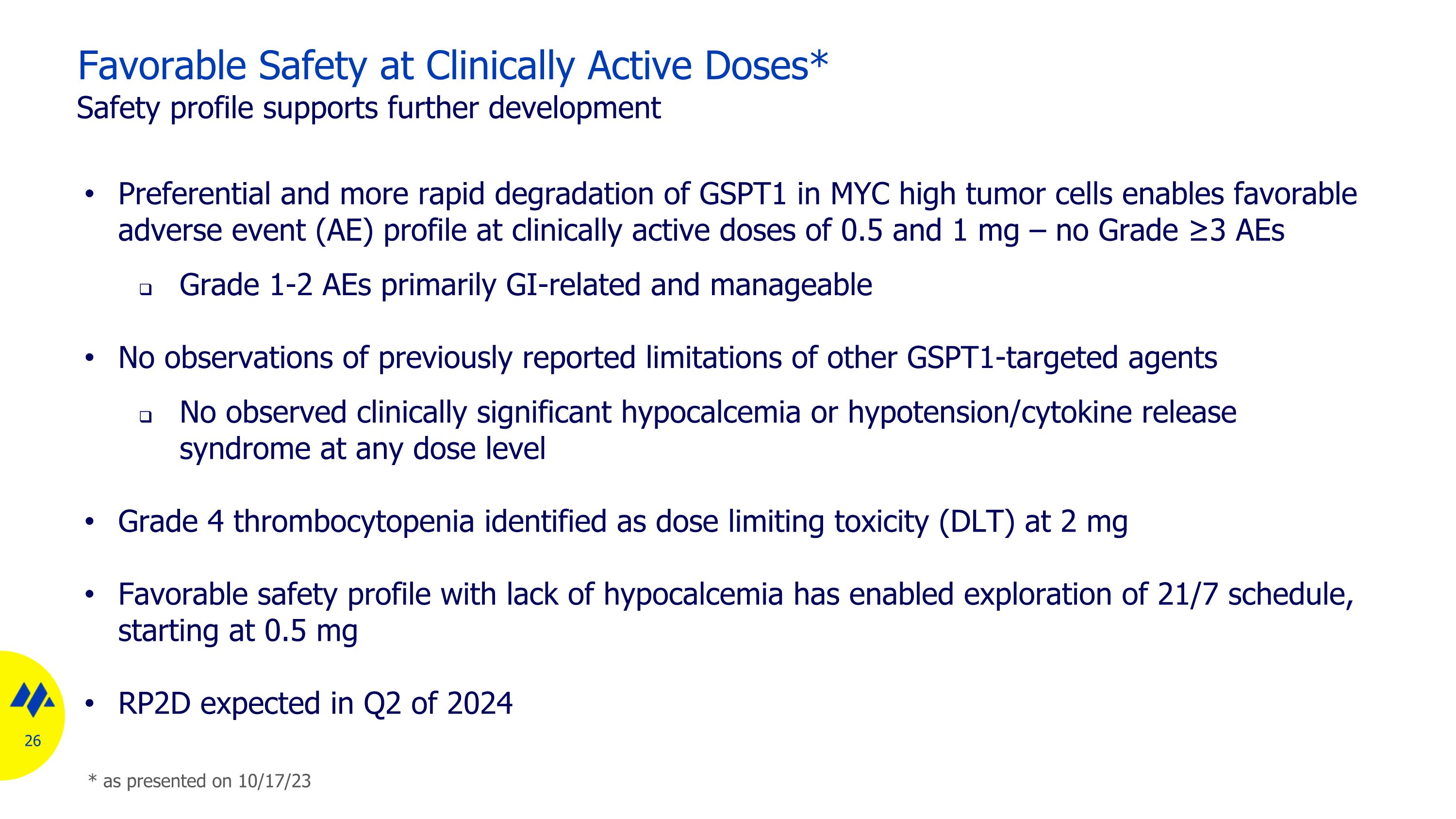
Favorable Safety at Clinically Active Doses* Safety profile supports further development Preferential and more rapid degradation of GSPT1 in MYC high tumor cells enables favorable adverse event (AE) profile at clinically active doses of 0.5 and 1 mg – no Grade ≥3 AEs Grade 1-2 AEs primarily GI-related and manageable No observations of previously reported limitations of other GSPT1-targeted agents No observed clinically significant hypocalcemia or hypotension/cytokine release syndrome at any dose level Grade 4 thrombocytopenia identified as dose limiting toxicity (DLT) at 2 mg Favorable safety profile with lack of hypocalcemia has enabled exploration of 21/7 schedule, starting at 0.5 mg RP2D expected in Q2 of 2024 * as presented on 10/17/23

CDK2 Program
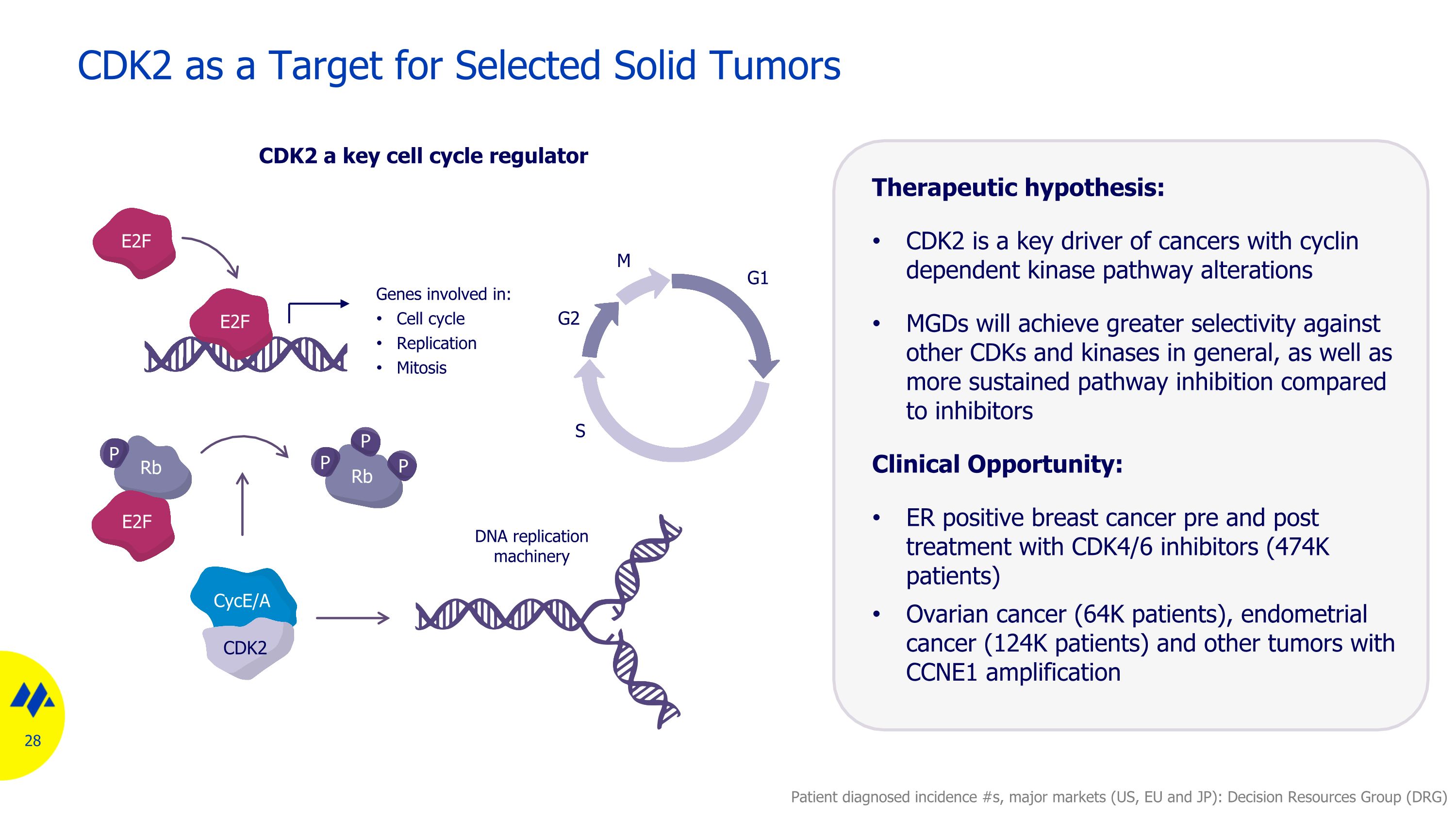
CDK2 as a Target for Selected Solid Tumors Therapeutic hypothesis: CDK2 is a key driver of cancers with cyclin dependent kinase pathway alterations MGDs will achieve greater selectivity against other CDKs and kinases in general, as well as more sustained pathway inhibition compared to inhibitors Clinical Opportunity: ER positive breast cancer pre and post treatment with CDK4/6 inhibitors (474K patients) Ovarian cancer (64K patients), endometrial cancer (124K patients) and other tumors with CCNE1 amplification CDK2 a key cell cycle regulator Patient diagnosed incidence #s, major markets (US, EU and JP): Decision Resources Group (DRG) S G2 M G1 Genes involved in: Cell cycle Replication Mitosis P P 4EBP1 Rb P P P 4EBP1 Rb P E2F E2F E2F DNA replication machinery CycE/A CDK2
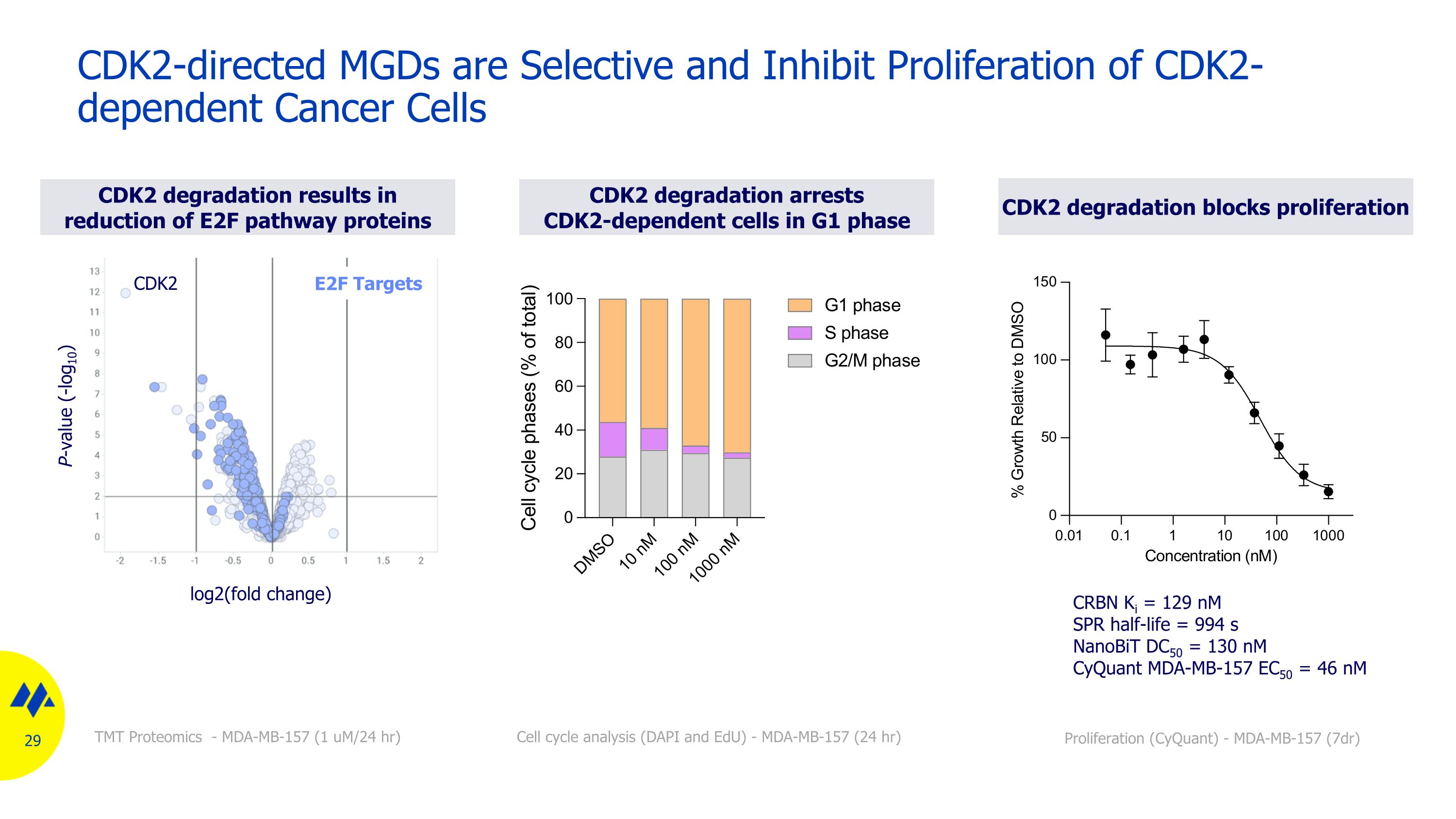
CDK2-directed MGDs are Selective and Inhibit Proliferation of CDK2-dependent Cancer Cells CDK2 degradation arrests CDK2-dependent cells in G1 phase CDK2 degradation results in reduction of E2F pathway proteins Cell cycle analysis (DAPI and EdU) - MDA-MB-157 (24 hr) TMT Proteomics - MDA-MB-157 (1 uM/24 hr) log2(fold change) CDK2 E2F Targets P-value (-log10) CDK2 degradation blocks proliferation CRBN Ki = 129 nM SPR half-life = 994 s NanoBiT DC50 = 130 nM CyQuant MDA-MB-157 EC50 = 46 nM Proliferation (CyQuant) - MDA-MB-157 (7dr)
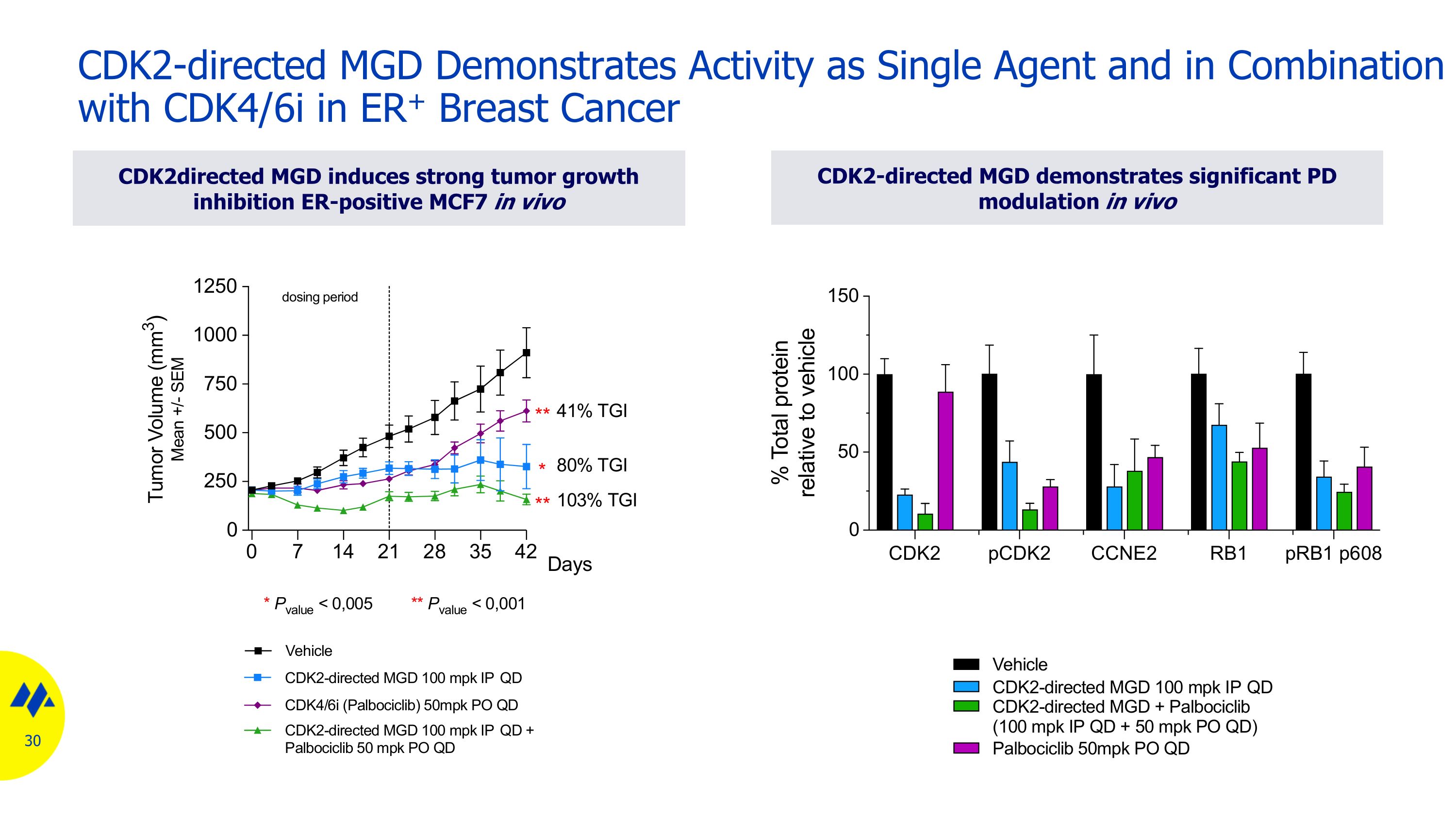
CDK2-directed MGD Demonstrates Activity as Single Agent and in Combination with CDK4/6i in ER+ Breast Cancer CDK2directed MGD induces strong tumor growth inhibition ER-positive MCF7 in vivo CDK2-directed MGD demonstrates significant PD modulation in vivo

Inflammation and Immunology (I&I) Programs
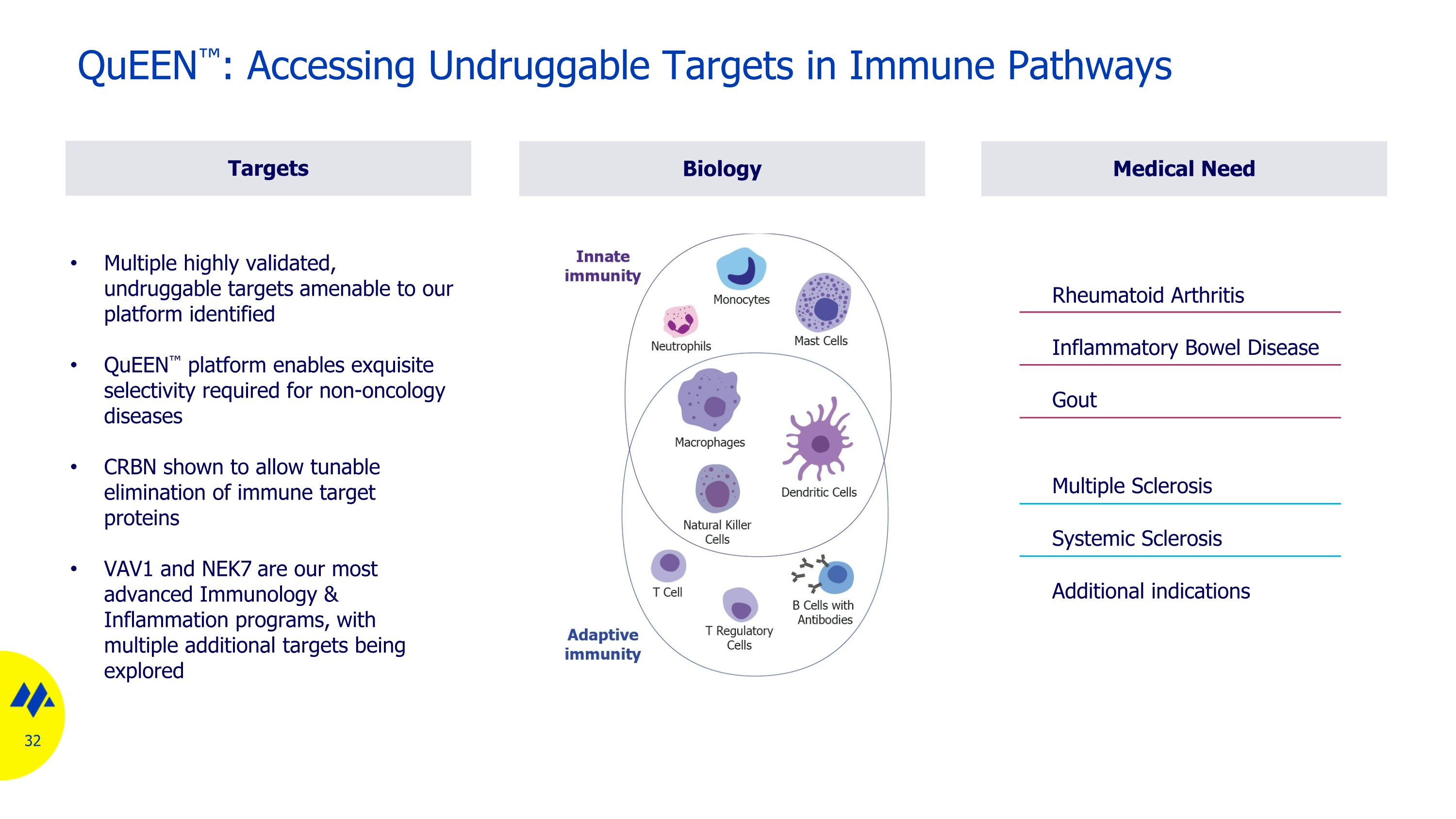
Biology Multiple highly validated, undruggable targets amenable to our platform identified QuEEN™ platform enables exquisite selectivity required for non-oncology diseases CRBN shown to allow tunable elimination of immune target proteins VAV1 and NEK7 are our most advanced Immunology & Inflammation programs, with multiple additional targets being explored QuEEN™: Accessing Undruggable Targets in Immune Pathways Medical Need Targets Additional indications Systemic Sclerosis Multiple Sclerosis Rheumatoid Arthritis Inflammatory Bowel Disease Gout

VAV1 Program
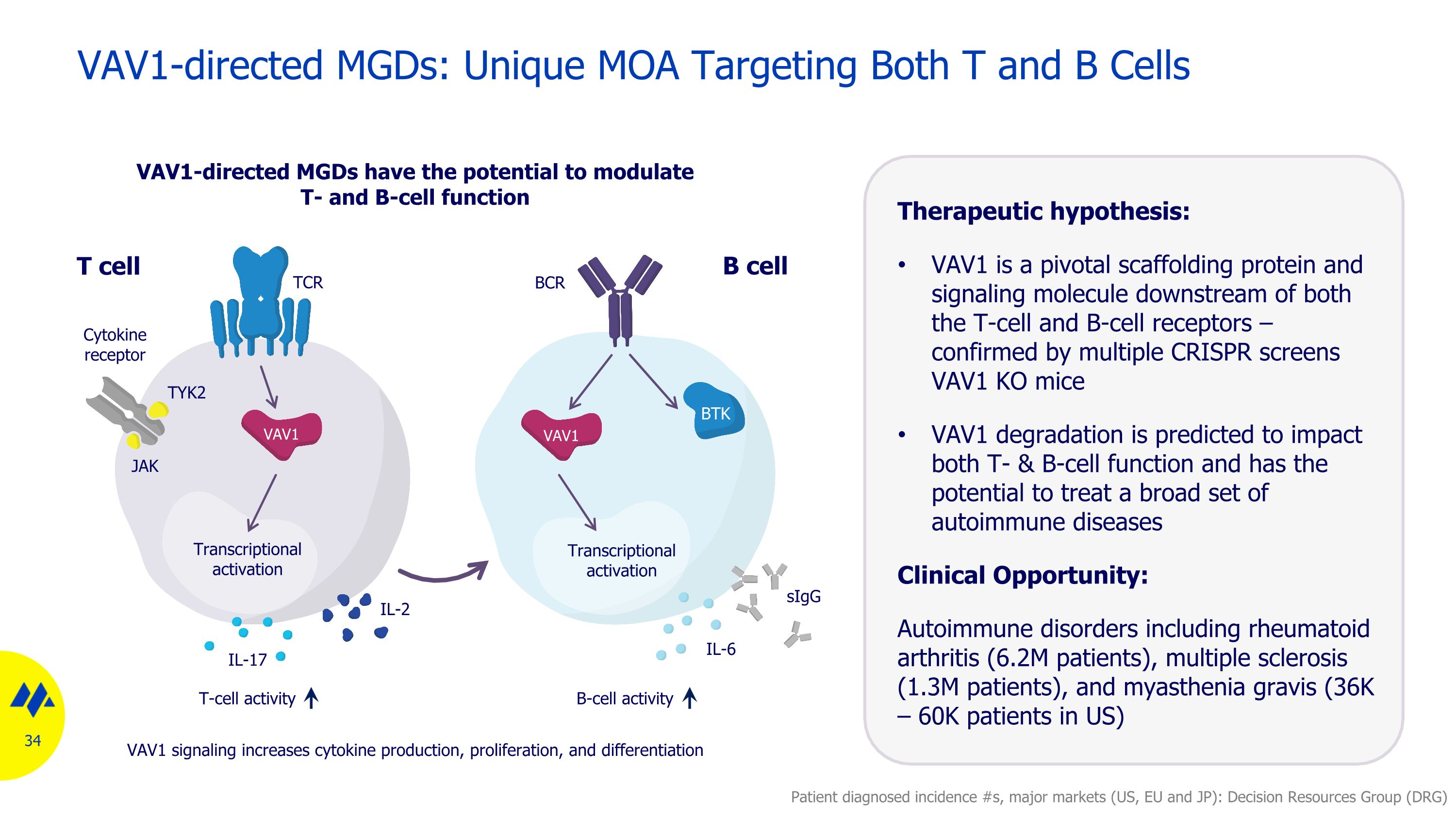
VAV1-directed MGDs: Unique MOA Targeting Both T and B Cells Therapeutic hypothesis: VAV1 is a pivotal scaffolding protein and signaling molecule downstream of both the T-cell and B-cell receptors – confirmed by multiple CRISPR screens VAV1 KO mice VAV1 degradation is predicted to impact both T- & B-cell function and has the potential to treat a broad set of autoimmune diseases Clinical Opportunity: Autoimmune disorders including rheumatoid arthritis (6.2M patients), multiple sclerosis (1.3M patients), and myasthenia gravis (36K – 60K patients in US) Patient diagnosed incidence #s, major markets (US, EU and JP): Decision Resources Group (DRG) Cytokine receptor TYK2 JAK TCR T cell B cell BTK BCR IL-2 IL-17 sIgG IL-6 T-cell activity B-cell activity Transcriptional activation VAV1 signaling increases cytokine production, proliferation, and differentiation Transcriptional activation VAV1-directed MGDs have the potential to modulate T- and B-cell function VAV1 VAV1
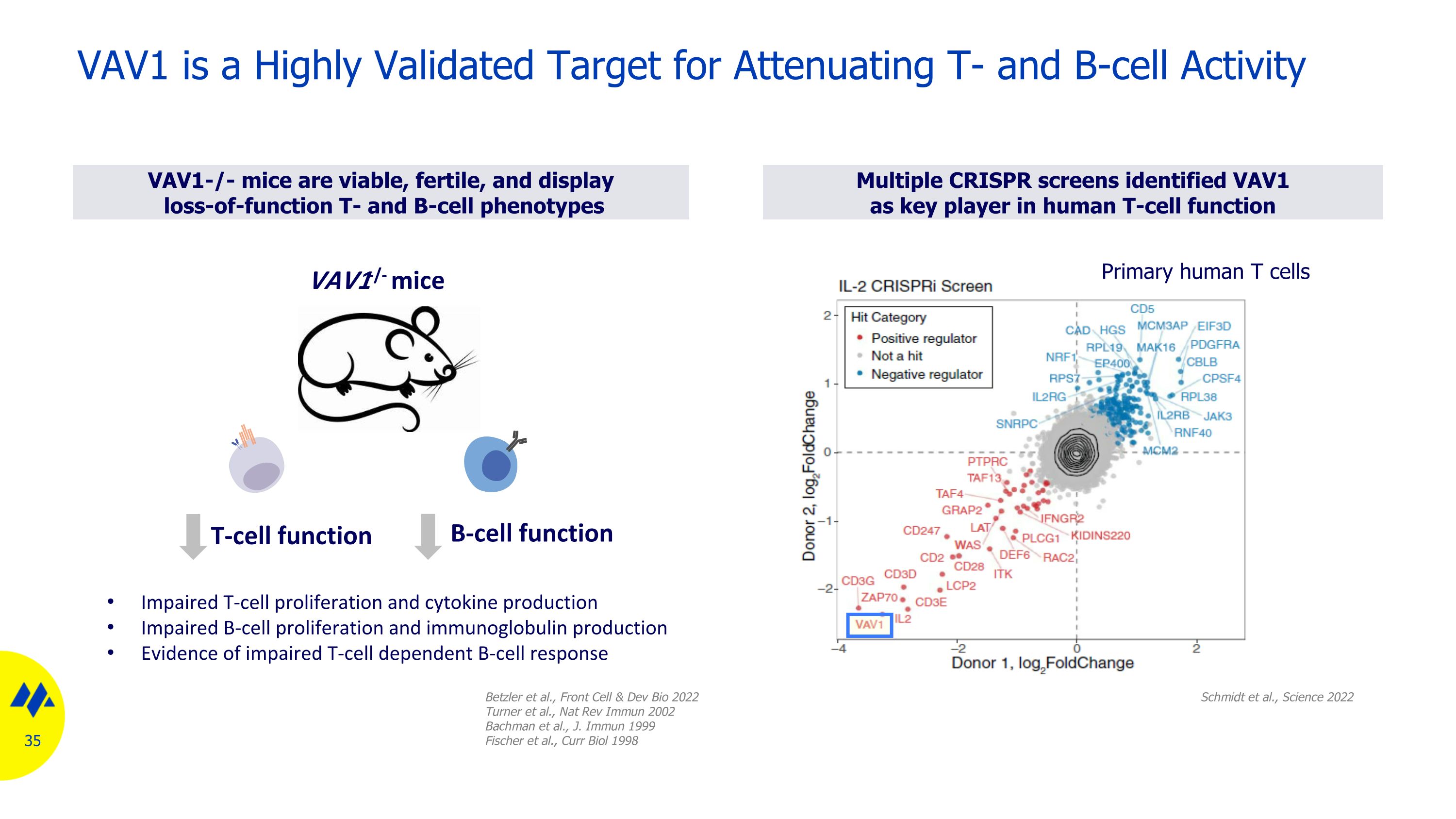
VAV1-/- mice are viable, fertile, and display loss-of-function T- and B-cell phenotypes Multiple CRISPR screens identified VAV1 as key player in human T-cell function VAV1 is a Highly Validated Target for Attenuating T- and B-cell Activity Schmidt et al., Science 2022 Primary human T cells Betzler et al., Front Cell & Dev Bio 2022 Turner et al., Nat Rev Immun 2002 Bachman et al., J. Immun 1999 Fischer et al., Curr Biol 1998 T-cell function B-cell function VAV1-/- mice Impaired T-cell proliferation and cytokine production Impaired B-cell proliferation and immunoglobulin production Evidence of impaired T-cell dependent B-cell response
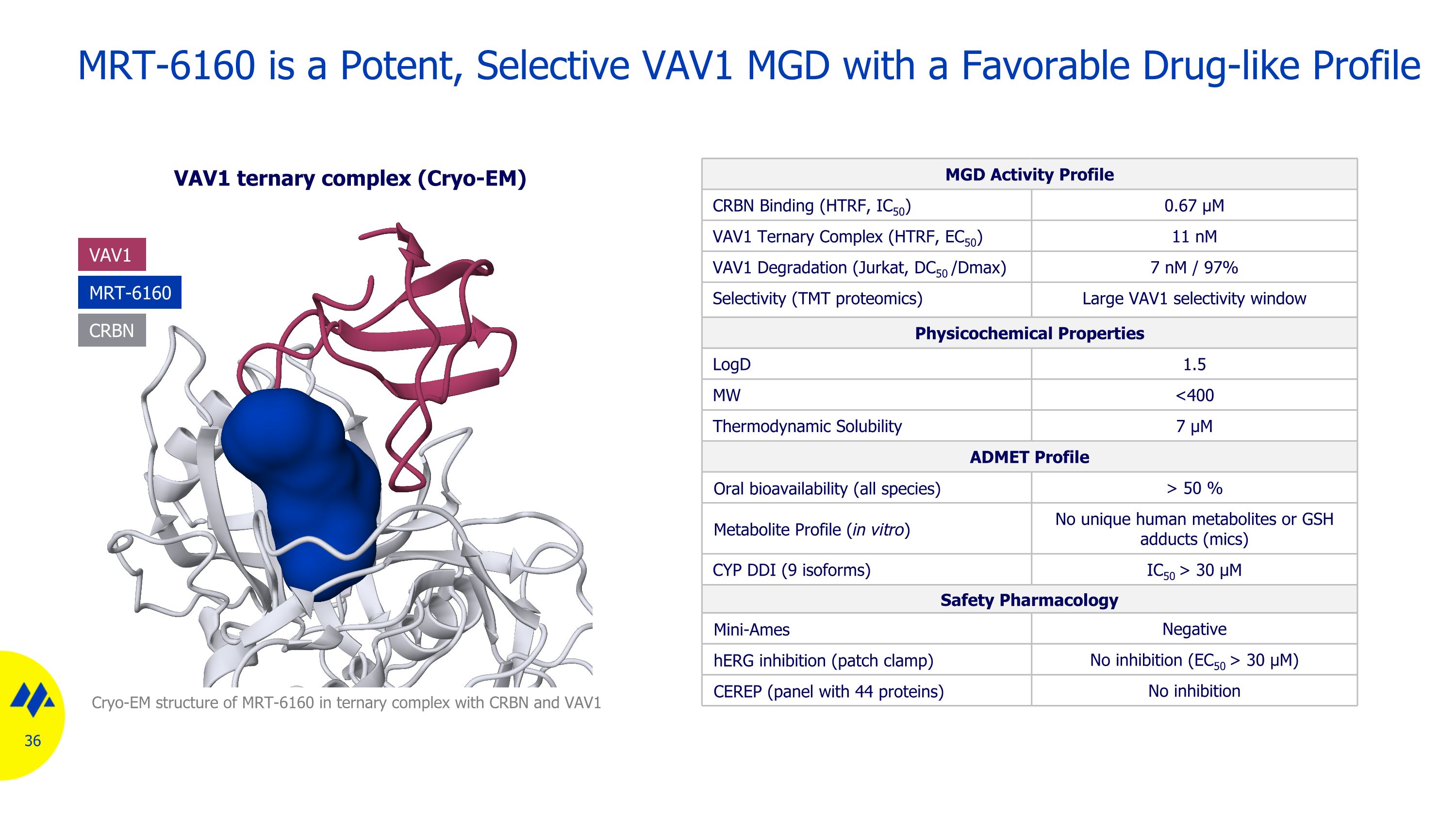
MRT-6160 is a Potent, Selective VAV1 MGD with a Favorable Drug-like Profile VAV1 ternary complex (Cryo-EM) MGD Activity Profile CRBN Binding (HTRF, IC50) 0.67 µM VAV1 Ternary Complex (HTRF, EC50) 11 nM VAV1 Degradation (Jurkat, DC50 /Dmax) 7 nM / 97% Selectivity (TMT proteomics) Large VAV1 selectivity window Physicochemical Properties LogD 1.5 MW <400 Thermodynamic Solubility 7 µM ADMET Profile Oral bioavailability (all species) > 50 % Metabolite Profile (in vitro) No unique human metabolites or GSH adducts (mics) CYP DDI (9 isoforms) IC50 > 30 μM Safety Pharmacology Mini-Ames Negative hERG inhibition (patch clamp) No inhibition (EC50 > 30 µM) CEREP (panel with 44 proteins) No inhibition Cryo-EM structure of MRT-6160 in ternary complex with CRBN and VAV1 MRT-6160 VAV1 CRBN
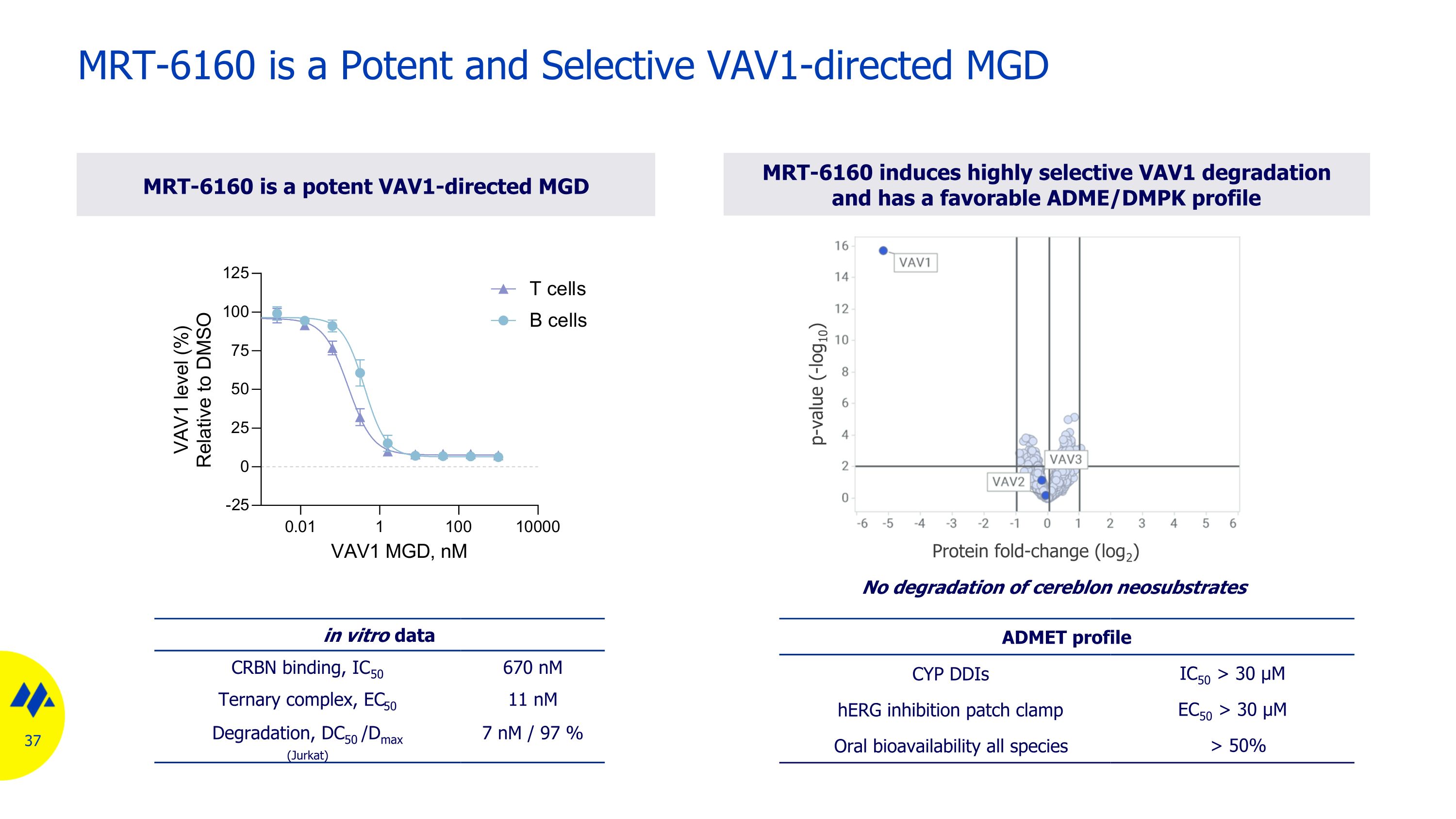
MRT-6160 is a Potent and Selective VAV1-directed MGD in vitro data CRBN binding, IC50 670 nM Ternary complex, EC50 11 nM Degradation, DC50 /Dmax (Jurkat) 7 nM / 97 % MRT-6160 induces highly selective VAV1 degradation and has a favorable ADME/DMPK profile MRT-6160 is a potent VAV1-directed MGD ADMET profile CYP DDIs IC50 > 30 µM hERG inhibition patch clamp EC50 > 30 µM Oral bioavailability all species > 50% p-value (-log10) Protein fold-change (log2) No degradation of cereblon neosubstrates
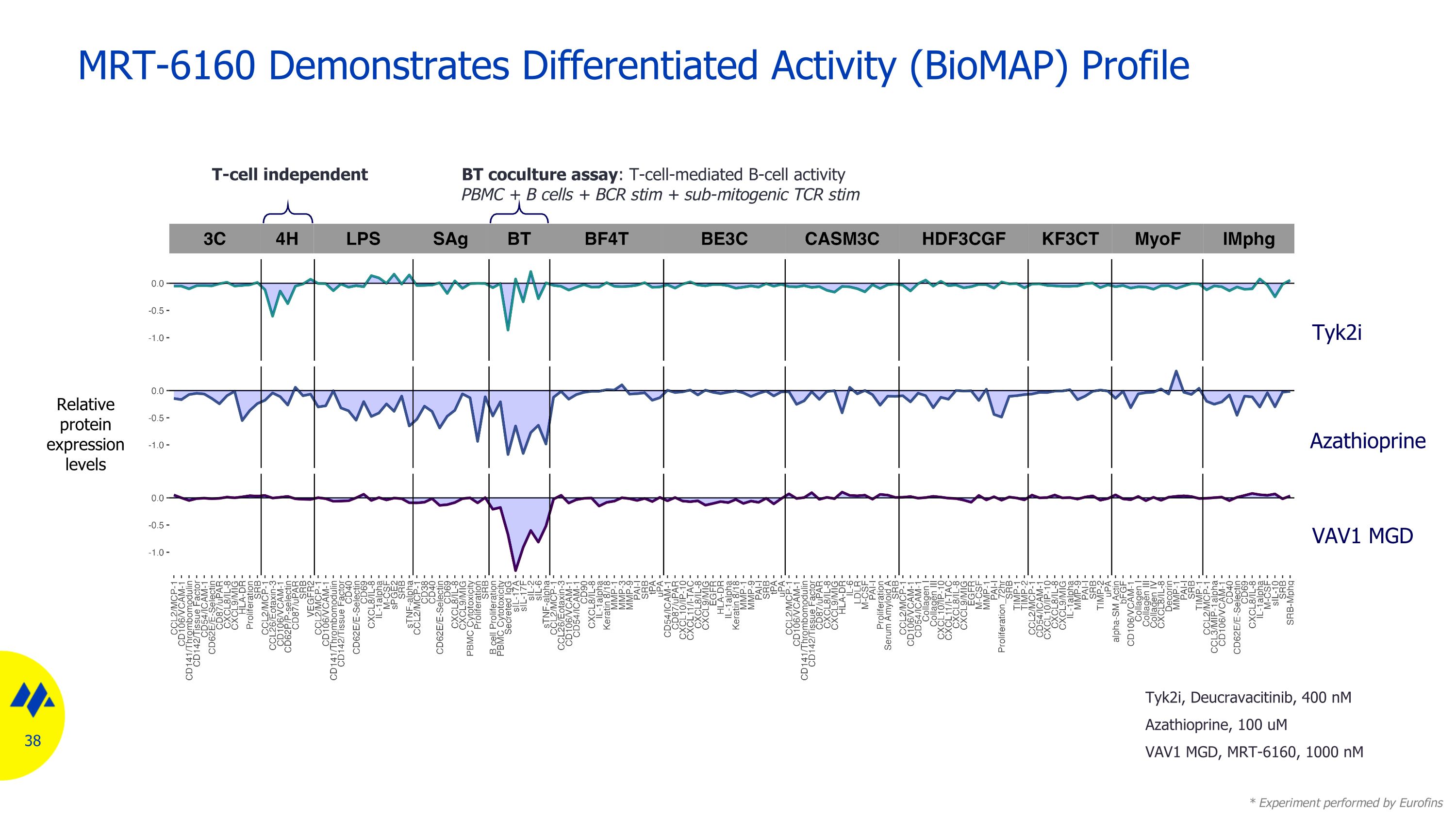
MRT-6160 Demonstrates Differentiated Activity (BioMAP) Profile Relative protein expression levels Azathioprine VAV1 MGD Tyk2i BT coculture assay: T-cell-mediated B-cell activity PBMC + B cells + BCR stim + sub-mitogenic TCR stim * Experiment performed by Eurofins T-cell independent Tyk2i, Deucravacitinib, 400 nM Azathioprine, 100 uM VAV1 MGD, MRT-6160, 1000 nM
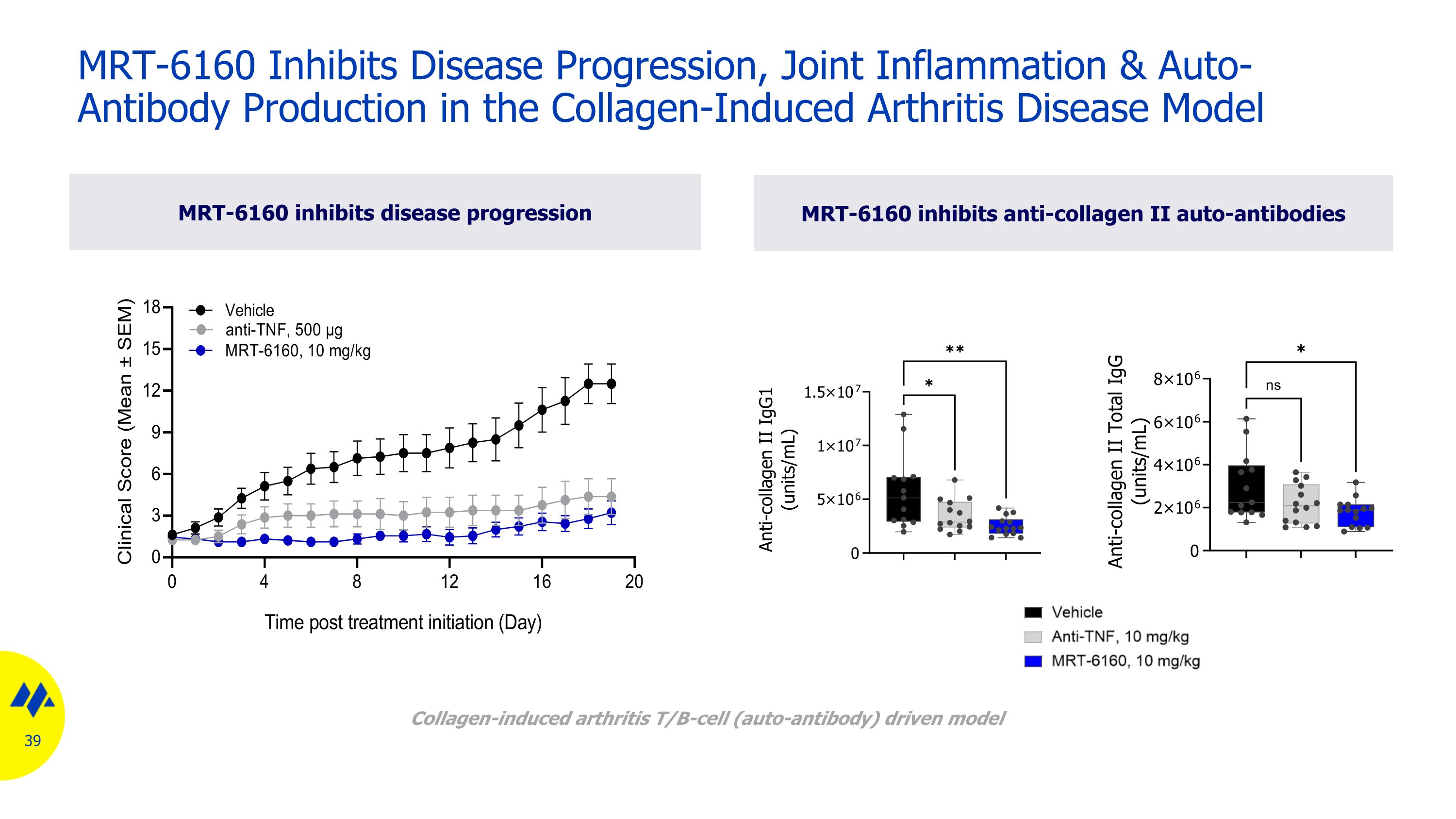
MRT-6160 Inhibits Disease Progression, Joint Inflammation & Auto-Antibody Production in the Collagen-Induced Arthritis Disease Model MRT-6160 inhibits anti-collagen II auto-antibodies MRT-6160 inhibits disease progression Collagen-induced arthritis T/B-cell (auto-antibody) driven model
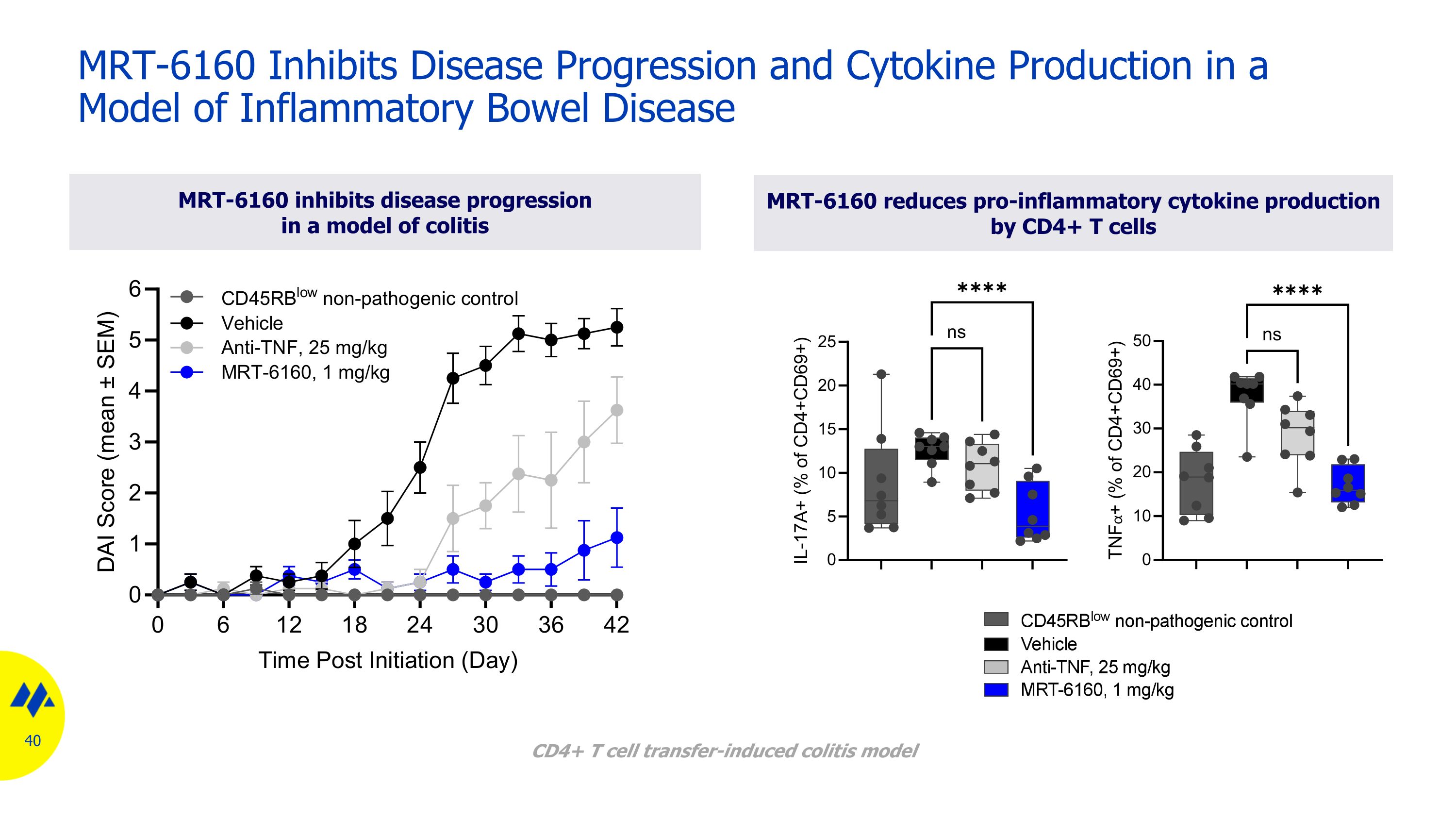
MRT-6160 Inhibits Disease Progression and Cytokine Production in a Model of Inflammatory Bowel Disease MRT-6160 reduces pro-inflammatory cytokine production by CD4+ T cells MRT-6160 inhibits disease progression in a model of colitis CD4+ T cell transfer-induced colitis model
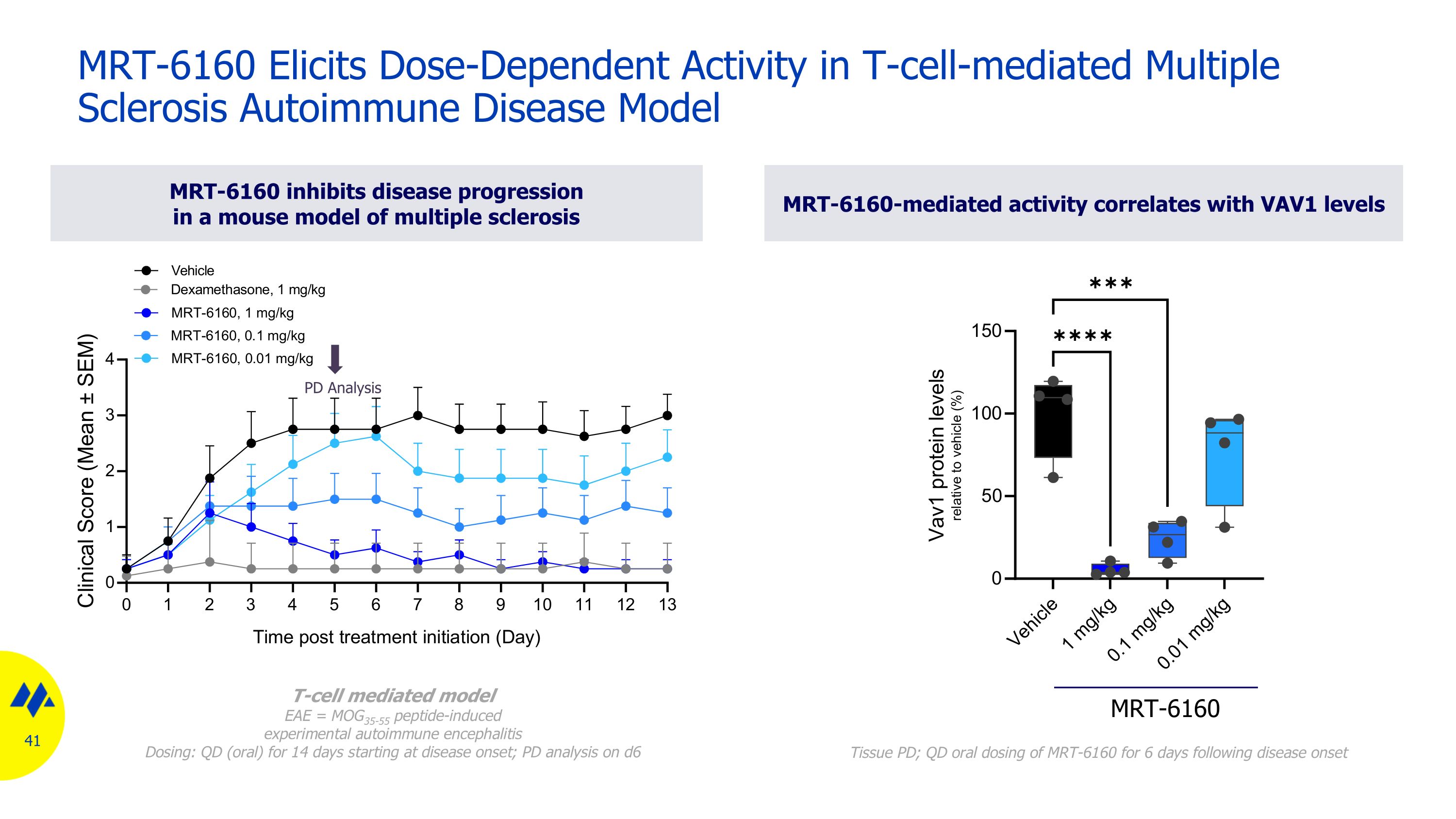
PD Analysis MRT-6160 inhibits disease progression in a mouse model of multiple sclerosis MRT-6160-mediated activity correlates with VAV1 levels T-cell mediated model EAE = MOG35-55 peptide-induced experimental autoimmune encephalitis Dosing: QD (oral) for 14 days starting at disease onset; PD analysis on d6 MRT-6160 Tissue PD; QD oral dosing of MRT-6160 for 6 days following disease onset MRT-6160 Elicits Dose-Dependent Activity in T-cell-mediated Multiple Sclerosis Autoimmune Disease Model
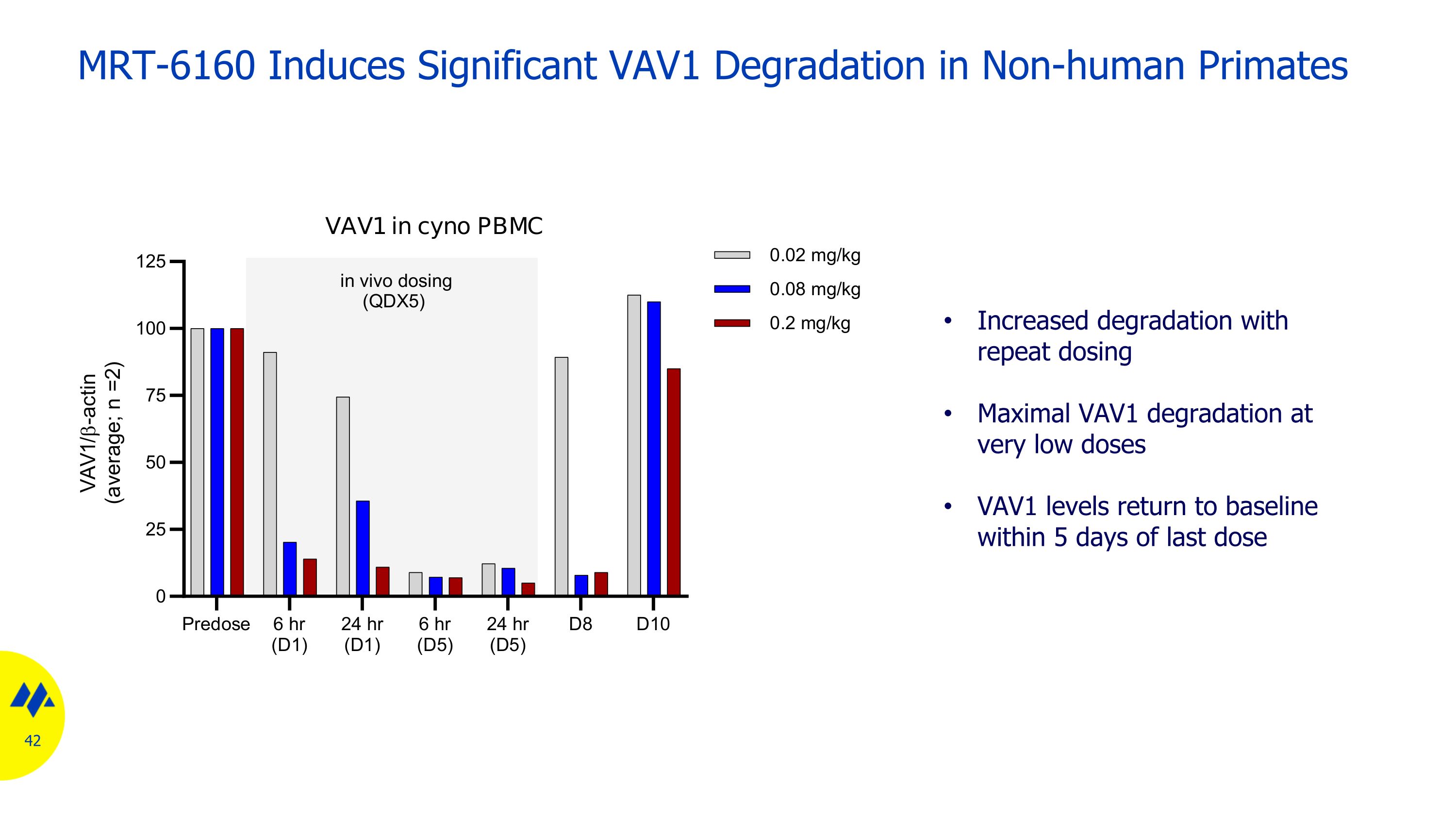
MRT-6160 Induces Significant VAV1 Degradation in Non-human Primates Increased degradation with repeat dosing Maximal VAV1 degradation at very low doses VAV1 levels return to baseline within 5 days of last dose
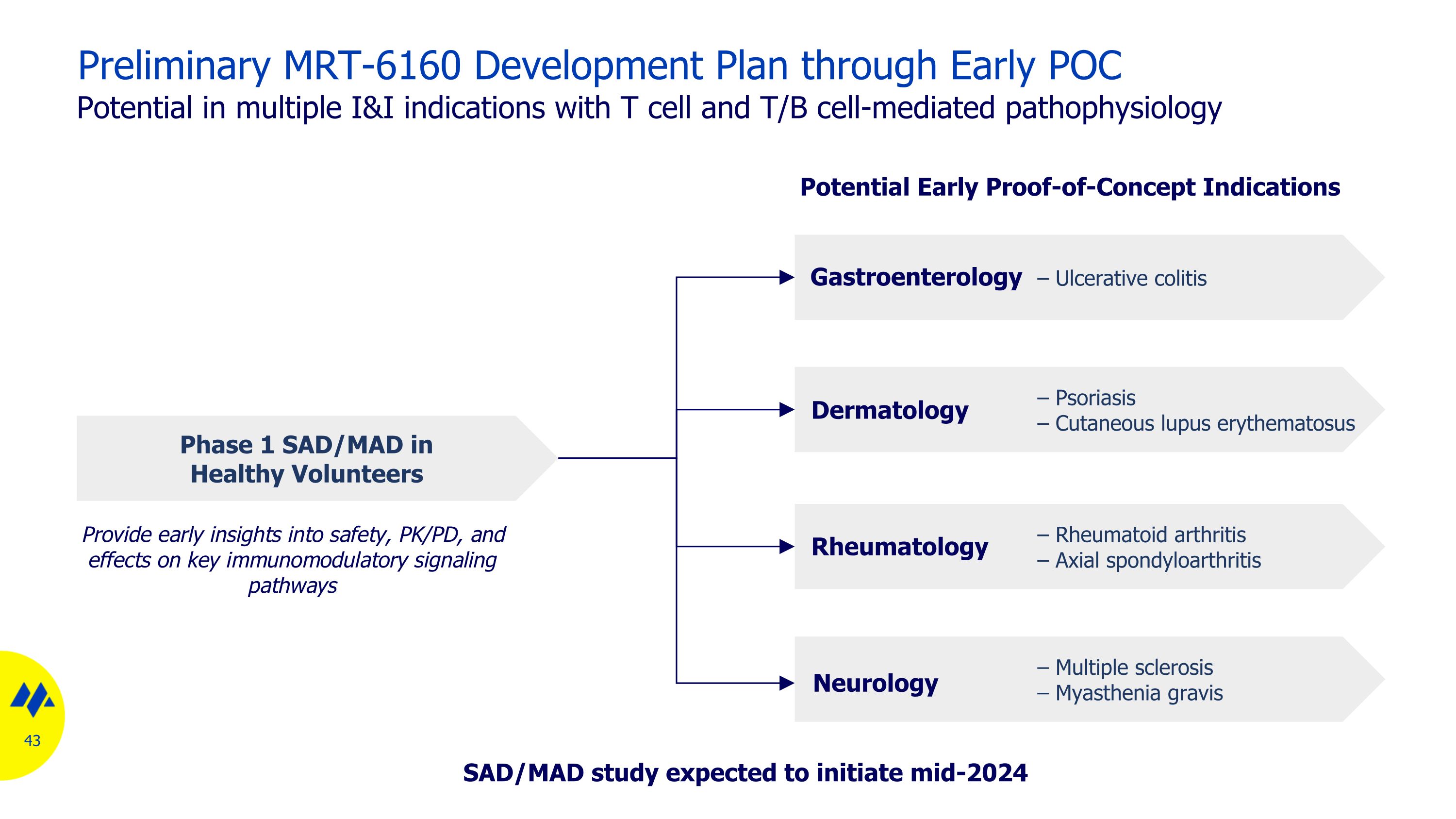
Preliminary MRT-6160 Development Plan through Early POC Potential in multiple I&I indications with T cell and T/B cell-mediated pathophysiology Potential Early Proof-of-Concept Indications Provide early insights into safety, PK/PD, and effects on key immunomodulatory signaling pathways – Ulcerative colitis Phase 1 SAD/MAD in �Healthy Volunteers – Psoriasis – Cutaneous lupus erythematosus Dermatology Gastroenterology – Rheumatoid arthritis – Axial spondyloarthritis Rheumatology – Multiple sclerosis – Myasthenia gravis Neurology SAD/MAD study expected to initiate mid-2024

NEK7 Program
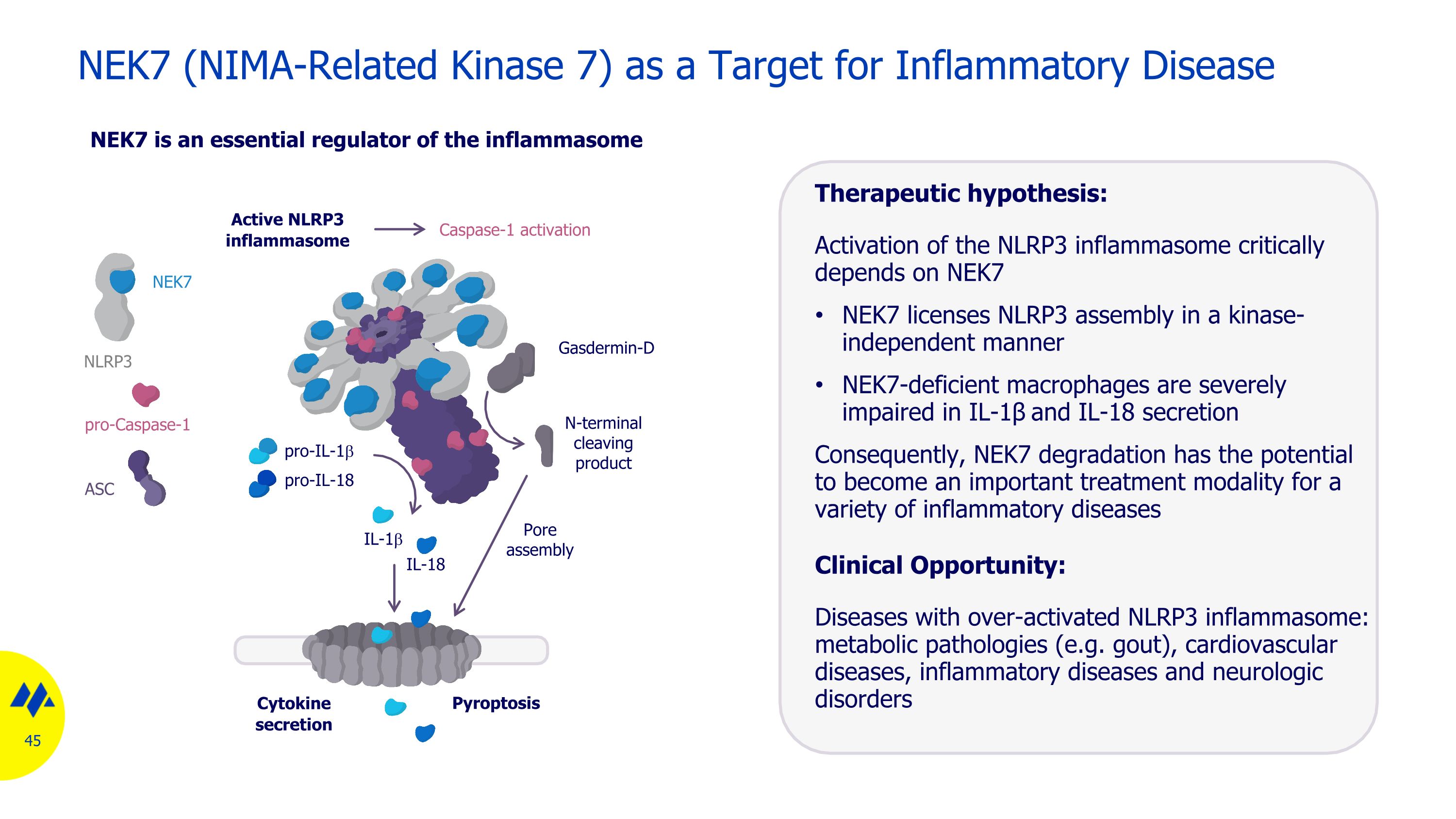
NEK7 (NIMA-Related Kinase 7) as a Target for Inflammatory Disease NEK7 is an essential regulator of the inflammasome Therapeutic hypothesis: Activation of the NLRP3 inflammasome critically depends on NEK7 NEK7 licenses NLRP3 assembly in a kinase-independent manner NEK7-deficient macrophages are severely impaired in IL-1β and IL-18 secretion Consequently, NEK7 degradation has the potential to become an important treatment modality for a variety of inflammatory diseases Clinical Opportunity: Diseases with over-activated NLRP3 inflammasome: metabolic pathologies (e.g. gout), cardiovascular diseases, inflammatory diseases and neurologic disorders Active NLRP3 inflammasome pro-IL-1b IL-1b Gasdermin-D N-terminal cleaving product Caspase-1 activation pro-IL-18 Cytokine secretion Pyroptosis pro-Caspase-1 NEK7 NLRP3 ASC IL-18 Pore assembly
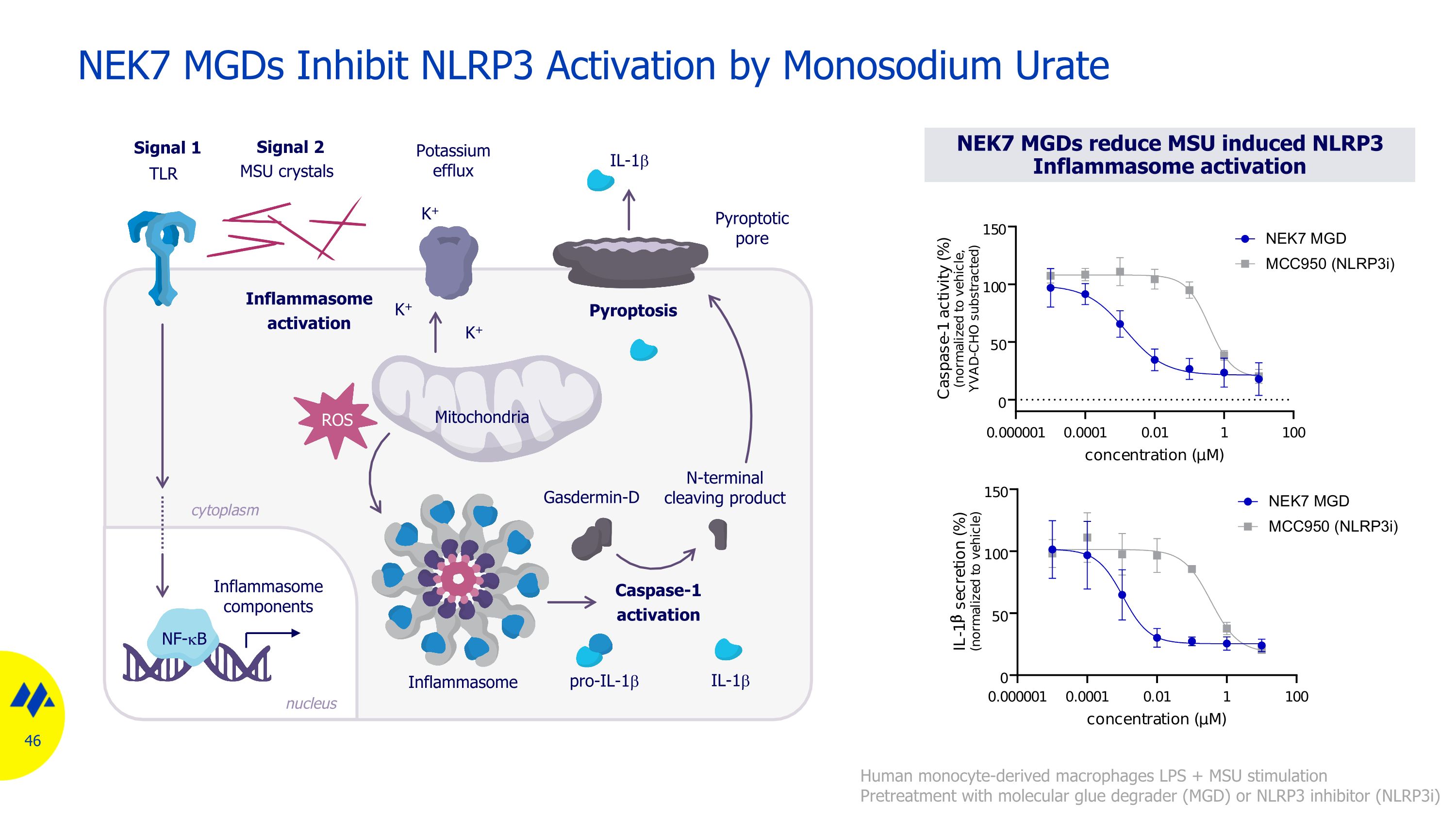
NEK7 MGDs Inhibit NLRP3 Activation by Monosodium Urate Human monocyte-derived macrophages LPS + MSU stimulation Pretreatment with molecular glue degrader (MGD) or NLRP3 inhibitor (NLRP3i) Signal 1 Signal 2 TLR MSU crystals Potassium efflux Pyroptotic pore IL-1b pro-IL-1b IL-1b K+ K+ K+ Gasdermin-D N-terminal cleaving product Inflammasome components Mitochondria Inflammasome NF-kB ROS Pyroptosis Inflammasome activation Caspase-1 activation nucleus cytoplasm NEK7 MGDs reduce MSU induced NLRP3 Inflammasome activation
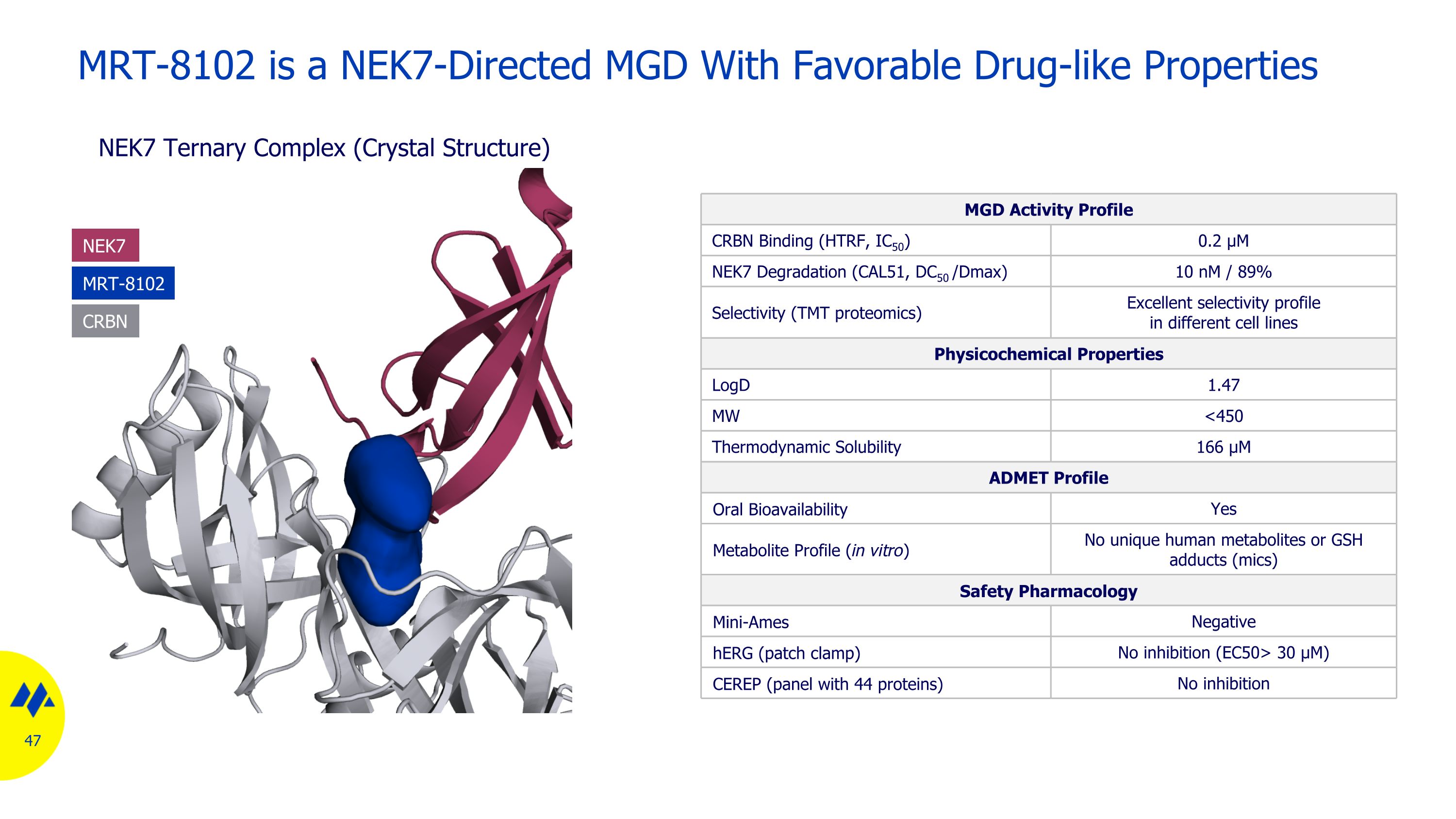
MRT-8102 is a NEK7-Directed MGD With Favorable Drug-like Properties MGD Activity Profile CRBN Binding (HTRF, IC50) 0.2 µM NEK7 Degradation (CAL51, DC50 /Dmax) 10 nM / 89% Selectivity (TMT proteomics) Excellent selectivity profile in different cell lines Physicochemical Properties LogD 1.47 MW <450 Thermodynamic Solubility 166 µM ADMET Profile Oral Bioavailability Yes Metabolite Profile (in vitro) No unique human metabolites or GSH adducts (mics) Safety Pharmacology Mini-Ames Negative hERG (patch clamp) No inhibition (EC50> 30 µM) CEREP (panel with 44 proteins) No inhibition NEK7 Ternary Complex (Crystal Structure) MRT-8102 NEK7 CRBN
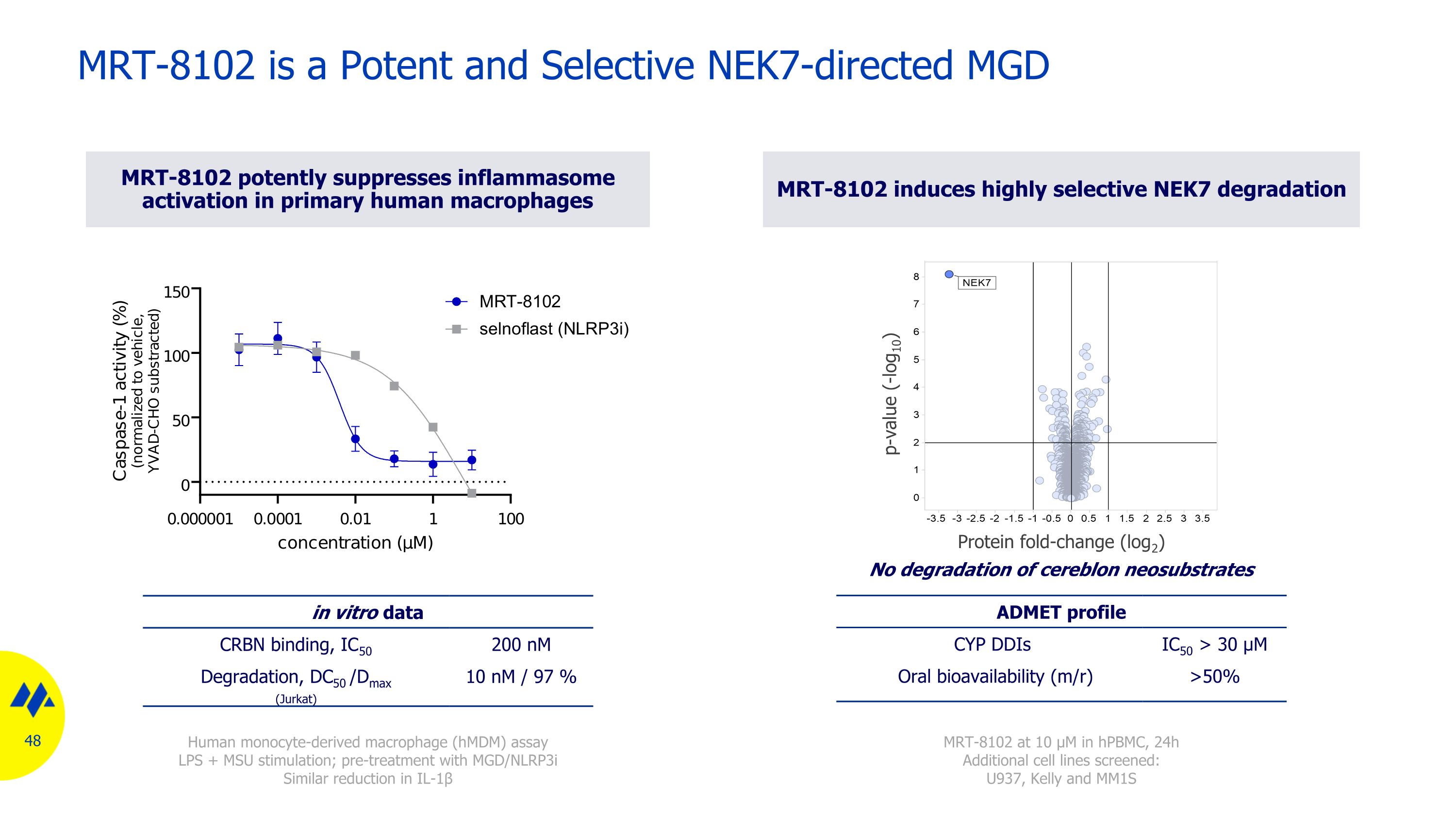
MRT-8102 potently suppresses inflammasome activation in primary human macrophages MRT-8102 induces highly selective NEK7 degradation p-value (-log10) Protein fold-change (log2) MRT-8102 at 10 µM in hPBMC, 24h Additional cell lines screened: U937, Kelly and MM1S Human monocyte-derived macrophage (hMDM) assay LPS + MSU stimulation; pre-treatment with MGD/NLRP3i Similar reduction in IL-1β MRT-8102 is a Potent and Selective NEK7-directed MGD in vitro data CRBN binding, IC50 200 nM Degradation, DC50 /Dmax (Jurkat) 10 nM / 97 % ADMET profile CYP DDIs IC50 > 30 µM Oral bioavailability (m/r) >50% No degradation of cereblon neosubstrates
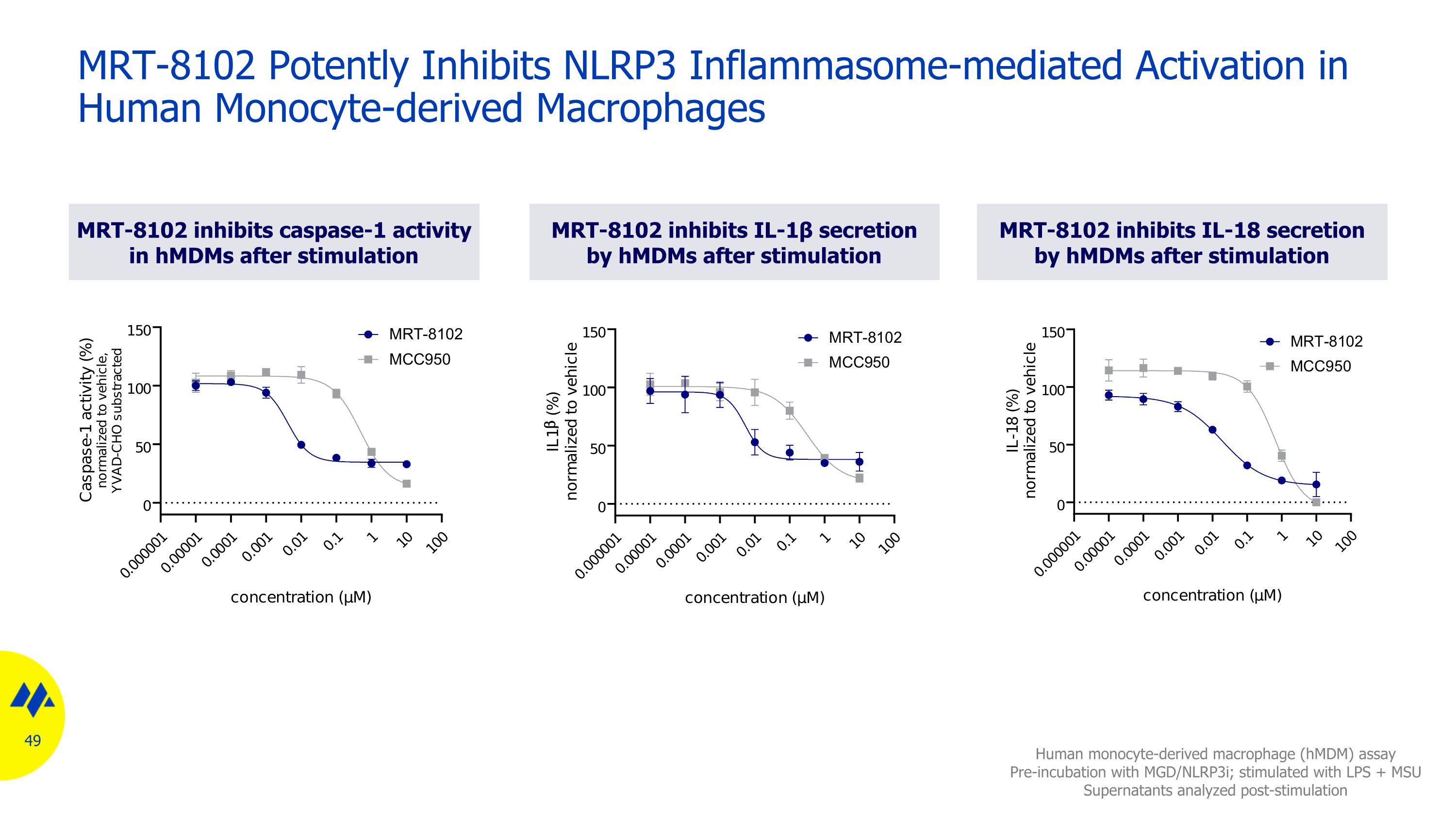
MRT-8102 inhibits caspase-1 activity in hMDMs after stimulation Human monocyte-derived macrophage (hMDM) assay Pre-incubation with MGD/NLRP3i; stimulated with LPS + MSU Supernatants analyzed post-stimulation MRT-8102 Potently Inhibits NLRP3 Inflammasome-mediated Activation in Human Monocyte-derived Macrophages MRT-8102 inhibits IL-1β secretion by hMDMs after stimulation MRT-8102 inhibits IL-18 secretion by hMDMs after stimulation
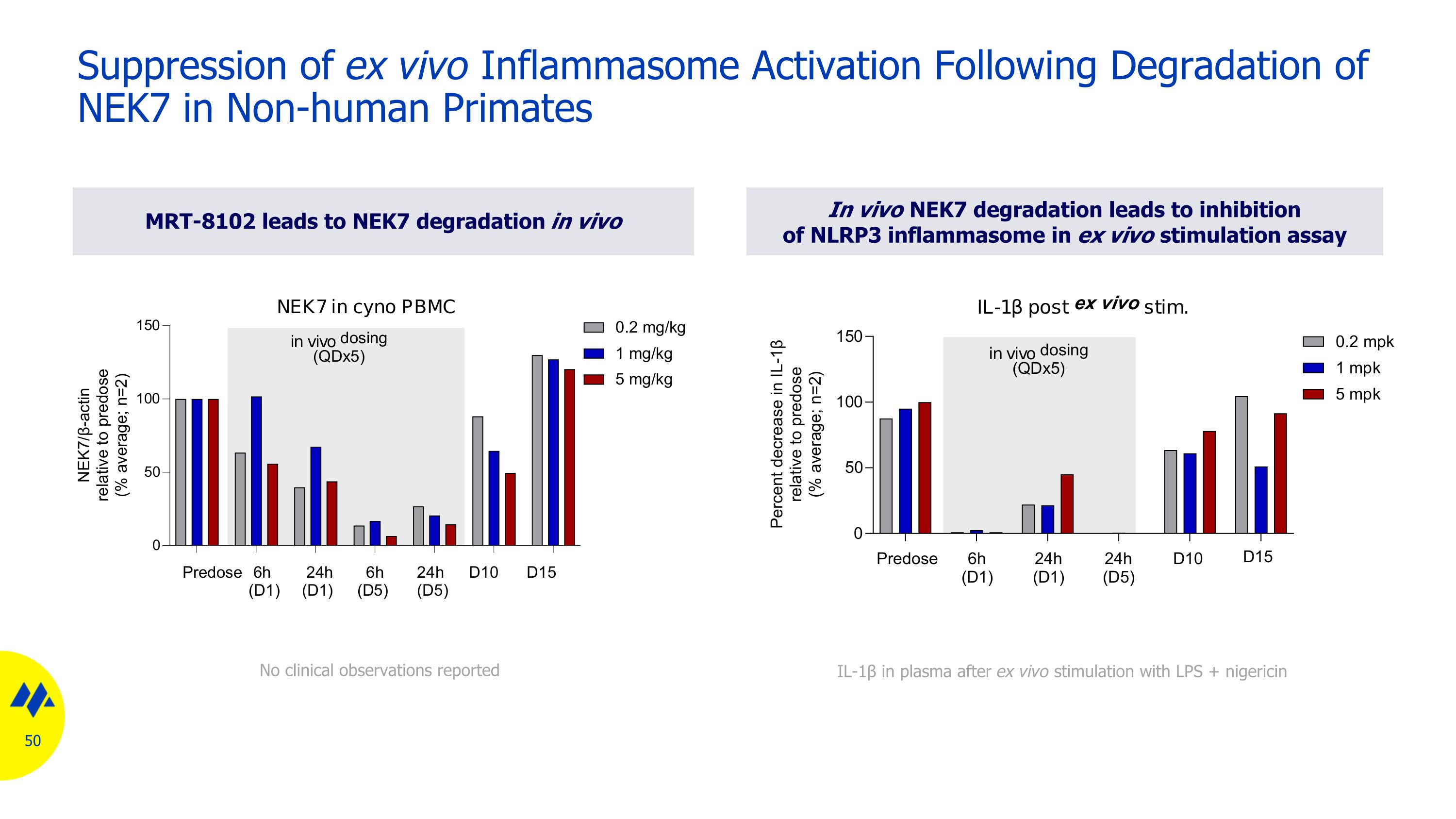
MRT-8102 leads to NEK7 degradation in vivo In vivo NEK7 degradation leads to inhibition of NLRP3 inflammasome in ex vivo stimulation assay Suppression of ex vivo Inflammasome Activation Following Degradation of NEK7 in Non-human Primates No clinical observations reported IL-1β in plasma after ex vivo stimulation with LPS + nigericin

Team
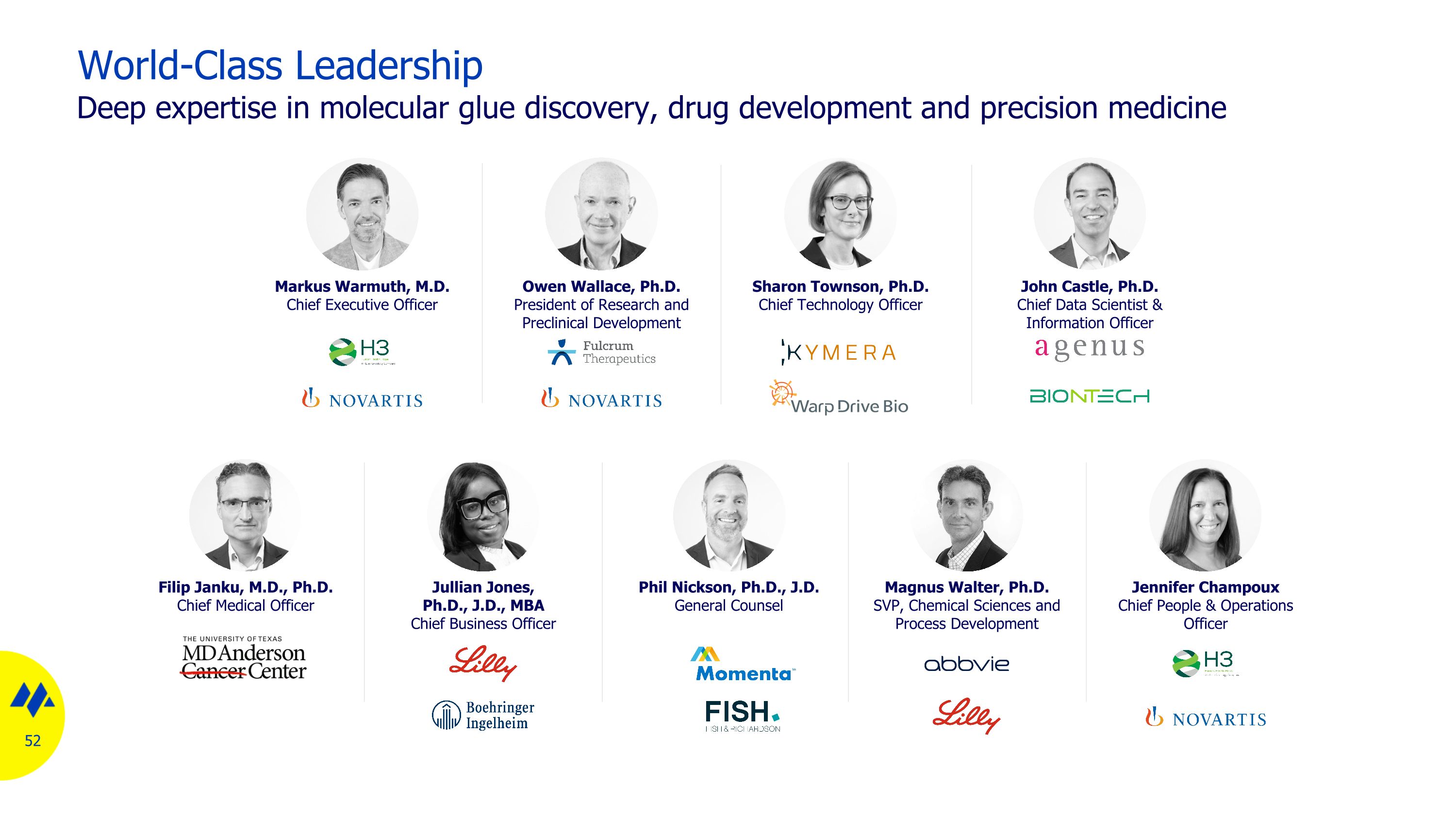
World-Class Leadership Deep expertise in molecular glue discovery, drug development and precision medicine Jullian Jones, �Ph.D., J.D., MBA Chief Business Officer Filip Janku, M.D., Ph.D. Chief Medical Officer Markus Warmuth, M.D. Chief Executive Officer John Castle, Ph.D. Chief Data Scientist & Information Officer Sharon Townson, Ph.D. Chief Technology Officer Owen Wallace, Ph.D. President of Research and Preclinical Development Phil Nickson, Ph.D., J.D. General Counsel Jennifer Champoux Chief People & Operations Officer Magnus Walter, Ph.D. SVP, Chemical Sciences and Process Development

Thank You
v3.23.4
Document And Entity Information
|
Jan. 08, 2024 |
| Cover [Abstract] |
|
| Amendment Flag |
false
|
| Entity Central Index Key |
0001826457
|
| Document Type |
8-K
|
| Document Period End Date |
Jan. 08, 2024
|
| Entity Registrant Name |
MONTE ROSA THERAPEUTICS, INC.
|
| Entity Incorporation, State or Country Code |
DE
|
| Entity File Number |
001-40522
|
| Entity Tax Identification Number |
84-3766197
|
| Entity Address, Address Line One |
321 Harrison Avenue
|
| Entity Address, Address Line Two |
Suite 900
|
| Entity Address, City or Town |
Boston
|
| Entity Address, State or Province |
MA
|
| Entity Address, Postal Zip Code |
02118
|
| City Area Code |
(617)
|
| Local Phone Number |
949-2643
|
| Written Communications |
false
|
| Soliciting Material |
false
|
| Pre-commencement Tender Offer |
false
|
| Pre-commencement Issuer Tender Offer |
false
|
| Title of 12(b) Security |
Common Stock, $0.0001 par value per share
|
| Trading Symbol |
GLUE
|
| Security Exchange Name |
NASDAQ
|
| Entity Emerging Growth Company |
true
|
| Entity Ex Transition Period |
false
|
| X |
- DefinitionBoolean flag that is true when the XBRL content amends previously-filed or accepted submission.
| Name: |
dei_AmendmentFlag |
| Namespace Prefix: |
dei_ |
| Data Type: |
xbrli:booleanItemType |
| Balance Type: |
na |
| Period Type: |
duration |
|
| X |
- DefinitionFor the EDGAR submission types of Form 8-K: the date of the report, the date of the earliest event reported; for the EDGAR submission types of Form N-1A: the filing date; for all other submission types: the end of the reporting or transition period. The format of the date is YYYY-MM-DD.
| Name: |
dei_DocumentPeriodEndDate |
| Namespace Prefix: |
dei_ |
| Data Type: |
xbrli:dateItemType |
| Balance Type: |
na |
| Period Type: |
duration |
|
| X |
- DefinitionThe type of document being provided (such as 10-K, 10-Q, 485BPOS, etc). The document type is limited to the same value as the supporting SEC submission type, or the word 'Other'.
| Name: |
dei_DocumentType |
| Namespace Prefix: |
dei_ |
| Data Type: |
dei:submissionTypeItemType |
| Balance Type: |
na |
| Period Type: |
duration |
|
| X |
- DefinitionAddress Line 1 such as Attn, Building Name, Street Name
| Name: |
dei_EntityAddressAddressLine1 |
| Namespace Prefix: |
dei_ |
| Data Type: |
xbrli:normalizedStringItemType |
| Balance Type: |
na |
| Period Type: |
duration |
|
| X |
- DefinitionAddress Line 2 such as Street or Suite number
| Name: |
dei_EntityAddressAddressLine2 |
| Namespace Prefix: |
dei_ |
| Data Type: |
xbrli:normalizedStringItemType |
| Balance Type: |
na |
| Period Type: |
duration |
|
| X |
- Definition
+ References
+ Details
| Name: |
dei_EntityAddressCityOrTown |
| Namespace Prefix: |
dei_ |
| Data Type: |
xbrli:normalizedStringItemType |
| Balance Type: |
na |
| Period Type: |
duration |
|
| X |
- DefinitionCode for the postal or zip code
| Name: |
dei_EntityAddressPostalZipCode |
| Namespace Prefix: |
dei_ |
| Data Type: |
xbrli:normalizedStringItemType |
| Balance Type: |
na |
| Period Type: |
duration |
|
| X |
- DefinitionName of the state or province.
| Name: |
dei_EntityAddressStateOrProvince |
| Namespace Prefix: |
dei_ |
| Data Type: |
dei:stateOrProvinceItemType |
| Balance Type: |
na |
| Period Type: |
duration |
|
| X |
- DefinitionA unique 10-digit SEC-issued value to identify entities that have filed disclosures with the SEC. It is commonly abbreviated as CIK. Reference 1: http://www.xbrl.org/2003/role/presentationRef
-Publisher SEC
-Name Exchange Act
-Number 240
-Section 12
-Subsection b-2
| Name: |
dei_EntityCentralIndexKey |
| Namespace Prefix: |
dei_ |
| Data Type: |
dei:centralIndexKeyItemType |
| Balance Type: |
na |
| Period Type: |
duration |
|
| X |
- DefinitionIndicate if registrant meets the emerging growth company criteria. Reference 1: http://www.xbrl.org/2003/role/presentationRef
-Publisher SEC
-Name Exchange Act
-Number 240
-Section 12
-Subsection b-2
| Name: |
dei_EntityEmergingGrowthCompany |
| Namespace Prefix: |
dei_ |
| Data Type: |
xbrli:booleanItemType |
| Balance Type: |
na |
| Period Type: |
duration |
|
| X |
- DefinitionCommission file number. The field allows up to 17 characters. The prefix may contain 1-3 digits, the sequence number may contain 1-8 digits, the optional suffix may contain 1-4 characters, and the fields are separated with a hyphen.
| Name: |
dei_EntityFileNumber |
| Namespace Prefix: |
dei_ |
| Data Type: |
dei:fileNumberItemType |
| Balance Type: |
na |
| Period Type: |
duration |
|
| X |
- DefinitionTwo-character EDGAR code representing the state or country of incorporation.
| Name: |
dei_EntityIncorporationStateCountryCode |
| Namespace Prefix: |
dei_ |
| Data Type: |
dei:edgarStateCountryItemType |
| Balance Type: |
na |
| Period Type: |
duration |
|
| X |
- DefinitionThe exact name of the entity filing the report as specified in its charter, which is required by forms filed with the SEC. Reference 1: http://www.xbrl.org/2003/role/presentationRef
-Publisher SEC
-Name Exchange Act
-Number 240
-Section 12
-Subsection b-2
| Name: |
dei_EntityRegistrantName |
| Namespace Prefix: |
dei_ |
| Data Type: |
xbrli:normalizedStringItemType |
| Balance Type: |
na |
| Period Type: |
duration |
|
| X |
- DefinitionThe Tax Identification Number (TIN), also known as an Employer Identification Number (EIN), is a unique 9-digit value assigned by the IRS. Reference 1: http://www.xbrl.org/2003/role/presentationRef
-Publisher SEC
-Name Exchange Act
-Number 240
-Section 12
-Subsection b-2
| Name: |
dei_EntityTaxIdentificationNumber |
| Namespace Prefix: |
dei_ |
| Data Type: |
dei:employerIdItemType |
| Balance Type: |
na |
| Period Type: |
duration |
|
| X |
- DefinitionLocal phone number for entity.
| Name: |
dei_LocalPhoneNumber |
| Namespace Prefix: |
dei_ |
| Data Type: |
xbrli:normalizedStringItemType |
| Balance Type: |
na |
| Period Type: |
duration |
|
| X |
- DefinitionBoolean flag that is true when the Form 8-K filing is intended to satisfy the filing obligation of the registrant as pre-commencement communications pursuant to Rule 13e-4(c) under the Exchange Act. Reference 1: http://www.xbrl.org/2003/role/presentationRef
-Publisher SEC
-Name Exchange Act
-Number 240
-Section 13e
-Subsection 4c
| Name: |
dei_PreCommencementIssuerTenderOffer |
| Namespace Prefix: |
dei_ |
| Data Type: |
xbrli:booleanItemType |
| Balance Type: |
na |
| Period Type: |
duration |
|
| X |
- DefinitionBoolean flag that is true when the Form 8-K filing is intended to satisfy the filing obligation of the registrant as pre-commencement communications pursuant to Rule 14d-2(b) under the Exchange Act. Reference 1: http://www.xbrl.org/2003/role/presentationRef
-Publisher SEC
-Name Exchange Act
-Number 240
-Section 14d
-Subsection 2b
| Name: |
dei_PreCommencementTenderOffer |
| Namespace Prefix: |
dei_ |
| Data Type: |
xbrli:booleanItemType |
| Balance Type: |
na |
| Period Type: |
duration |
|
| X |
- DefinitionTitle of a 12(b) registered security. Reference 1: http://www.xbrl.org/2003/role/presentationRef
-Publisher SEC
-Name Exchange Act
-Number 240
-Section 12
-Subsection b
| Name: |
dei_Security12bTitle |
| Namespace Prefix: |
dei_ |
| Data Type: |
dei:securityTitleItemType |
| Balance Type: |
na |
| Period Type: |
duration |
|
| X |
- DefinitionName of the Exchange on which a security is registered. Reference 1: http://www.xbrl.org/2003/role/presentationRef
-Publisher SEC
-Name Exchange Act
-Number 240
-Section 12
-Subsection d1-1
| Name: |
dei_SecurityExchangeName |
| Namespace Prefix: |
dei_ |
| Data Type: |
dei:edgarExchangeCodeItemType |
| Balance Type: |
na |
| Period Type: |
duration |
|
| X |
- DefinitionBoolean flag that is true when the Form 8-K filing is intended to satisfy the filing obligation of the registrant as soliciting material pursuant to Rule 14a-12 under the Exchange Act. Reference 1: http://www.xbrl.org/2003/role/presentationRef
-Publisher SEC
-Name Exchange Act
-Section 14a
-Number 240
-Subsection 12
| Name: |
dei_SolicitingMaterial |
| Namespace Prefix: |
dei_ |
| Data Type: |
xbrli:booleanItemType |
| Balance Type: |
na |
| Period Type: |
duration |
|
| X |
- DefinitionTrading symbol of an instrument as listed on an exchange.
| Name: |
dei_TradingSymbol |
| Namespace Prefix: |
dei_ |
| Data Type: |
dei:tradingSymbolItemType |
| Balance Type: |
na |
| Period Type: |
duration |
|
| X |
- DefinitionBoolean flag that is true when the Form 8-K filing is intended to satisfy the filing obligation of the registrant as written communications pursuant to Rule 425 under the Securities Act. Reference 1: http://www.xbrl.org/2003/role/presentationRef
-Publisher SEC
-Name Securities Act
-Number 230
-Section 425
| Name: |
dei_WrittenCommunications |
| Namespace Prefix: |
dei_ |
| Data Type: |
xbrli:booleanItemType |
| Balance Type: |
na |
| Period Type: |
duration |
|
Monte Rosa Therapeutics (NASDAQ:GLUE)
Historical Stock Chart
From Mar 2024 to Apr 2024
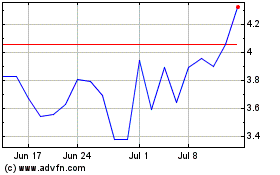
Monte Rosa Therapeutics (NASDAQ:GLUE)
Historical Stock Chart
From Apr 2023 to Apr 2024
